
Volume 1 | Edition 1 June 1, 2024


1 Salient Identity Development & Expression Among Diverse Adopted Adolescents
Simon Boone & Dr. Rachel H. Farr 27 The Fall of Enicidem - A Fairytale & Satire of America’s Response to the Opioid Epidemic
Sophie Wingo & Dr. Anna Brzyski 15 “Terror had exterminated all the sentiments of nature”: Disease and Disruption in Charles Brockden Brown’s
Arthur Mervyn; or, Memoirs of the Year 1793 and the Pandemic Fiction Novel
Riley Droppleman & Dr. Michelle Sizemore
Caroline Youdes & Dr. Anthony Bardo 33 The Persistence of Memory in Other Mediums: Creating a Digital Audio Archive of Anastasia Tsvetaeva
Johnna Warkentine & Dr. Molly T. Blasing
Samuel LeRose & Dr. Christopher
Tobacco Farming in Appalachia and Demon Copperhead
Joshua Hinton & Dr. Michelle Sizemore 51 “You ought to see the corridas!”: Normalizing the Franco Regime in the 1960s through Tourism Promotion
61
Design and Implementation of Digital Logic Filtration on Open-Source Field-Programmable Gate Arrays
Crawford
73
OF CONTENTS
TABLE

LETTER FROM THE EDITORS


The University of Kentucky is home to immensely diverse, richly creative, and crucially important research. The undergraduates at the University of Kentucky have continually showcased intense dedication to their respective projects, working tirelessly to advance their elds.
Aperture arose as a way to showcase this rich scholarship. Aperture was founded as a student-run, peer- and expert- reviewed journal that would allow undergraduates across the university an accessible means to publish their work. The rst Aperture meeting took place on June 6, 2023, and was attended by Ashbey Manning, Megan Johnston, Abraham Alhamdani, Diksha Satish, and the incredible O ce of Undergraduate Research sta , Jesi Bowman and Haven Patrick. Throughout the months that followed, the team continued to grow and a true team began to form. Today, the journal has two co-Editors-in-Chief, four committees, four committee chairs, and eighteen committee members.
The rst edition of Aperture includes work in American Literature, Physics, Counseling Psychology, Creative Writing, Modern and Classical Languages, and Retailing and Tourism Management. The wide range of disciplines available in this edition re ect the exact vision held by the original founding team.
We are incredibly thankful for the committee chairs and members, students who took the time to submit their work, the mentors who supported their undergraduate researchers throughout their journey, and the experts who stepped in to review the work presented here.
It is an immense pleasure to present to you the rst edition of Aperture.


APERTURE TEAM

Ashbey Manning

Kenan Flores
Design Chair Co-Founder



Megan Johnston Editor in Chief Co-Founder
Gretchen Ruschman Editorial Co-Chair Co-Founder
Abraham Alhamdani
Marketing Chair Co-Founder

Diksha Satish Editorial Co-Chair Co-Founder

Riley Droppleman
Publication Chair

Sai Yalla Secretary Co-Founder
6







Publication and Production Committee



Marketing and Outreach Committee




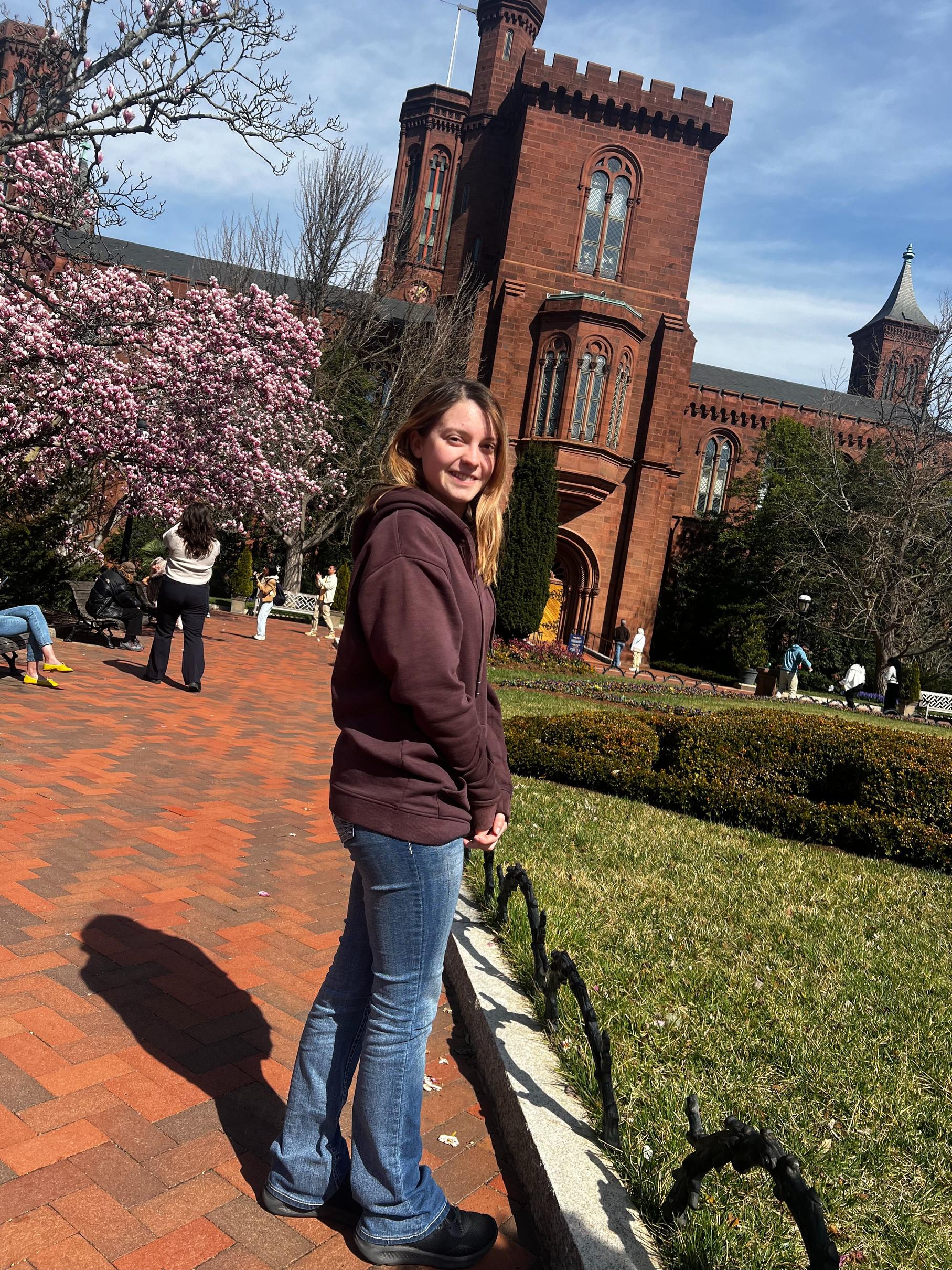

Editorial Review Committee
Simon Aaronson
Cailin McDonald
Jai
Safiyah Ashe Mill
Kasey Montgomery
Natalie Lewis
Lynzi Huggett
Anna Schroll
Gracie Burrows
Jordan Berezowitz
Caleb Weber Dexter Vilt
Alaina Taul
Elizabeth Elliott
Jaesylin Stephens
TYPING THE SELF-REPORTED, SALIENT IDENTITIES ADOPTED ADOLESCENT

1
SELF-REPORTED, IDENTITIES OF DIVERSE, ADOLESCENT
SIMON BOONE
Simon T.A. Boone is a recent graduate of the University of Kentucky with a Bachelor of Arts degree in Psychology and a Certificate in Social Science Research. He is a native of Maysville, KY and enjoys playing video games, making art, listening to metal music, and watching horror movies in his free time. Simon was a research assistant in Dr. Rachel Farr’s Families, Adoption, and Diversity (FAD) Lab since 2021. He is passionate about research regarding LGBTQ+ identity development during adolescence, identity labeling, and transgender parenthood. He is a UK Summer Undergraduate Research Fund (SURF) and APA Summer Undergraduate Psychology Experience in Research (SUPER) fellow. He also served on the logistics committee for the 2023 Midwest Bisexual Lesbian Gay Transgender Asexual College Conference (MBLGTACC). Before attending graduate school, Simon is continuing independent research involving LGBTQ+ self-labeling. He also looks forward to being a camp counselor at Camp Lilac, a summer camp celebrating gender-diverse youth.
2
Identities of Diverse, Adopted Adolescents
Simon T.A. Boone & Dr. Rachel H. Farr Department of Psychology, University of Kentucky
ABSTRACT
Throughout the lifespan, identity is a malleable but salient aspect to development. Particularly in adolescence, valuable identities help determine social groups, acceptance, and family closeness. However, identity development during this period has not been extensively investigated in adoptive adolescents or adoptive adolescents with LGBTQ+ parents, who may have differing environmental factors that encourage and/or weaken this development. Determining the types of identities that adolescents in these populations use strengthens the investigation of sourcing these determinants. Using interview data from the third wave of an ongoing longitudinal study [REDACTED] based in the United States, central identities were described by 10 adolescents, ranging from 15-19 years old. These were distinguished by four categories: Demographic, Interest, Personality, and Other Demographic identities were the most prevalent (n = 6), followed by Interest (n = 4), Personality (n = 2), and Other (n = 2). Participants could list several identities and thus were categorized into multiple identity types. Participants with Other identities, however, seemed unsure how to answer and were not classified further. 60% did not consider their adoption status to be salient and out of the 6 adolescents with LGBTQ+ parents, 83.33% (n = 5) agreed that their parents’ LGBTQ+ identities were salient to themselves. Identity labeling amongst this sample was similar to patterns in non-minoritized and non-adopted adolescents. Future studies should investigate the prevalence of these identity types in relation to how diverse adolescents define and understand identity, given implications for developmental theory, school settings, and clinical practice.
Keywords: adoption, adolescence, identity, diversity, LGBTQ+ parents
INTRODUCTION
Since the inception of Erik Erikson’s Stages of Development in 1950 (Erikson, 1950), developmental psychologists have been further developing foundational work based on periods across the lifespan. Individuals are composed of numerous identities, with a select few becoming especially salient (i.e. prominently expressed) due to their importance, impact, and intersectionality with other identities. This concept of identity centrality, developed by Hinton et al. (2022), is what allows adolescents to independently engage with activities, social groups, and influences that positively impact their experience with a particular identity. Because of this, identity becomes more salient and valuable for individuals during adolescence, as these important influences impact their development into
adulthood and beyond (Branje et al., 2021; Erikson, 1980; Orenstein & Lewis, 2022). A core influence to identity development is one’s parents, who can pass down or model aspects of identity (Luyckx et al., 2015). Although parents’ sexuality does not appear to directly impact development (Farr, 2017; Wainwright et al., 2004), unique parenting styles and socialization as a result of same-sex, transracial, and/or adoptive family structures may stimulate diverse identity development (Watson et al., 2019). Investigative identity typing may indicate how that identity was formed and the social structures important to an adolescent if their parents are not found to be significantly impactful on the development of such an identity.
Specifically, we observe diverse and
3
Salient
Typing The Self-Reported,
adoptive identities as potential salient identities. In 1989, Kimberlé Crenshaw established the term intersectionality when discussing the interactions between race and gender (Crenshaw, 1989). Since then, expansive research has been performed examining the interactions between intersectional identities and the social attitudes that affirm or discriminate against these minoritized populations (Azmitia, 2023; Moffit et al., 2020; Pauker et al., 2018). In adoptive families, multiple intersections commonly present themselves, including race and sexuality in transracial adoptions and same-sex parent adoptions respectively (Barn, 2018; Goldberg, 2023).
Hal Grotevant and Lynn Von Korff (2011) examined identity through the lens of adoption, providing comparisons across all of the types of adoption, as well as interceptive strategies in the case that identity development is stagnant because of adoption status. They found that there were “highly varied identity narratives among adoptees, even within gender and age groups,” indicating that research with these individuals must be intentionally specific, as it seems that adoption status is not indicative of the development of other identities on its own.as these important influences impact their development into adulthood and beyond (Branje et al., 2021; Erikson, 1980; Orenstein & Lewis, 2022). A core influence to identity development is one’s parents, who can pass down or model aspects of identity (Luyckx et al., 2015). Although parents’ sexuality does not appear to directly impact development (Farr, 2017; Wainwright et al., 2004), unique parenting styles and socialization as a result of same-sex, transracial, and/or adoptive family structures may stimulate diverse identity development (Watson et al., 2019). Investigative identity typing may indicate how that identity was formed and the social structures important to an adolescent if their parents are not found to be significantly impactful on the development of such an identity.
THEORETICAL FRAMEWORK
Erikson’s Stages of Psychosocial Development
In 1950, Erik Erikson published Childhood and Society, in which the chapter “Eight Stages of Man,” first outlined what came to be later known as Erikson’s Stages of Psychosocial Development. He described the fifth stage with the virtue of “fidelity,” in which adolescents either fulfill their identity development milestones or falter, leading to “role confusion.” Later, in 1968 and 1980, identity was explored in depth at both the adolescent stage and across the lifespan in Identity, youth, and crisis and Identity and the Life Cycle, respectively (Erikson, 1968; 1980). Under his theory, it is expected that the adolescent moves on to the next stage, early adulthood, where love is the intended developmental milestone if they have surpassed their “identity crisis.” These stages are dependent on each other in order to thrive in society.
Regarding modern views of fidelity, there have been correlations associated with societal trajectories related with fulfillment or crisis (Brittian & Lerner, 2013). Successful attainment of identity corresponded with positive psychosocial and behavioral characteristics and crisis corresponded with negative psychosocial and behavioral trajectories. However, there has not been strong methodological research examining the influences of these outcomes, especially in adoptive or LGBTQ+ families. We aim to categorize identity types in order to simplify the process of determining such influences. Such work has been previously conducted in a specific manner, investigating gender (Menon et. al, 2013) and personality (Luyckx et. al, 2014) but not the mechanisms of how these interact with identities of other types.
CURRENT STUDY METHOD
Participants
Adolescents were sampled from a larger, ongoing longitudinal study [REDACTED], where families and their adopted adolescent were interviewed on various subjects related to family, community belongingness, and social support. 10 participants were chosen because their interviews had been completed and transcribed in sync with this study. Mean
4
Typing The Self-Reported, Salient Identities of Diverse, Adopted Adolescents
Procedure age was 16.4 (SD = 1.66; range 15-19). 50% (n = 5) identified as male, 40% (n = 4) identified as female, and 10% (n = 1) was classified as “gender expansive.” 70% (n = 7) of the adolescents identified as the same race as both of their parents and 30% (n = 3) identified as a different race than their parents (i.e., transracial). 40% (n = 4) of the adolescents were in two-mom families, 20% (n = 2) were in twodad families, and 40% (n = 4) were in momdad families. Of the 8 (80%) participants that disclosed their sexual identities, 3 (30%) identified as heterosexual, 2 (20%) identified as bisexual, one (10%) identified as pansexual, one (10%) identified as queer, and one (10%) was self-described [Table 1].
One-hour (approximated) interviews were originally conducted via phone call or Zoom with adopted adolescents between the ages of 13 and 19, as well as their parents, as a part of a longitudinal study [REDACTED]. This study is in its third wave and is still ongoing, with data in this report being a sample. Adolescents were asked as a part of their interviews, “If you had to describe yourself to someone else, using any core identities to who you are, what would those be?” The answers to this particular question were the basis for identity classification. Identities were then classified by a three-party coding team into one of four types: Demographic, Interest, Personality, or Other [Table 2]. Additionally, participants were asked if being adopted and if having LGBTQ+ parents (where applicable) was factored into or one of their core identities [Table 2, 3]. Complete responses to these three questions are documented in Appendix A, B, and C respectively.
Identity Coding
Over a period of three months, the authors and a team of undergraduate research assistants in the University of Kentucky’s Families, Adoption, and Diversity Lab read and coded the transcribed interviews of the participants. We use thematic analysis (Braun & Clarke, 2006) to examine identity integration and perception among diverse adolescents (i.e., adoption, race, family structure, etc.) and the implications of its self-identification.
Codes were developed using the frameworks of identity centrality and labeling, as well as the following developed identity types. Our team utilized all parts of the interview for this coding but focused on the aforementioned questions regarding core identities, adoption, and LGBTQ+ parents. The names used in our data and results were also converted to pseudonyms in order to protect the identities of our participants.
Demographic identities are defined by Hays (2016), in which they describe culturally important and intersectional influences that compose the full person. Specifically, they refer to age, developmental or acquired disabilities, religion or spiritual orientation, race, ethnicity, socioeconomic status, sexual orientation, indigenous heritage, national origin, and/or gender, although demographic data is not limited to these descriptors.
Interest consists of intentional reengagement of activities with or without advantage (Hidi & Renninger, 2006). These can be either situational interest, in which attention and effort is centered on an object or topic or individual interest, the predisposition to reengage. For the purposes of this study, we will focus on individual interest, as it more closely relates to identity presentation and development. Finally, Personality has been classified as longitudinal characteristics that are dependent on adjustment, or the lack thereof (American Psychological Association, 2018). Even though these are considered to be long-term descriptors, they are still subject to change over the course of development, particularly in the transition from childhood to adolescence (Caspi et al., 2005). More often than not, these are traits that are assigned to an individual, rather than self-perceived. Given the popularization of personality tests such as the Myers-Briggs Type Indicator (MBTI), Enneagram, The Big Five, and HEXACO, there is an increasing reliance on using personality to determine “the whole package” of an individual (Ashton & Lee, 2007; John et al, 2008). However, some of these assessments have consistently been reported to be more reliable than others (Hook et al., 2020; Stein & Swan, 2019).
For answers unable to be classified into
5
one of these three identity types, they are categorized as Other. Typically, these are answers signifying uncertainty.
RESULTS
Demographic Identity Type
A majority of our sample, 60% (n = 6), listed one or more identities that could be categorized under the Demographic identity type. Common traits included gender (n = 3) (ex., “Cis[gender] female,” Maya, 18, female, white, two-mom family), sexuality (n = 2) (ex., “Bisexual,” Katie, 17, female, white, two-mom family), and religion (n = 4) (ex., “Seventh Day Adventist,” Charlotte, 15, female, Black, momdad family).
Interest Identity Type
Of our sample, 40% (n = 4) of our sample listed one or more identities that could be categorized under the Interest identity type.
Arthur (19, male, multiracial, mom-dad family) reasoned his interest in learning, the social sciences, and business:
“I love learning about random things, interesting things, the way other people think. I like learning [sic] the way things work. Really anything is something that I like to learn. So that’s driven a lot of the choices I’ve made have been [sic] because I wanted to know, basically I just want to know. So yeah, I mean that defines a lot – that covers a lot of who I am. I care a lot about other people. I care a lot about the way things work and the way things are and why we do things. Sociology interests me a lot, psychology interests me a lot. But the reason I’m in business is because I aspire to be the best version of myself. And with that skill set, and knowing how other people work, [it] makes the most sense for me to be in that situation.”
Arthur’s passion for learning has become an integral part of who he is and how he interacts with people, therefore distinguishing it as an identity that he holds dear.
Personality Identity Type
After classification, 20% (n = 2) of our sample listed one or more identities that could be categorized under the Personality identity type.
Researcher:
“If you had to describe yourself to somebody using your core identities, maybe religion, race, things like that, to who you are, what would those identities be?”
Cole (16, male, white, two-mom family):
“Agnostic and then just like full of energy, I guess.”
This answer reflects the Personality identity type because Cole’s identity of “full of energy” influences his relationships and his perception of himself.
Other Identity Type
Some participants did not list any discernible identities and were therefore classified as Other (20%; n = 2):
“I’m not really sure how to answer that [question],” Aaron (16, male, Black, twodad family).
Our interviewers assured participants that there were no wrong answers and that abstaining from the question wasn’t an issue.
Adoption Type
Many adolescents shared that since they were adopted at birth or at a relatively young age, they haven’t regularly thought about their relationship with their birth parents compared to their adoptive parents, often considering the latter to be the former. 60% (n = 6) explicitly stated that their adoption status was not a significant part of their identity.
Arthur (19, male, multiracial, mom-dad family) described his lack of acknowledgement of his adoption status:
“I don’t think about it. Pretty much ever. I was adopted when I was five days old, right? None of my core memories. Period. Basically, the only thing that ever happened between me and my birth parents was that when I was born, my birth mother asked to see me in the room, which is what I’ve been told. And then after that, my mom sent her update emails for a while. And then eventually, she stopped requesting them, and my mom stopped sending them. And, really, that’s it. So I don’t view my birth parents as my parents, I view my adoptive parents as my parents. And so for that reason, it doesn’t really bother me ever. It doesn’t, it doesn’t sit in my brain. I can forget about it
Typing The Self-Reported, Salient Identities of Diverse, Adopted Adolescents
6
for months at a time. And then one day happen to remember that I’m adopted.”
One participant, Rosanna (15, female, Black & white, two-mom family) remained neutral when asked, stating that she also forgets that she’s adopted and that she doesn’t think about it often:
“I mean, maybe, I don’t really think about it that much. Sometimes I kind of forget. It doesn’t really stay on my mind that much.”
The remaining 30% (n = 3) participants agreed that their adoption status played an important part in their life but shared the forgetful sentiments of Arthur and Rosanna:
“I mean, I don’t think about it too much, but yeah I guess it is,” Jack (15, male, white, mom-dad family).
Being the Child of LGBTQ+ Parents
Of the 6 adolescents with LGBTQ+ parents (e.g., two-mom family, two-dad family), 5 (83.33%) considered their parents’ relationship to be integral to their own identity [Table 4].
Maya (18, female, white, two-mom family) indicated the necessity of introducing her moms and how it influences her:
“It’s obviously something I have to deal with. But it’s not something I have to deal with always. It’s also my life, you know? Like, those are my parents, and it shouldn’t change things, but it does. And so, you know, having to have this bomb drop of telling someone new, ‘Oh, I have two moms.’ It’s a part of my personality that is strange that I have to announce and hope that people are okay with that, and have people not be okay with that.”
Alternatively, the adolescent that indicated that having LGBTQ+ parents was not important to their identity assured that it wasn’t important because there wasn’t that much of a difference (compared to nonLGBTQ+ parents).
Rosanna (15, female, Black & white, two-mom family) stated:
“I mean, to me, it’s not that important. Like, I don’t really see that much of a difference. I mean, obviously, there’s a difference, but like, I don’t really see it. Like, I’m just normal.”
DISCUSSION
Apart from their diverse family structures, these adolescents appear to present similar salient identity types and development compared to their peers (Lewis-Smith et al., 2021; Umaña-Taylor et al., 2014; Watson et al., 2019; Woolverton & Marks, 2023). That is, the types of identities are not reflective of adoptive or LGBTQ+-parent status. For adopted adolescents, biracial/bicultural identities with their birth parents and their adopted parents are commonly reflected (Manzi et al., 2014). Despite societal pressure to create hetero/gendernormative children (Lev, 2010), LGBTQ+ parents model an accepting environment for the development of diverse identities without necessarily creating one. In other words, LGBTQ+ parents communicate about identity with their children in a similar manner to non-LGBTQ+ parents but do not directly encourage certain identities (Simon & Farr, 2022). Parents, regardless of sexual and/or gender orientation, remain prominent societal paradigms for their children throughout the lifespan, even in the independently-driven stage of adolescence (Laursen & Collins, 2009).
Adolescents do indeed think of identity but not necessarily in terms of labels, as many questionnaires, studies, and social groups tend to assume (Porta et al., 2020). Instead, self-labeling, or the rejection of labels altogether, allows individuals with intersectional and/or diverse identities to better affirm their identities. This study supports the concept of identity typing, rather than labeling, to determine salient characteristics and their influences.
Limitations and Further Research
Our biggest limitation was sample size, as data in the [REDACTED] study is still being collected. Transcribing, coding, and composing data sets extends this timeline. Higher volumes of participants exceed the capacity of the FAD Lab and it is recommended that the duplication or expansion of these data sets be completed with adequate personnel. It should also be noted that as this research was conducted in the United States, western ideas and acceptance of identity cannot be generalized
7
all cultures.
For all identities unable to be categorized, they were placed into the Other category. It is recommended that future studies further distinguish emerging themes in this category, possibly negating its existence. For instance, responses that lack a distinguishable identity at all (e.g., “I don’t know,” “I’m not sure,” etc.) could be considered “No Response” instead. Quantitative methods, such as demographic collection via surveys, rather than open-ended interview questions, may also assist individuals who struggle to categorize their identity.
Pertaining to Erikson’s framework for adolescence (identity vs. role confusion), psychologist James Marcia further developed four stages that occur during this period: identity diffusion/confusion, foreclosure, moratorium, and achievement (Marcia, 1966; Yip, 2014). Perhaps dividing participant responses, based on the stage they are coded to be in based on other indicators (e.g., assurance, disclosure, comfort, etc. in their identity), can reveal patterns in the type of identities they represent. Discussions regarding adoption, identity, and having LGBTQ+ parents between the adolescents and their parents were acknowledged in the participant interviews, however, they were not explored through the lens of identity development. Future research into the intersection of identity type and parental identity modeling may reveal any correlation between frequency of communication regarding identity and the identities these adolescents choose to express.
Adoption status being majorly negated as a salient identity could be a product of the level of birth parent involvement, in which most participants considered to be minimal or absent. Studies involving close relationships with birth and adoptive parents are recommended to further inquire into this possibility.
Implications for Policy and Practice
As there were no patterns in identity typing within adolescents with LGBTQ+ parents and those with straight parents, this conclusion adds to the well-defined and growing literature highlighting the similarities between the two parent types. Typing can be an indicator of prioritizing factors that are salient to the
adolescent (e.g. salient Personality identities may be related to social group perception). This is reflected in the ecological systems of the adolescent and how they interact with or choose their peers (Brofenbrenner, 1994; Ragelienė, 2016).
The clinical aspect of identity factors into parental relationship building, based on communication, that can be beneficial to the overall wellbeing of an individual. Schachter & Ventura (2008) expand on this concept, describing parents as “identity agents,” in which parents intentionally interact with their children in order to encourage identity formation. Even if this is not the case, adolescents are more likely to approach their parents for complex conversations as opposed to their friends and peers, whom they discuss simple, everyday issues (Collins & Steinberg, 2006).
Conclusion
Although identity is something that can be discerned and categorized by research, it has been difficult to isolate predictors of salience, and in this case, type. Perhaps it is not expected that adolescents share a standard of identity but rather, environmental influences that encourage the exploration of Demographic, Personality, and Interest types. Parental identities are likely not relevant to the specific developmental framework of typing and are more aligned with how identity is discussed, if at all. Open communication between parent and child leads to more comfort in considering possible salient identities, in which they are validated and talked about in an impactful lens (i.e., how certain current events and/or environments impact the adolescent’s salient identities and vice versa)(Bhushan & Shirali, 1992; Sillars et al., 2006). Salient identity adoption is ever changing across the lifespan, developing more with insight and education that becomes increasingly prominent with maturity (Bowman & Safran, 2007). Typing, particularly within diverse populations, reveals an individual’s definition of a core identity and how that may influence their perception of other identities, whether they are visual or not.
Typing The Self-Reported, Salient Identities of Diverse, Adopted
8 to
Adolescents
ACKNOWLEDGEMENTS
The authors would like to thank the William T. Grant Foundation and the American Psychological Association for their supportive funding of this research. This study was also made possible by the coding and analytic efforts of graduate and undergraduate research personnel in the Families, Adoption, and Diversity Lab. Finally, we are grateful to the families in this study, particularly the adolescents who were willing to share their stories.
9
TABLE 1: ADOLESCENT DEMOGRAPHICS
*Note. The term “white” has been printed in lowercase, in the appropriate areas, in deference to those with minoritized racial and ethnic identities.
10
AGE M 16.4 1.66 SD Bisexual White* Two-Mom Same-race 2 6 4 7 1 2 2 3 1 2 4 3 2 1 20.0 60.0 40.0 70.0 10.0 20.0 20.0 30.0 10.0 20.0 40.0 30.0 20.0 10.0 Queer Multiracial Mom-Dad Undecided Pansexual Black Two-Dad Transracial Heterosexual Self-describe (i.e, “I don’t like labels. Men are pretty hot though.”)
/
ADOPTION TYPE ADOPTION TYPE n n % %
RACE
ETHNICITY
GENDER SEXUALITY n n n % % % Gender Expansive (i.e. “any pronouns”) 1 10.0 Male Female 5 4 50.0 40.0 Typing The Self-Reported, Salient Identities of Diverse, Adopted Adolescents
TABLE 2: ADOLESCENT SELF-IDENTIFICATION
IDENTITY TYPE DEFINITION EXEMPLAR QUOTE
Demographic n=6
Interest n=4
Personality n=2
Other n=2
An identifiable descriptor of age, developmental or acquired disabilities, religion or spiritual orientation, race, ethnicity, socioeconomic status, sexual orientation, indigenous heritage, national origin, and/or gender (Hays, 2016).
“The psychological state of engaging or the predisposition to reengage [sic] with particular classes of objects, events, or ideas over time”
(Hidi & Renninger, 2010, p. 111).
“The enduring configuration of characteristics and behavior that comprises an individual’s unique adjustment to life, including major traits, interests, drives, values, self-concept, abilities, and emotional patterns”
(American Psychological Association, 2018).
A salient identity not otherwise specified by a given classification or by the participant.
“I’m a cis female. I’m bisexual. I’m agnostic. And I guess white.”
Maya, 18, female, white, two-mom family
“I’m an artist, and I like cats, and I have a coffee addiction.”
Rosanna, 15, female, Black & white, two-mom family
“I’m kind of the jokester of the class. Funny, creative. Sometimes quiet. Yeah.” Chandler, 17, male, white, two-dad family
“I don’t know, [my identities] all seem so normal. I don’t really know.”
Jack, 15, male, white, momdad family
Note. All participant names are pseudonyms; demographic information is self-described.
11
TABLE 3: ADOPTION SALIENCE
ADOPTION AS A CORE IDENTITY STATUS
Present (n=3)
Absent (n=6)
Neutral (n=1)
EXPLANATORY QUOTE
“I mean, yeah. It’s just people: whenever I say, ‘oh, I’m adopted,’ they don’t really understand. It gets hard after a while to explain.”
Quinn, 16, gender expansive, white, momdad family
“No. I was adopted at birth and my parents have always loved me and supported me like any other parent, biological or otherwise, would. So to me, they’re my parents.”
Aaron, 16, male, Black, two-dad family
“I mean, maybe. I don’t really think about it that much. Sometimes I kind of forget. It doesn’t really stay on my mind that much.”
Rosanna, 15, female, Black & white, twomom family
Note. All participant names are pseudonyms; demographic information is self-described.
TABLE 4: LGBTQ+ PARENTS SALIENCE
HAVING LGBTQ+ PARENTS AS A CORE IDENTITY STATUS
Present (n=5)
Absent (n=1)
EXPLANATORY QUOTE
“For sure. I think that they have, you know, given me a lot of empathy for other people. I think they were part of my start to being interested in politics and social justice and issues of that sort.”
Katie, 17, female, white, two-mom family
“I mean, to me, it’s not that important. Like, I don’t really see that much of a difference. I mean, obviously, there’s a difference, but like, I don’t really see it. Like, I’m just normal.”
Rosanna, 15, female, Black & white, twomom family
Note. All participant names are pseudonyms; demographic information is self-described.
12
Typing The Self-Reported, Salient Identities of Diverse, Adopted Adolescents
REFERENCES
• American Psychological Association (2018, April 19). APA Dictionary of Psychology. American Psychological Association. https://dictionary.apa.org/ personality
• Ashton, M. C., & Lee, K. (2007). Empirical, theoretical, and practical advantages of the HEXACO model of personality structure. Personality and Social Psychology Review, 11(2), 150–166. https://doi. org/10.1177/1088868306294907
• Azmitia, M., Garcia Peraza, P. D., & Casanova, S. (2023). Social identities and intersectionality: A conversation about the what and the how of development. Annual Review of Developmental Psychology, 5(1), 169–191. https://doi.org/10.1146/ annurev-devpsych-120321-022756
• Barn, R. (2018). Transracial adoption: White American adoptive mothers’ constructions of social capital in raising their adopted children. Ethnic and Racial Studies, 41(14), 2522–2541. https://doi.org/10. 1080/01419870.2017.1384556
• Bhushan, R., & Shirali, K. A. (1992). Family types and communication with parents: A comparison of youth at different identity levels. Journal of Youth and Adolescence, 21(1), 687–697. https://doi.org/10.1007/ BF01538739
• Bowman, E. A., & Safran, J. D. (2007). An integrated developmental perspective on insight. In L. G. Castonguay & C. Hill (Eds.), Insight in psychotherapy (pp. 401–421). American Psychological Association. https://doi.org/10.1037/11532-019
• Branje, S., de Moor, E. L., Spitzer, J., & Becht, A. I. (2021). Dynamics of identity development in adolescence: A decade in review. Journal of Research on Adolescence, 31(4), 908–927. https://doi. org/10.1111/jora.12678
• Braun, V. & Clarke, V. (2006) Using thematic analysis in psychology. Qualitative Research in Psychology, 3(2), 77–101. https://doi. org/10.1191/1478088706qp063oa
• Brittian, A. S., & Lerner, R. M. (2013). Early influences and later outcomes associated with developmental trajectories of Eriksonian fidelity. Developmental psychology, 49(4), 722–735. https://doi. org/10.1037/a0028323
• Brofenbrenner, U. (1994) Ecological models of human development. In T. Husén & T. N. Postlethwaite (Eds.), International Encyclopedia of Education (2nd ed., Vol. 3, pp.37–43). Elsevier.
• Caspi, A., Roberts, B. W., & Shiner, R. L. (2005). Personality development: Stability and change. Annual Review of Psychology, 56(1), 453–484. https://doi. org/10.1146/annurev.psych.55.090902.141913
• Collins, W. A., & Steinberg, L. (2006). Adolescent Development in Interpersonal Context. In N. Eisenberg, W. Damon, & R. M. Lerner (Eds.), Handbook of child psychology: Social, emotional, and personality development (6th ed., pp. 1003–1067). John Wiley & Sons, Inc..
• Crenshaw, K. (1989) Demarginalizing the intersection of race and sex: A Black feminist critique of antidiscrimination doctrine, feminist theory and antiracist politics. University of Chicago Legal Forum, 4(1), 1–31.
• Erikson, E. H. (1950). Eight ages of man. In E. H. Erikson, Childhood and Society (pp. 247–274). W. W. Norton & Company.
• Erikson, E. H. (1968). Identity, youth, and crisis. W. W. Norton & Company.
• Erikson, E. H. (1980). Identity and the life cycle. W. W. Norton & Company.
• Farr, R. H. (2017). Does parental sexual orientation matter? A longitudinal follow-up of adoptive families with school-age children. Developmental Psychology, 53(2), 252–264. https://doi.org/10.1037/ dev0000228
• Goldberg, A. E. (2023). LGBTQ-parent families: Diversity, intersectionality, and social context. Current Opinion in Psychology, 49(1). https://doi. org/10.1016/j.copsyc.2022.101517
• Grotevant, H. D., & Von Korff, L. (2011). Adoptive identity. In S. J. Schwartz, K. Luyckx, & V. L. Vignoles (Eds.), Handbook of identity theory and research (pp. 585–601). Springer Science + Business Media. https://doi.org/10.1007/978-1-4419-7988-9_24
• Hays, P. A. (2016). The new reality: Diversity and complexity. In P. A. Hays, Addressing cultural complexities in practice: Assessment, diagnosis, and therapy (3rd ed., pp. 3–18). American Psychological Association. https://doi.org/10.1037/14801-001
• Hidi, S., & Renninger, K. A. (2006). The Four-Phase Model of interest development. Educational Psychologist, 41(2), 111–127. https://doi.org/10.1207/ s15326985ep4102_4
• Hinton, J. D. X., de la Piedad Garcia, X., Kaufmann, L. M., Koc, Y., & Anderson, J. R. (2022). A systematic and meta-analytic review of identity centrality among LGBTQ groups: An assessment of psychosocial correlates. Journal of Sex Research, 59(5), 568–586. https://doi.org/10.1080/00224499.2021 .1967849
• Hook, J. N., Hall, T. W., Davis, D. E., Van Tongeren, D. R., & Conner, M. (2021). The Enneagram: A systematic review of the literature and directions for future research. Journal of Clinical Psychology, 77(4), 865–883. https://doi.org/10.1002/jclp.23097
• John, O. P., Naumann, L. P., & Soto, C. J. (2008). Paradigm Shift to the Integrative Big-Five Trait Taxonomy: History. Measurement, and Conceptual Issues. In O. P. Johns, R. W. Robins, & L. A. Pervin (Eds.), Handbook of Personality: Theory and research (3rd ed., pp. 114–158). Guilford Press.
• Laursen, B., & Collins, W. A. (2009). Parent-child relationships during adolescence. In R. M. Lerner & L. Steinberg (Eds.), Handbook of adolescent psychol-
13
REFERENCES
ogy: Contextual influences on adolescent development (3rd ed., pp. 3–42). John Wiley & Sons, Inc.. https://doi.org/10.1002/9780470479193.adlpsy002002
• Lev, A. I. (2010) How queer! – The development of gender identity and sexual orientation in LGBTQ-headed families. Family Process, 49(3), 268–290. https:// doi.org/10.1111/j.1545-5300.2010.01323.x
• Lewis-Smith, I., Pass, L., & Reynolds, S. (2021). How adolescents understand their values: A qualitative study. Clinical Child Psychology and Psychiatry, 26(1), 231–242. https://doi. org/10.1177/1359104520964506
• Luyckx, K., Schwartz, S., J., Rassart, J., & Klimstra, T. A. (2016). Intergenerational associations linking identity styles and processes in adolescents and their parents. European Journal of Developmental Psychology, 13(1), 67–83. https://doi.org/10.1080 /17405629.2015.1066668
• Marcia, J. E. (1966). Development and validation of ego-identity status. Journal of Personality and Social Psychology, 3(5), 551–558. https://doi. org/10.1037/h0023281
• Moffitt, U., Juang, L. P., & Syed, M. (2020). Intersectionality and youth identity development research in Europe. Frontiers in Psychology, 11(1), 1–14. https://doi.org/10.3389/fpsyg.2020.00078
• Pauker, K., Meyers, C., Sanchez, D. T., Gaither, S. E., & Young, D. M. (2018). A review of multiracial malleability: Identity, categorization, and shifting racial attitudes. Social & Personality Psychology Compass, 12(6). https://doi.org/10.1111/spc3.12392
• Porta, C. M., Gower, A. L., Brown, C., Wood, B., & Eisenberg, M. E. (2020) Perceptions of sexual orientation and gender identity minority adolescents without labels. Western Journal of Nursing Research, 42(2), 81–89. https://doi. org/10.1177/019394591983
• Orenstein, G. A., & Lewis, L. (2022). Erikson’s Stages of Psychosocial Development. In StatPearls. StatPearls Publishing.
• Ragelienė, T. (2016). Links of adolescents identity development and relationship with peers: A systematic literature review. Journal of the Canadian Academy of Child and Adolescent Psychiatry / Journal de l’Academie canadienne de psychiatrie de l’enfant et de l’adolescent, 25(2), 97–105.
• Schachter, E. P., & Ventura, J. J. (2008) Identity agents: Parents as active and reflective participants in their children’s identity formation. Journal of Research on Adolescence, 18(3), 449–476. https:// doi.org/10.1111/j.1532-7795.2008.00567.x
• Simon, K. A., & Farr, R. H. (2022) Identity-based socialization and adopted children’s outcomes in lesbian, gay, and heterosexual parent families. Applied Developmental Science, 26(1), 155–175. https:// doi.org/10.1080/10888691.2020.1748030
• Stein, R., & Swan, A. B. (2019). Evaluating the validity of Myers-Briggs Type Indicator theory: A teaching tool and window into intuitive psychology. Social and Personality Psychology Compass, 13(2), 1–11. https://doi.org/10.1111/spc3.12434
• Umaña-Taylor, A. J., Quintana, S. M., Lee, R. M., Cross, W. E., Jr, Rivas-Drake, D., Schwartz, S. J., Syed, M., Yip, T., Seaton, E., & Ethnic and Racial Identity in the 21st Century Study Group (2014). Ethnic and racial identity during adolescence and into young adulthood: An integrated conceptualization. Child Development, 85(1), 21–39. https://doi. org/10.1111/cdev.12196
• Wainright, J. L., Russell, S. T., & Patterson, C. J. (2004). Psychosocial adjustment, school outcomes, and romantic relationships of adolescents with same-sex parents. Child Development, 75(6), 1886–1898. https://doi.org/10.1111/j.14678624.2004.00823.x
• Watson, R. J., Wheldon, C. W., & Puhl, R. M. (2019). Evidence of diverse identities in a large national sample of sexual and gender minority adolescents. Journal of Research on Adolescence, 30(52), 431–442. https://doi.org/10.1111/jora.12488
• Woolverton, G. A., & Marks, A. K. (2023). “I just check ‘other’”: Evidence to support expanding the measurement inclusivity and equity of ethnicity/ race and cultural identifications of U.S. adolescents. Cultural Diversity and Ethnic Minority Psychology, 29(1), 64–73. https://doi.org/10.1037/cdp0000360
• Yip, T. (2014). Ethnic identity in everyday life: The influence of identity development status. Child Development, 85(1), 205–219. https://doi.org/10.1111/ cdev.12107
14 Typing The Self-Reported, Salient Identities of Diverse, Adopted Adolescents
“TERROR HAD EXTERMINATED NATURE”: DISEASE AND DISRUPTION
DEN BROWN’S ARTHUR MERVYN: YEAR 1793 AND THE PANDEMIC

15
EXTERMINATED ALL THE SENTIMENTS OF DISRUPTION IN CHARLES BROCKMERVYN: OR MEMOIRS OF THE PANDEMIC FICTION NOVEL
RILEY DROPPLEMAN
Riley is a recent graduate from the University of Kentucky with degrees in Biology and English. She is a Chellgren Fellow, a Gaines Fellow, and a graduate of the Lewis Honors College. She also participated in undergraduate research as a research ambassador, sang in the UK Treble Choir and UK Chorale, and performed with UK Opera Theatre. She will attend DePaul University this fall on a graduate assistantship to pursue a master’s degree in literature and publishing. Eventually, she hopes to earn a PhD in English, perform research in Medical Humanities and American Literature, and become a university professor. Her Aperture submission is part of her Senior Gaines Thesis titled “Writing New Normals: A Study of American Pandemic Fiction in the Wake of COVID-19”.
16
“Terror had exterminated all the sentiments of nature”: Disease AND Disruption in Charles Brockden Brown’s Arthur Mervyn; or, Memoirs of the Year 1793 and the Pandemic Fiction Novel
Riley Droppleman & Dr. Michelle Sizemore
ABSTRACT
As the world pushes into another year of living in the wake of COVID-19, we all are learning how to heal from and interpret the experience of death on a massive scale. Throughout history, the devastation of war, genocide, and plague have left trauma spanning generations, and the artwork, literature, and movements that emerge from grief capture these moments of destruction and resilience. Charles Brockden Brown’s novel Arthur Mervyn; or, Memoirs of the Year 1793 (1799) provides a fictionalized account of the Yellow Fever outbreak in Philadelphia in 1793, which makes it one of the earliest examples of American plague fiction. This research, which acts as a small section of a larger senior thesis, aims to reveal Brown’s association between fear and the disease itself, which both spread through spaces quickly and devastatingly. With the aid of archival research performed at the Library Company of Philadelphia and the Historical Society of Pennsylvania, this research examines the effects of the plague on early American society both historically and literally. This study also emphasizes the destabilizing power of infectious diseases on urban spaces, and Brown chronicles the blurring of real-world boundaries through his fictional medium. Separation by race, class, and career disintegrates in times of crisis, and fear, rumor, and irrationality run rampant. The upheaval of society in the eyes of Brown rests on the ability of one to maintain reason, and his novel explores the perpetuity of fear as well as the impermanence of modern institutions in the face of disaster.
PANDEMIC LITERATURE: AN OVERVIEW
During the COVID-19 pandemic, we believed that the world was going through “unprecedented times”. Through the examination of previous pandemics and disease outbreaks, we can begin to visualize the commonalities between today’s human trauma and the traumas caused by diseases of the past. After four years since the pandemic started, the world is still recording new cases and deaths every day, and suddenly, we are thrust into what is likely the new “normal”. With loved ones and public figures falling ill, the COVID-19 pandemic has shaped, and is still shaping, the way we view life, the globe, science, and medicine; the tragedy and terror that accompany a disease on a large scale is difficult to quantify, but there are places we can look that give us a better idea of how humanity is coping with the effects of a
deadly disaster. Literature acts as a gauge for the sentiments of a certain period in history; from the political to the religious, authors have turned to the pen to not only comment on the events of their time but also to bring attention to aspects of their circumstances they wish to be changed. Times of universal hardship and struggle yield history’s seminal works of art, and pandemics and plagues have produced such novels.
The recent and current fight against the COVID-19 pandemic has already inspired numerous fiction novels about the effects of being quarantined in an unfamiliar place, like in Jodi Picoult’s Wish You Were Here, and the dynamics of being forced to stay at home while the world around transforms, as seen in Sarah Hall’s novel Burntcoat (Picoult, Hall). These
17
novels and many more present the production of literature as a natural reaction to a global disaster. The fiction novel allows for authors to express their perspectives on the effects of the pandemics as well as highlight any anxieties related to the experience of living through a time a fear. Popular media has presented the disastrous effects of deadly diseases spreading across the globe, with movies such as Contagion, 28 Days Later, and Outbreak visualizing the spreading of terror and the dismantling of society through storytelling (Contagion, 28 Days Later, Outbreak). The subject of disease and plague fascinates the human mind; its spread and devastation incite panic and leave humanity helpless. The thought of the transmission of something invisible to the eye, something floating in the air or living on surfaces, something that changes at such rapid speeds unfathomable in the scope of human evolution, presents a possible apocalypse to modern existence. From the Bubonic Plague of the Dark Ages to fictional zombie disease outbreaks, media across time presents these pandemics as some of the most terrifying threats to humanity.
The trend of writing fiction in the midst or wake of plagues is not a novel one. For this study, pandemic or plague fiction can be defined as fictional works that contain a contagious disease at the center of its plot, whether the disease itself is fictionalized or real. One of the earliest examples of the pandemic fiction novel is Daniel Defoe’s 1722 work A Journal of the Plague Year, which describes a man’s account of the Great Plague of London in 1665 (Defoe). First thought to be a work of nonfiction, Defoe’s novel is used as a model for the fictional witness account of real-life events. The novel has been analyzed to explain the behaviors of people, societies, and politicians during pandemics as they relate to COVID-19. An article written for Economic Inquiry describes the tendency for individuals’ behavior to become more extreme, social behavior to emphasize suspicion, blame, and othering, and officials responding to tragedy too late (Dasgupta). Albert Camus’s absurdist novel The Plague chronicles the transmission of the bubonic plague in Oran, Algeria, and the
novel’s sales only skyrocketed following the genesis of COVID-19 (Camus). Through his story, Camus reveals a pandemic’s “traumatic impact worldwide, and its interlocking with and intensification of class, racial and gender hierarchies and injustice,” which are common themes to be discussed in this paper (Kabel 4). Also, The Plague has been used to rationalize the current pandemic, with themes of “common humanity” and the idea that “COVID is a ‘great equaliser’” being at the forefront of literary discussion (Kabel 8). The importance of these novels lies in their defining of the genre of plague fiction, but their focuses remain in Europe, which produces most pandemic fiction, including German author Thomas Mann’s The Magic Mountain, whose focus on tuberculosis and isolation in sanatoriums makes it one of the most well-known works of plague fiction (Mann).
Conversely, American pandemic fiction novels are less well-known in the tradition. By analyzing works from the American plague literary canon, one can examine the unique American experience. From the effects of a pandemic on a newly established country to the continuing American imbalances among races and classes, plague fiction reveals aspects of American society that surface during times of disaster. One of the more famous American plague novels is Jack London’s The Scarlet Plague, which criticizes the capitalistic society of America as the downfall of the world (London). As stated by scholar Michele Riva, through his groundbreaking pandemic novel, London “used the plague topos to criticize contemporary social structure” to reveal that “the pandemic breaks the class barriers” (Riva et al. 1755). This study aims to focus in on institutions of American society that change and remain due to disease outbreaks throughout history. From the early years of the new republic to the contemporary times of COVID-19, American pandemic fiction reminds us that looking to the past can inform and validate our current experience, and they teach us how to continue living in a world that is forever changed. These seemingly “unprecedented times” can be compared to the literature of past pandemics, and these novels provide us
18
Disease and Disruption in Charles Brockden Brown
with patterns seen during times of trauma and disaster: the dismantling of class boundaries, the loss of entire generations, the burden of memory, the perpetuation of stereotypes, and the human need to survive.
ARTHUR MERVYN:
AN INTRODUCTION
When first meeting the titular character of Charles Brockden Brown’s Arthur Mervyn; or, Memoirs of the Year 1793, Dr. Stevens stumbles upon a fatigued young man, plagued by fever and a withered frame. Taking the infected Arthur Mervyn into his home, Dr. Stevens not only nurses the man back to health but also becomes audience to Mervyn’s life story. Through Dr. Stevens’ eyes, the reader slowly learns about the ravaging by yellow fever and corruption in 1793 Philadelphia. Mervyn’s journey from the rural environment in which he feels most comfortable to the great American city starts with his disenfranchisement at the hands of his father, whose passivity leads to his new, young wife forcing his son out of the house. Seeking work, Mervyn moves into the city, where his belongings are stolen, and his luck runs low. Following several odd encounters in Philadelphia, he is offered a position as a clerk under the supervision of a local merchant named Welbeck, whose suspicious nature and duplicitous demeanor led to a scandalous murder that Mervyn must help his employer cover up. Scarred from his experience in the city, Mervyn leaves Philadelphia and decides to work at the Hadwin residence. During this time, the yellow fever outbreak hits Philadelphia, and Mervyn must venture back into the city to find someone the Hadwin family is anxious to have home. The events that follow not only paint Philadelphia as a hellscape of disease, filth, and death but also inspire Mervyn to pursue medicine as a result of witnessing the horrors of the fever and the public’s response firsthand.
In 1793, Philadelphia was a growing metropolitan city, with a focus in trade and commerce. It was a political hotspot, being the location of the Constitutional Convention and the signing of the Declaration of Indepen-
dence. Ten years after the end of the American Revolution, Philadelphia in 1793 was suddenly overrun by a new pestilence, virulent in nature and terrifying in its spread. Yellow fever, so named for the occasional jaundiced appearance patients present with, is now known to be spread with the help of a species of mosquito named Aedes aegypti. The mosquito carries the virulent blood in its stomach, biting uninfected people and transmitting the virus through the blood (Foster 89). However, the virus at the time was believed to have been spread through miasmas, which were vapors that carried infection with them. The miasma theory dominated popular thought in 1793, which is reflected in Arthur Mervyn’s scenes of the protagonist practically smelling the illness in the air of the city. Through decades of research, scientists have determined that the fever most likely originated from a trade ship from San Domingue, and the warm, humid summer in Philadelphia in 1793 provided an ideal environment for the propagation of these A. aegypti mosquitos (Langton). The mechanism of transmission was generally unknown to the people of Philadelphia, leading to the deaths of over 5,000 people in Philadelphia, a city of 50,000 at the time (Langton). Yellow Fever presents itself in infected victims through fever, chills, vomiting, weakness, and in severe cases, the signature yellow skin, bleeding, and shock, with chances of death for those who develop the severe symptoms ranging from 30-60%. (“Yellow Fever Virus”). Philadelphia’s climate, the ignorance regarding transmission, and the high death rate among severe cases combined to create a disastrous outbreak of Yellow Fever in 1793. The disease itself dominates the first part of Arthur Mervyn, but Charles Brockden Brown’s work is not about just Yellow Fever alone. Brown presents the virus as both a harbinger of death and a destabilizing agent that causes societal structure to crumble.
The time during which yellow fever rages in Philadelphia in 1793 is characterized by the complete breakdown of domestic and societal relations as well as the blurring of hierarchical boundaries defined by class and race. Charles Brockden Brown suggests that Yellow
19
Fever may not be the only pathological annihilator, but rather he highlights the danger of fear, which spreads through Philadelphia like its own contagion. Reason, Brown suggests, is the ultimate key to surviving in this time of pandemic. Through discussions of the decimation of the sentimental Hadwin family, the reliance on African Americans as hospital volunteers, and the equalizing of different classes of people, Brown presents Yellow Fever and the attendant fear that follows as major disruptors of societal order.
DOMESTIC DISRUPTION: THE DESTRUCTION OF THE HADWINS
The decline of the Hadwin residence following the appearance of yellow fever in Philadelphia serves as the quintessential model of the breakdown of domestic spaces in Arthur Mervyn. The Hadwin Family consists of Mr. Hadwin, his wife, and two daughters, Susan and Eliza. Their adherence to the Quaker lifestyle leads them to house Mervyn at their rural residence, far from the city and the corrupt activities that occur within. However, because of their rural residence, they are not aware of the fever’s arrival until after Philadelphia is seized by fear and disease. The novel’s first mention of the contagion arrives in the form of a rumor, which travels from a city “involved in confusion and panick” to the “quiet retreats” of the countryside (Brown 99). The far-reaching rumor holds immense power, as it consisted of tales in which “wives were deserted by husbands, and children by parents,” and “men were seized by this disease in the streets…they perished in the public ways” (99). These reactions to the pestilence are rooted in the historical record; Philadelphia resident Mathew Carey wrote several editions of “A Short Account of the Malignant Fever…”, which describes the 1793 outbreak of yellow fever on which Arthur Mervyn is based. This book details similar abandonments, such as “a wife unfeelingly abandoning her husband
on his death bed – parents forsaking their only children without remorse…resigning them to chance” (Carey 30-31). Caretakers and partners would desert their loved ones in order to save themselves, and the principles of nature that push parents to protect their children disappear in the face of one’s mortality. Prior to any characters interacting with the fever directly, stories of yellow fever, and more specifically the fear surrounding it, expose its ability to lead spouses to leave their families and homes. The fear is presented as almost contagious as yellow fever itself, whose visceral effect manifests like a disease; the rumor could “absorb and suspect the whole soul”, and when shared, “the hearer grew pale, his breath was stifled by inquietudes, his blood was chilled and his stomach was bereaved of its usual energies… Some were haunted by a melancholy bordering upon madness” (Brown 101). By making fear manifest symptoms in its subjects, Brown draws parallels between disease and the contagious nature of fear, terror, and rumor. This is further supported by scholar Bryan Waterman, who states that the “effect of…rumor is the suggestion that words and imagination –the very stuff of fiction – can have physical effects and even do bodily damage” (214). Even just mere rumor of the disease is enough to plague one’s psyche to the point of presenting symptoms; in fact, the fear that arises from the presence of a disease, rather than the disease itself, contributes to the death of one Hadwin. Mervyn and the Hadwin family only hear of the disease’s effect on the people of Philadelphia, yet its subject matter cultivates intense fear and panic among the daughters of the family, Eliza and Susan. Susan’s fiancé, Wallace, is in the city when yellow fever begins its reign of terror, and his hesitancy to join her in the safety of the countryside distresses her, so much so that she “would sink into fits of lamentation and weeping, and repel every effort to console her with an obstinacy that partook of madness” (102). Susan’s fear drives her to the brink of sanity, and her fits and “paroxysms” resemble a symptom of yellow fever itself, which Dr. Benjamin Rush describes in his “An Account of the Bilious Yellow Fever…”: “The patients were generally seized with rigors…
Disease and Disruption in Charles Brockden Brown
20
the pulse was full, sometimes irregular” (Rush 13). Through the inclusion of violent physical reactions driven by fear, Brown continues to underscore the relationship between disease and terror and the combined power of both to overturn lives and households. The fear of the disease is just as much a contagion as the disease itself, as seen in its pervasiveness within the household, as well as the analogous symptoms Brown ascribes to the fear. Susan’s violence escalates, with her attempting “to snatch any pointed implement which lay within her reach, with a view to destroy herself” (Brown 103). Susan’s inclination to commit suicide highlights the desperation and severity of the fear that plagues her; as people die as a result of a virulent disease, Susan desires death for herself as a result of her sorrow. Scholar Sian Silyn Roberts, in her Early American Literature article “Gothic Enlightenment: Contagion and Community in Charles Brockden Brown’s ‘Arthur Mervyn’”, claims that the antidote to such damaging effects of rumor lies in one’s ability to maintain reason. She draws distinctions between the “sentimental Hadwin household”, which is “characterized by its constituents’ ability to think the same way about things” until Susan’s aberrant reaction to the rumor, and the level-headedness that Mervyn presents in the same situation (312, 314). Roberts continues, elucidating Mervyn’s reaction to the rumor, which involves viewing it “as a fiction”, thus allowing “him to aestheticize the sufferings of the plague victims without actually feeling them” (314). This idea of separating oneself from the effects of fear through logic is seen in Mervyn’s thoughts regarding futility of succumbing to terror. Mervyn’s decision to venture into the city to find Wallace reflects an association between logic and action, one that is countered by Susan’s manifestation of irrationality and paralysis due to fear. Mervyn sympathizes with Susan’s plight, but rather than collapse into the same state of devastation, he is able to overcome the fear in order to continue living. Roberts continues her argument by claiming Mervyn’s personality reveals a new form of Enlightenment within the context of the modern city. However, Mervyn seems more representative of the broader idea of En-
lightenment, in which reason and rejection of irrationality pave the way to the modern world. In fact, when Mervyn is afflicted with the fever, he seeks refuge in an abandoned house, telling himself that his “indisposition might prove a temporary evil” and that rather his illness being a “pestilential or malignant fever it might be an harmless intermittent” (139). He surrounds himself with a blanket, sets up a source of water for himself, and rests “without fear” (139). Mervyn eventually escapes the clutches of the disease, almost seemingly through the refusal to allow for terror of yellow fever to overcome him in the way it did Susan. Through the triumph over the surrounding rumors regarding the devastation of the pestilence, Mervyn represents the Enlightened individual seemingly defying laws of nature through a reliance on reason and agency.
By the second part of Brown’s novel, Arthur has recovered from yellow fever and seeks out the Hadwin family following his treatment with Dr. Stevens. The patriarch of the family succumbed to the disease, but Susan and Eliza remain. However, Susan is not entirely well; upon Mervyn’s entrance into the home, Susan believes him to be her missing fiancé Wallace. Realizing this, the “pale, emaciated, haggard, and wild” Susan “uttered a feeble exclamation, and sunk upon the floor without signs of life” (Brown 208). Eventually, Susan would die as a result of her debilitating fear and anxiety culminating into this final episode of grief. At the conclusion of the novel, the entirety of the Hadwin household is eradicated save for Eliza, and the fear that had infected their home ultimately led to the complete disintegration of the domestic space. Brown chooses to spend an inordinate amount of his novel speaking on Susan’s affliction, which contrasts the vague recollection of Hadwin’s yellow fever death given to Mervyn by a nameless old man in the Hadwin residence. Brown’s fixation on the fearmongering nature of the disease as opposed to the affliction itself suggests that the outbreak of 1793 in Philadelphia was just as defined by its chaos among its people as it was defined by the presence and spread of yellow fever.
21
CLASS DISRUPTION: A CITY IN UPHEAVAL
As the fever continued its decimation of Philadelphia, the presence of the disease catalyzed the disintegration of class divides and human morality in the urban sphere. This phenomenon is seen in the actions and subsequent death of Thetford. Mervyn approaches the house of Thetford, finding it abandoned save for one man, who tells Mervyn that the family had perished overnight and removed from the residence. The man also details the horrific actions of Thetford prior to his passing; a servant girl, “more faithful and heroic” than the other servants that abandoned the family, suddenly became sick (121). The man believes the illness to not be yellow fever, but instead a “slight disposition” that “would have…readily yielded to suitable treatment” (121). However, Thetford decided to send the girl to Bushhill, the designated sick home in Philadelphia to which the afflicted were sent. Knowing that sending someone not afflicted with yellow fever to Bush-hill would condemn them to death, “neighbors interceded” and the servant girl “implored his clemency”, to no avail (121). The man then reveals that Thetford’s ward, and Susan’s fiancé, Wallace received the same treatment when he fell ill, and the stranger claims that “Thetford’s fears had subverted his understanding”, suggesting that fear also overcame rationality in the case of the merchant Thetford (122). Again, Brown emphasizes the fatality of fear, as seen in Thetford’s death. Despite taking these measures to prevent the spreading of the virus, Thetford eventually dies, but one of the men responsible for clearing the Thetford family’s bodies from the house claims, “it wasn’t the fever that ailed him [Thetford], but the sight of the girl and her mother on the floor” (109). The nature of Thetford’s death mirrors that of Susan Hadwin’s. Death resulting from emotional distress rather than yellow fever itself plagues the characters of Arthur Mervyn, which suggests a larger focus on the effects of pestilence on one’s ability to remain logical and rational in a time of pressure. This disruption of rationality and basic human de-
cency contributes to a diminished treatment of fellow citizens and an ignorance of the needs of others.
In addition to the paranoia and suspicion that consumes Thetford before his death, the lack of ceremony given to him and his family also represents a breakdown of traditional social hierarchy. Mervyn discovers that Thetford is deceased when he witnesses men bringing a coffin out of the residence. He also notices that “the driver was negro” and that the men’s “features were marked by ferocious indifference, to danger or pity” (108). Brown’s description of the removal of yellow fever victims can also be found in the real Philadelphia in 1793; Mathew Carey claims that “the corpses of the most respectable citizens…were carried to the grave, on the shafts of a chair, the horse driven by a negro, unattended by a friend or relation, and without any sort of ceremony” (Carey 29). Despite Thetford’s higher status as a city merchant, both him and his family are treated exactly like the general population of yellow fever victims; there is no opportunity for funeral rites or family visitors, and there is no formal burial. The distinguishing marks of wealth and privilege, including the privilege to have a well-attended service, disappear as the city struggles to handle the increasing number of dying citizens. When presented with a crisis of massive scale, the hierarchies of urban society crumble, and disease does not discriminate when it rages through a city, despite historical arguments to the contrary.
SOCIAL DISRUPTION: RACIAL ROLE REVERSAL
At the start of the yellow fever outbreak in Philadelphia, several white physicians and citizens believes that the minority freed population was not susceptible to yellow fever. Mathew Carey repeats the thoughts of a Dr. Lining, who claims that “there is something very singular in the constitution” of this population, “which renders them not liable to this fever” (Carey 77). According to scholar Nicholas Miller, popular physician at the time, Ben-
22 Disease and Disruption in Charles Brockden Brown
jamin Rush “continued to make inaccurate claims that blacks were inherently immune to yellow fever” (Miller 153). This belief yielded a general expectation for people of color to put themselves at risk as front-line workers during the epidemic. Minister Absalom Jones wrote a discourse in response to several claims being made about the participation and behavior of the minority group. Jones mentions a “solicitation” that “appeared in the public paper to the people of colour to come forward and assist the distressed, perishing, and neglected sick” (Jones et al. 3). This expectation of whole selflessness from an oppressed population did not prevent harsh criticism from writers such as Mathew Carey, and the depictions of the workers in Arthur Mervyn provide a negative portrayal of African American volunteers and laborers. The description of Bush-hill remains a haunting moment in the novel, and the previously afflicted Wallace provides the account of his treatment at the sick house. The people at Bush-hill who are supposed to take care of the dying “neglect their duty and consume the cordials, which are provided for the patients, in debauchery and riot” despite being “hired, at enormous wages” (Brown 132). Although Brown does not specify the races of the Bushhill workers, it can be assumed that they were dominantly African American due to the words of Jones and Carey. Jones specifically elucidates that the minority population was “doing the duty of nurses at the hospital at Bush-hill” and commends them for “faithfully” fulfilling a “severe and disagreeable duty” (Jones et al. 5).
The likelihood of the Bush-hill workers being people of color combined with the negative portrayal of the attendants in Arthur Mervyn reveal a racial anxiety prevalent in the time period. The depiction of the workers as uncaring, wild, and manipulative in the face of white vulnerability creates fear of a dependence on this particular group of people, despite their contribution to and sacrifice for the fighting against yellow fever.
Suddenly, the survival of the majority population of Philadelphia is dependent on the help of an oppressed group, which underscores an inversion of power and blurring of racial boundaries that normally separates
these groups or places them in rigid hierarchical roles. Yellow fever and other illnesses originating from the West Indies or Africa were believed to not affect the minority African minority population, and this separation of immune systems allowed for white society to further separate themselves from the population; if these two groups were immune to different things, race separation could be justified erroneously through biology. As Nicholas Miller elucidates: “the simultaneous perception of blacks as contagious agents and inoculated carriers of disease served to further marginalize them as a community” (Miller 153). While at first working to support the separation of these groups, yellow fever would eventually prove this biological argument for race wrong. Upon discovering the black population’s equal susceptibility to the virus, the breakdown of these racial boundaries occurs, suggesting that the disease disrupted this part of society acutely. No longer able to justify racial differences with biological barriers, Philadelphians are forced to come to terms with the lines separating the two populations beginning to blur. Brown once again presents another form of disruption caused by the disease, and the breakdown of society in the midst of crisis forces the white population of Philadelphia to face the flaw of marginalizing a community based on an unfounded rumor.
CONCLUSION
Charles Brockden Brown’s Arthur Mervyn or, Memoirs of the Year 1793 serves as one of the earliest iterations of the American Pandemic novel. The novel presents new fears and crises to the young American state, and the downfalls of urban life reveal themselves when disaster strikes. Racial and class boundaries blur and invert during the time of yellow fever, and the disease exacerbates these issues that separate the urban space. Despite the obvious impact that yellow fever had on the city of Philadelphia, Brown specifies that fear, rather than the actual yellow fever, spelled doom for the people of Philadelphia and the surrounding countryside. Fear’s contagion matched that of the disease, and reason was its antidote, saving Arthur Mervyn and allowing him to recog-
23
nize the shortcomings of society the plague was revealing.
Brown capitalizes on the ideas of social contagion, where the focus lies in the emotional effects of the pandemic, and fear takes ahold of both the urban and domestic space. Yellow fever may be the ultimate disruptor through its equalizing nature for class and race separations, but it also provides insight into the parts of urban life that also destabilize society: baseless rumor, conflicting reports between scholars, and a fear of those deemed different. Arthur Mervyn acts a case study for the debilitating effects of fear as well as diseases’ ability to dismantle societal structures.
24
Disease and Disruption in Charles Brockden Brown
REFERENCES
• Brown, Charles Brockden, et al. Arthur Mervyn, or Memoirs of the Year 1793: With Related Texts. Hackett Pub. Co., 2008.
• Camus, Albert, and Stuart Gilbert. The Plague: Albert Camus. Modern Library, 1948.
• Carey, Mathew. A short account of the malignant fever, lately prevalent in Philadelphia: with a statement of the proceedings that took place on the subject in different parts of the United States. Philadelphia: Printed by the author. 14 November 1793.
• Contagion. Directed by Steven Soderbergh, Warner Brothers, 2011.
• Dasgupta, Utteeyo, et al. “Persistent Patterns of Behavior: Two Infectious Disease Out breaks 350 Years Apart.” Economic Inquiry, vol. 59, no. 2, 2020, pp. 848–857., https://doi. org/10.1111/ecin.12961.
• Defoe, Daniel. A Journal of the Plague Year: Being Observations or Memorials of the Most Remarkable Occurrences, as Well Publick as Private, Which Happened in London during the Last Great Visitation in 1665. Published by E. Nutt et al. London, 1722.
• Foster, Kenneth R., et al. “The Philadelphia Yellow Fever Epidemic of 1793.” Scientific Ameri can, vol. 279, no. 2, 1998, pp. 88–93. JSTOR,
• http://www.jstor.org/stable/26070603. Accessed 17 October 2022.
• Hall, Sarah. Burntcoat. Faber & Faber, 2022.
• Jones, Abaslom, and Richard Allen. A Narrative of the Proceedings of the Black People, during the Late Awful Calamity in Philadelphia, in the Year 1793: And a Refutation of Some Censures, Thrown upon Them in Some Late Publications. Philadelphia : Printed for the
• authors, by William W. Woodward, 1794.
• Kabel, Ahmed, and Robert Phillipson. “Structural Violence and Hope in Catastrophic Times: From Camus’ The Plague to Covid-19.” Race & Class, vol. 62, no. 4, 2020, pp. 3–18., https:// doi.org/10.1177/0306396820974180.
• Langton, Ryan P. “Philadelphia under Siege: The Yellow Fever of 1793: Pennsylvania Center for the Book.” Philadelphia Under Siege: The Yellow Fever of 1793 | Pennsylvania Center for the Book, https://www.pabook.libraries.psu.edu/literary-cultural-heritage-map-pa/fea ture-articles/philadelphia-under-siege-yellow-fever-1793.
• London, Jack. The Scarlet Plague. Macmillan, 1912.
• Mann, Thomas. The Magic Mountain: Der Zauberberg. Translated from the German by H.T. Lowe-Porter. Vintage Books, 1969.
• Miller, Nicholas E. “‘In Utter Fearlessness of the Reigning Disease’: Imagined Immunities and the Outbreak Narratives of Charles Brockden Brown.” Literature and Medicine, vol. 35, no. 1, 2017, pp. 144–166., https://doi.org/10.1353/lm.2017.0006.
• Outbreak. Directed by Wolfgang Peterson, Warner Brothers, 1995.
• Picoult, Jodi. Wish You Were Here. Thorndike Press Large Print, 2021.
• Riva, Michele Augusto, et al. “Pandemic Fear and Literature: Observations from Jack Lon don’s The Scarlet Plague.” Emerging Infectious Diseases, vol. 20, no. 10, 2014, pp. 1753–1757., https://doi.org/10.3201/eid2010.130278.
• Roberts, Siân Silyn. “Gothic Enlightenment: Contagion and Community in Charles Brockden Brown’s Arthur Mervyn.” Early American Literature, vol. 44, no. 2, 2009, pp. 307–332.,
• https://doi.org/10.1353/eal.0.0069.
• Rush, Benjamin. An account of the bilious remitting yellow fever, as it appeared in the city of Philadelphia, in the year 1793. Philadelphia: Printed by Thomas Dobson, at the StoneHouse, No 41, South Second Street. 1794.
• 28 Days Later. Directed by Danny Boyle, Fox Searchlight Pictures, 2002.
• Yellow Fever Virus. Centers for Disease Control and Prevention, 2 June 2022, https://www. cdc.gov/yellowfever/index.html. Accessed 25 August 2022.

25
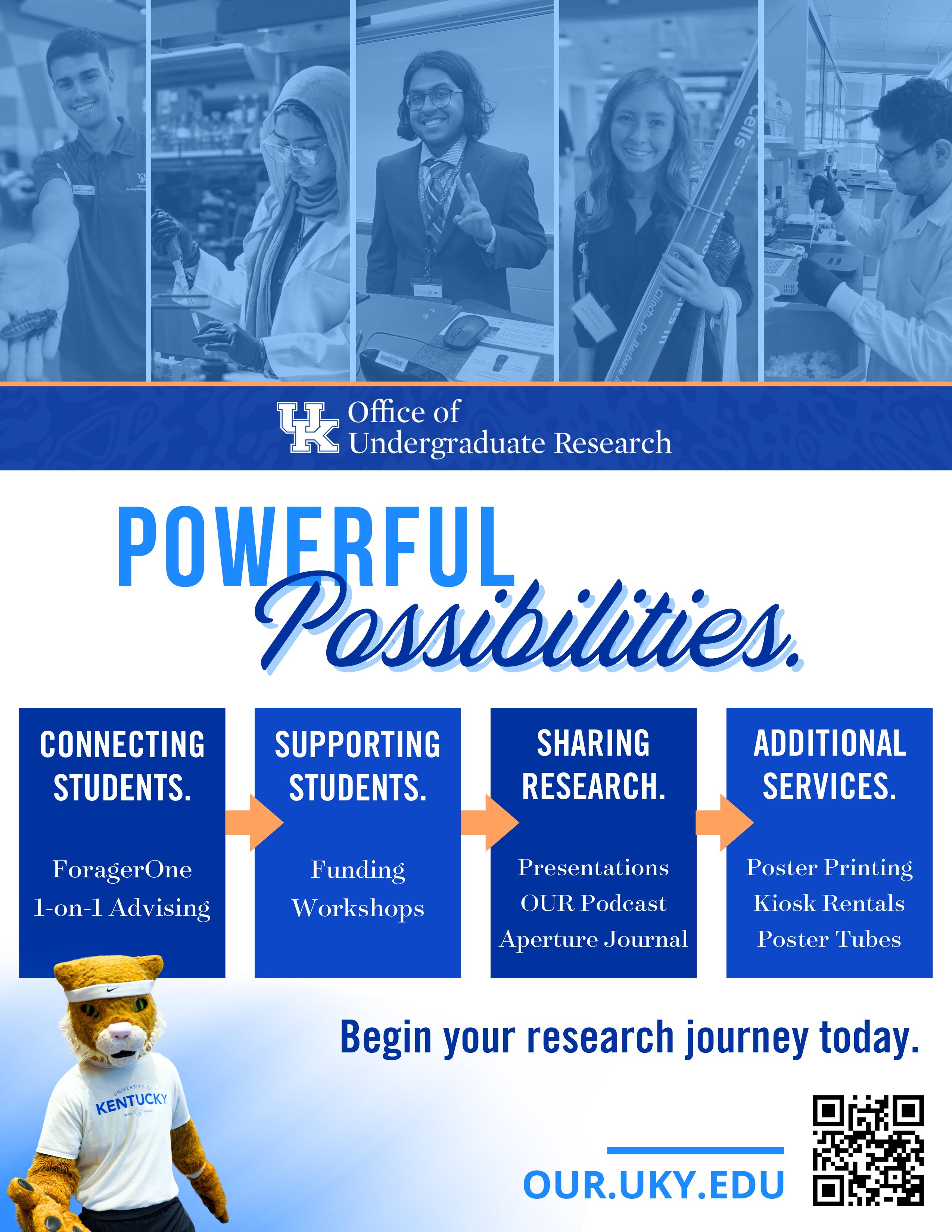
THE FALL OF ENICIDEM SATIRE OF AMERICA’S OPIOID EPIDEMIC

27 27
ENICIDEM - A FAIRYTALE & AMERICA’S RESPONSE TO THE EPIDEMIC
CAROLINE YOUDES
Caroline Youdes is a driven student, passionate about service and healthcare advocacy. She graduated from the University of Kentucky and the Lewis Honors College in May 2024, earning a Bachelor of Science in Biology with minors in Spanish and neuroscience. Caroline grew up surrounded by arts and creativity. She played the piano and various percussion instruments and developed a love for creative writing. At UK, Caroline’s interest in the humanities manifested in her exploration of Spanish culture and language. During her undergraduate career, Caroline also dedicated time to basic science research, hoping to push medicine’s boundaries and create a brighter future for patients with limited treatment options. She plans to continue research and apply her patient-care experience from working as a pediatric nursing assistant in the next phase of her academic journey as she attends the Washington University School of Medicine in St. Louis. As a future physician, Caroline hopes to explore the intersection of science and humanities to best serve her patients with evidence-based therapies and empathy. Caroline is thrilled to contribute to Aperture, exploring the power of storytelling as an avenue to educate the public about pressing health issues. In her free time, Caroline enjoys reading, volunteering with the DanceBlue pediatric hematology/oncology clinic and Camp Kids Cancer Alliance, watching reality TV with friends, and spending time at Lexington’s arboretum and local coffee shops.
28
28
The Fall of Enicidem - A Fairytale & Satire of America’s Response to the Opioid Epidemic
Caroline Youdes & Dr. Anthony Bardo
ABSTRACT
This project is a satire, presented as a fairytale, of the public response to the opioid epidemic. This crisis is characterized by a significant increase in the misuse and abuse of opioid drugs, including prescription painkillers, heroin, and synthetic opioids like fentanyl. It has had devastating consequences, leading to a sharp rise in overdoses, addiction, and deaths. Here, magic beans are presented as a euphemism for opioids. These drugs are a representation of a healthcare system that encourages quick, simple responses to complicated mental and physical health needs. The goal in depicting this public health emergency in the format of a lighthearted story is to lead Americans to recognize the severity of this crisis and the many flaws that exist within strategies to solve it by viewing it indirectly as an outside party. This format is inspired by Horace Miner’s critique of American healthcare in Body Ritual Among the Nacirema. Encidem is medicine spelled backwards, a strategy employed through several examples throughout the story. A secondary objective of this project is to simplify major propositions presented by the sociological theories of (1) Fundamental Determinants of Health, (2) Health Lifestyles Theory, (3) social epidemiology, and (4) medicalization to make them easily comprehensible to a general, educated reader.
Once upon a time, in a faraway land, lived the beautiful kingdom of Enicidem, ruled by King Link, Queen Phelana, and their three daughters. Their kingdom was full of townspeople who maintained their optimism, even amidst an ongoing war with the nearby kingdom of Etaipo. The key to Encidem’s unwavering persistence could be found growing in the garden of the kingdom’s witch doctor. What appeared to be normal beans actually contained magical healing properties1. These beans, once digested, put their user into a mystical trance, clearing away any pain or negative feelings almost instantly. Once only prescribed to those facing chronic injuries or acute pain, they were endorsed by the royal family during the war to improve the kingdom’s morale and, thus, approval of rulings. The magic beans morphed from a rare substance to the subject of a rampant craze. On the surface, they were a holy grail, the cure to the kingdom’s underlying suffering… but no one foresaw the conse-
quences to follow2.
High up in the castle, the royal family had no need or desire to experiment with the magic beans. Growing up in a life of luxury, they already had everything they could ever want. They hardly even understood what it meant to be sick or in pain3. Generations of royals had been taught the importance of caring for their body, which meant taking necessary measures to ensure their well-being4. After all, royals were considered superior and were therefore expected to live longer than peasants, even if it required a great deal of wealth and effort. King Link ordered his servants to fill the castle kitchen with the healthiest of foods, some enhanced by the witch doctor herself. The castle’s fountain produced clean, pure water rumored to have anti-aging properties. Any physical labor needed to keep the castle, and kingdom in general, running fell on the peasants and never the royals so as to protect their bodies from wear. King Link and his family had
1Within this satire, magic beans are a euphemism for opioid medications. These drugs are a representation of a healthcare system that encourages quick, simple responses to complicated mental and physical health needs. Our goal in depicting this public health emergency in the format of a lighthearted fairytale is to lead Americans to recognize the severity of this crisis and the many flaws that exist within strategies to solve it by viewing it as an outside party. This format is inspired by Horace Miner’s critique of American healthcare in Body Ritual Among the Nacirema. Secondly, we hope to simplify major propositions presented by the sociological theories of (1) Fundamental Determinants of Health, (2) Health Lifestyles Theory, (3) social epidemiology, and (4) medicalization to make them easily comprehensible to a general, educated reader.
29
every resource imaginable at their disposal and were generally emotionally and physically unaffected by the war that they themselves had ordered. With the knowledge they possessed of the importance of good health and the lack of pain they experienced, it was absurd for the royals to even consider experimenting with the magic beans. The king and queen wouldn’t dare put a substance into their bodies without a thorough understanding of any side effects or potential negative outcomes.
The peasants, however, were living in a very different world beyond the castle’s walls. While the royals basked in luxury, the peasants endured both obvious and invisible injuries in the war. They longed for momentary relief and were willing to try practically anything to get it. The witch doctor was overwhelmed by people begging her for a share of beans, and the demand only grew. Full of beans and distracted from their woes, the peasants had found a temporary escape. The king noticed the rejuvenation of his kingdom and began to encourage peasants to eat magic beans for any of their aches and pains5. This medical marvel was revolutionary for the kingdom and has been attributed as a factor in the eventual defeat of Etaipo.
After the war was won and injured soldiers healed, everything was expected to return to normal… but it didn’t. Those who were injured before wanted to return to their trance for a while to get away from their post-war world. Those who were not injured wanted to experience the high created by the beans to
see if their everyday problems would also go away. The Kingdom went into a “bean-frenzy,” much to the confusion of the royals. They were struggling to grasp why people were in such dire need for the magic beans. So called “beaners” had become the subject of disdain from the royals and other nobles. Even a mention of magic beans triggered scowls and disapproval from members of the upper class6. But once people had tried them, they couldn’t seem to quit. Beaners began taking multiple beans at once in order to achieve the same effect the beans initially had, as if their bodies were becoming immune to the magic. Those who tested their limits and consumed too many beans at once were in danger of being trapped into a deep, permanent slumber. Lives were being halted at an alarming rate, and yet many beaners were undeterred. What was intended to be a one-time remedy quickly became an obsession.
When peasants began recklessly stealing beans7 directly from the witch’s garden once their supplies had run out, the King began to fear that the peasants’ need for the beans was becoming a threat to his power. A population out of control is a risk to its leaders. He eventually became concerned for his own family as well. He had heard of a princess in another kingdom who took multiple of his witch’s beans at once and had been asleep ever since, earning her infamy as a “sleeping beauty.” He was worried his daughters would start to become interested in the beans, even though peasants were primarily the ones drawn to
2The shift from miracle drug to the source of an epidemic is relevant to social epidemiology, exhibiting a change over time. In 1700s colonial America, doctors prescribed opium to patients who reported pain and other maladies. Multiple colonists cultivated opium in their own gardens. It was not until after the Civil War that the dangers of opioid use became more widely understood. Injured soldiers who had been administered morphine and remained addicted were diagnosed with “Soldier’s Disease.” Later in the 1870s-1890s, physicians started to raise concerns publicly about opioid addiction, then referred to as “narcomania’’ (“Timeline of the Opioid Epidemic”).
3The royals represent people of a high socioeconomic status. Their privilege of low risk for being impacted by this “bean frenzy” illustrates principles of both Fundamental Determinants of Health (FDoH) theory and Health Lifestyles Theory (HLT). FDoH posits that inequitable distribution of resources has a direct impact on health. Those with more financial resources have access to the highest quality medical services, new technologies, and other factors relevant to maintaining good health (i.e. clean water, nutritious food). A strength of this theory is its emphasis on the social factors, like socioeconomic status, that predetermine health outcomes. Here, peasants are more likely to become addicted to magic beans from the day they are born simply due to the circumstances they were born into. The limitation of FDoH is the little room for agency. With a topic such as the opioid crisis or “bean frenzy” people of every race, class, gender, etc. are affected, albeit to different extents. There must, therefore, be an element of decision-making or outside factors that influence people’s inclination to use opioid/magic beans. HLT, on the other hand, perhaps better encompasses the opioid crisis represented here. HLT suggests that, although choice is a factor in determining whether or not someone gets sick (or uses the magic beans in this case), class circumstances are critical in influencing peoples’ habits and decisions. Here, peasants are more likely to have jobs that require manual labor and are forced to fight in the war, increasing their risk of injury/pain and, thus, reliance on magic beans. No one is required to use the beans and any person has the option to decline them, but the royals are in a position that makes them much more likely to refuse magic beans than the peasants. These theories are relevant to the opioid epidemic specifically because, compared to people living in households at least five-times above the poverty line, people who lived in poverty were more likely to die from opioid overdose (Altekruse et al. 7). Opioid fatality is strongly linked to indicators of low socioeconomic status, a crucial piece of information that can prove useful in targeting prevention, treatment, and rehabilitation to the groups that are considered most vulnerable.
30
The Fall of Enicidem
them8. King Link deemed it necessary to crack down on the use of beans before things went too far. His son-in-law, the prince, was his right-hand man and vowed to enforce his wishes. The prince was known for being strict and unforgiving, going from town to town to ruthlessly search for and confiscate magic beans9. He even went directly to the witch doctor and asked her to reduce her cultivation of the beans. The war against Etaipo seemed to give way to a new war on magic beans. Alas, to the royals’ dismay, the bean frenzy remained as rife as ever10
Contrary to the king’s wishes, forbidding the beans was actually exacerbating the problem. As time went on, more people had been taken into the permanent slumber from the magic beans than had been killed in the war11 In need of another approach, Queen Phelana suggested that helping their subjects gradually curtail their addiction to the beans may provide a more long lasting solution. She had the prince build a grand ship named Baher as a safe haven for the beaners to receive help12. Led by Captain Odrab, the ship’s crew introduced other ways for the beaners to cope with their harsh reality. This included mediation, art therapy, and counseling from Captain Odrab himself.
While the problem was never completely resolved, Baher did help alleviate it. Some people began to get better, but not everyone.
The king returned to the witch to ask if there was anything she had that could fix the problem. She mentioned a new medicine that she had been working on that grew quickly and was relatively cheap: magic lentils13. The king was delighted to hear of a new substance that could return his kingdown to normalcy. This seemed to be the “happily ever after ever” his people deserved. However, unbeknownst to King Link, this new miracle solution may only escalate the magic bean frenzy. In a hierarchical society such as Encidem, when once crisis is rectified, another is bound to emerge…
4Disparities in awareness of good health practices between royals and peasants is representative of an educational gradient (related to HLT). Education is intuitively closely tied to health. More education increases access to resources (FDoH) that can manage and prevent health problems (e.g. knowledge, jobs, money, health insurance). Education and socialization influence individuals’ decision making and increases agency to improve health behaviors, such as declining potentially risky substances. This educational gradient is present for virtually every marker of health and the opioid crisis is no exception. Opioid fatality is reportedly higher in unemployed than employed individuals and, compared to adults with graduate degrees, those with high school diplomas only were much more at-risk (Altekruse et al. 6).
5In the late 1990s, pharmaceutical companies reassured the medical community that patients would not become addicted to opioid pain relievers and healthcare providers began to prescribe them at greater rates. This allowed opiate usage to escalate to the point of crisis. Analogously to how pharmaceutical companies have a motive to underplay the addictive properties of certain opioids for monetary gain, the king has a motive to trivialize the potential dangers of the magic beans to accomplish his political plans to win the war. An example of the pharmaceutical industry’s role in stimulating the opioid epidemic is Purdue Pharma’s fraudulent description of OxyContin as less addictive than other opioids (Feldsher 1).
6One of the most detrimental barriers to seeking treatment for those experiencing opioid use disorder is the stigma surrounding substance use. When treating these patients, it’s important to make a distinction between the person and their disease so that they are treated as people first, not just “addicts.” Stigma further harms the mental health of those struggling with opioid addiction and can interfere with the quality of care that they receive (“Opioids and stigma”). Removing the negative connotation surrounding opiate addiction is directly related to medicalization. Opioid usage has transformed from an act of deviance (immoral, sinful behavior) to a legitimate medical concern…
Substance addiction is frequently referenced as an exception to Parson’s Sick Role, which describes the rights and responsibilities of someone with an illness. Those struggling with substance use disorder have not historically received the same understanding and accommodation as those facing other diseases such as cancer. Medical understanding of opiates has also changed over time as knowledge of addiction and risk of fatality has widened significantly compared to when they first were prescribed. It’s time to decriminalize the use and possession of drugs to instead provide a health and social response that could save countless lives.
7People are often driven by addiction or a desire to experience a high to go to great lengths to obtain opiates. Theft from doctors’ offices/ hospitals/ pharmacies, home burglaries, and medical fraud have all become concerns due to the high demand for opioids for personal use or
31
REFERENCES
• Altekruse, Sean F et al. “Socioeconomic risk factors for fatal opioid overdoses in the United
• States: Findings from the Mortality Disparities in American Communities Study (MDAC).” PloS one vol. 15,1 e0227966. 17 Jan. 2020, doi:10.1371/journal.pone.0227966
• Case, Anne, and Angus Deaton. “Rising Morbidity and Mortality in Midlife among White
• Non-Hispanic Americans in the 21st Century.” Proceedings of the National Academy of Sciences, vol. 112, no. 49, 2015, pp. 15078–15083, https://doi.org/10.1073/pnas.1518393112.
• Dasgupta, Nabarun, et al. “Opioid Crisis: No Easy Fix to Its Social and Economic
• Determinants.” American Journal of Public Health, vol. 108, no. 2, 2018, pp. 182–186, https://doi. org/10.2105/ajph.2017.304187.
• Haddad, Anne. “Physician Perspectives on Opioid Abuse epidemic.” Topics in Pain
• Management, vol. 32, no. 10, May 2017, pp. 10–10, https://doi.org/10.1097/01. tpm.0000516190.09314.1c.
• Feldscher, Karen. “What Led to the Opioid Crisis-and How to Fix It.” Harvard News, 28 Nov.
• 2023, www.hsph.harvard.edu/news/features/what-led-to-the-opioid-
• crisis-and-how-to-fix-it/.
• Lloyd I. Sederer, MD. “The Medical Irony of the Deadly Opioid Epidemic.” Psychiatric Times,
• 16 Nov. 2020, www.psychiatrictimes.com/view/medical-irony-deadly-opioid-epidemic.
• Lopez, German. “The Opioid Epidemic, Explained.” Vox, 3 Aug. 2017,
• www.vox.com/science-and-health/2017/8/3/16079772/opioid-epidemic-drug-overdoses. Miner, Horace. “Body ritual among the Nacirema.” American Anthropologist, vol. 58, no. 3, June
• 1956, pp. 503–507, https://doi.org/10.1525/aa.1956.58.3.02a00080.
• Miron, Jeffrey, et al. “Overdosing on Regulation: How Government Caused the Opioid
• Epidemic.” Cato.Org, 14 Feb. 2019, www.cato.org/policy-analysis/overdosing-regulation-how-government-caused-opioid-epidemic.
• Span, Paula. “The Pain Wouldn’t Stop - Because Her Medication Had Been Stolen.” The
• New York Times, The New York Times, 17 Sept. 2021, www.nytimes.com/2021/09/17/health/elderly-opioids-drugs-theft.html#:~:text=New%20Old%20Age-,The%20Pain%20Wouldn’t%20Stop%20 %E2%80%94%20Because%20Her%20Medication%20Had%20Been,targets%20for%20exploitation%20and%20abuse.&text=LaVonne%20Borsheim’s%20family%20could%20not,was%20suffering%20such%20intense%20pain.
• “A Timeline of the Opioid Epidemic.” Leidos, 13 Sept. 2019,
• www.leidos.com/insights/timeline-opioid-epidemic.
profit. Older americans are especially at risk for drug diversion as their prescribed pain medications are stolen by home health nurses or other care providers (Span).
8This further exemplifies the relevance of HLT. Just because someone is a peasant does not mean they will take beans and, likewise, just because someone is a royal does not mean they will not, but a person’s life chances are shaped by their socioeconomic status and other demographic factors.
9This also depicts change over time and place (social epidemiology). In 1923, all legal narcotics were banned in the U.S. under the Treasury Department’s Narcotics Division. This was followed by the Anti-Heroin Act in 1924 which made possession and manufacture of heroin illegal (“Timeline of the Opioid Epidemic”).
10Many state governments have taken measures to increase legal restrictions on opioid prescribing, following the logic of “more prescribing, more deaths.” However, these policies have been less successful than hoped at curtailing overdose deaths by forcing users to turn to diverted or illicit opioids, like street heroin or more recently fentanyl, whose quality and potency is hard for consumers to assess (Miron et al.). The prohibition of opiates has created a breeding ground for the rise of a dangerous illicit drug market across the U.S. These markets are unregulated, run by organized criminal gangs, and are killing thousands across communities.
11“Current national trends indicate that each year more people die of overdoses—the majority of which involve opioid drugs—than died in the entirety of the Vietnam War, the Korean War, or any armed conflict since the end of World War II” (Haddad 1). In the Case/Deaton article discussed in class, increased availability of opioid prescriptions for pain was attributed as a catalyst of the long-term decline in life expectancy in middle-class white Americans.
12Similarly to this pirate ship, rehabilitation facilities allow those in recovery to isolate themselves from people, places, and things that could trigger their desire to use opioids. Counselors can help people to understand the underlying reasons behind their drug use and address the root of the problem. Rehab also fosters accountability for maintaining sobriety and promotes healthier habits to end the cycle of addiction.
13This new alternative to magic beans relates to the constant debut of new painkillers on the market. It is also relevant to the proposition made by FDoH theory that social disparities in health will persist over time. Even if one individual-level mechanism/ intervening factor (e.g. magic beans) is solved, another disparity will emerge (e.g. magic lentils). The cycle is ongoing until social inequities themselves (e.g. the feudal system in Enicidem) are addressed.
32
The Fall of Enicidem
THE PERSISTENCE OF MEDIUMS: CREATING ARCHIVE OF ANASTASIA

33 33
OF MEMORY IN OTHER CREATING A DIGITAL AUDIO ANASTASIA TSVETAEVA
JOHNNA WARKENTINE
Johnna Warkentine is a recent graduate from the University of Kentucky where she received a dual degree in Linguistics and Russian Studies. At the University of Kentucky, she was interested in minority language rights, contemporary Russian culture and language, and oral history. In her professional life, she worked at various libraries, both university and archival, as well as public, and has worked in education as a language teacher. Currently, she’s serving in Peace Corps Georgia as an education volunteer.
34
34
The Persistence of Memory in Other Mediums: Creating a Digital Audio Archive of Anastasia Tsvetaeva
Johnna Warkentine & Dr. Molly T. Blasing
ABSTRACT
In March 2022, the University of Kentucky Libraries received a donation of books, papers, artifacts and archival materials concerning the Russian writers Marina (1892-1941) and Anastasia (1894-1993). These materials were donated by Uli Zislin, the 92-year-old Jewish Russian-American curator of the Washington Museum of Russian Poetry and Music, located in Washington, DC. Among the two dozen boxes of donated materials is a set of VHS tapes of interviews and literary events that Zislin filmed in Russia in the late 1990s. In this presentation, I explore the background and content of the materials as well as offer an overview of the software and methodology I used with the audio-visual materials to catalog and annotate them as well as make them legible to researchers. In this paper, I explore the personality and style of the videographer, Uli Zislin, through the layers of memory captured within the specific video materials, consisting of event recordings and oral histories by Anastasia Tsvetaeva’s contemporaries and enthusiasts, as well as through the narrative construction of the materials. Using Michael Frisch’s concept of “shared authority,” I analyze the performance of memory in space, oral history and video editing to demonstrate how such materials offer avenues for new insights into the practice of recovering literary memory during the early years of post-Soviet Russia.
Keywords: post-Soviet Russia, literature, oral history, Silver Age of Russian Poetry, Tsvetaetva, audio-visual, memory
INTRODUCTION
When I first was contacted via the Russian Department listserv about the opportunity to work on a collection of Russian and English language materials, newly acquired by the UK library system, I was struck and intrigued by the story I was presented: a museum in Washington, DC, a decade-long search to house its items, and the Silver Age writers: a pair of Russian writers–sisters–whose lives were marked by censorship, imprisonment, and exile. The contents were as described—books, rare items, manuscripts, and interviews—all of which needed to be processed, cataloged, and their value appraised and understood through research.
To tell this story with any sense, it would only be proper to start where I did here with the acquisition of materials and the man who archived them. The main figure of interest is Uli Zislin, the 92-year-old (at time of writing)
co-founder and curator of the Washington Museum of Russian Poetry and Music. He had for several years been inquiring about finding a home for his collection of materials related to the Silver Age writers before they finally found a home at the Margaret I. King Library at the University of Kentucky. “Silver Age” here refers to that generation of writers who wrote during the last decade or so of the 19th century and the first few decades of the 20th century and whose writings are considered exceptional and often compared to the Golden Age of Russian writers. This term comes to us from philosopher Nikolai Berdyaev [Guarant-InfoCentre 2008].
Uli Zislin is Muscovite by birth, born as part of an older Soviet Jewish generation of which many would come to leave Russia and other former Soviet countries for abroad [Tolts 2020], in his case in 1996, in order to follow his
35
children, who sought new job opportunities in the US. Zislin’s first career was as a chemical engineer, but he has long been drawn to literature and the arts. In his second life in the US, he is a prolific writer, researcher, archivist, poet, and musician, specifically a guitar player and songwriter. He has been involved in the Russian diaspora and literary scene for decades. For many years, he also curated the museum in collaboration with his late wife Svetlana for whom the collection is doubly named: the Uli and Svetlana Zislin Collection on Marina and Anastasia Tsvetaeva.

Uli Zislin was a key collaborator and consultant on this project. His expertise and knowledge of the subject proved to be key to achieving the various goals of the project both for me and other students and faculty who worked with the materials. What motivates Zislin is a deep interest in the Silver Age poets and Russian culture generally, and it is through his museum and archive work that he expresses this passion and presents these literary figures to a largely American audience. When I and others involved in the project asked him what he considered his greatest achievement to be during an interview we conducted this summer, he explained that it is the Alley of Russian Poets, a municipal project he developed in a public park with trees and plaques to educate about and commemorate Golden and Silver Age Russian poets. Tended to by Zislin, he considers it the finest thing he’s ever done.
The Uli and Svetlana Zislin Collection on Marina and Anastasia Tsvetaeva itself con-
sisted of a wide range of materials, both primary and secondary, original research, books, manuscripts, art, artifacts, and rare items, including several personal items owned by Anastasia Tsvetaeva (one of the writers that the collection is primarily about). When the items were brought to the University of Kentucky, the items needed to be sorted and cataloged as well as evaluated as this was the first time the materials were analyzed in any systematic manner.
In regard to my own main goal for this project, my focus was on working with the audio-visual components of the collection, specifically focusing on a particular VHS tape with 4 hours of largely original material stored on it. With support from the Nunn Center for Oral History, I sought to help digitize and catalog the audio-visual materials and analyze them to answer my questions of memory and knowing in relation to the central figures of the materials he gifted to us, Anastasia Tsvetaeva, and by proxy her sister Marina Tsvetaeva.
Discovering the questions that I wanted to address in my project developed through the process of cataloging and organizing the Zislin collection and comparing what was contained in the collection to what is already known about Anastasia and Marina Tsvetaeva. This took shape in light of how the audio and video interviews with and about Anastasia Tsvetaeva I examined reveal that written accounts cannot in regard to how Anastasia Tsvetaeva’s contemporaries thought and continue to think of her. In this article, I examine how participants in events and memory recitation as well as the one who records said events, in our case Uli Zislin, shape the contours of these oral histories. Using Michael Frisch’s concept of “shared authority,” I analyze the performance of memory in space, oral history and video editing to demonstrate how such materials offer avenues for new insights into the practice of recovering literary memory during the early years of post-Soviet Russia. What I argue is that the form and assertions of the video material I analyzed form a type of oral history and that both the medium and participants contribute to the process of collective memory.
36
Таруса Цветаевский Костер
Fig 1. Uli Zislin playing the guitar at the Tarusa Tsvetaeva Bonfire (
), dated between 1988-1992 (from the Zislin Collection)
Creating A Digital Audio Archive of Anastasia Tsvetaeva
OUR SUBJECTS
Marina Tsvetaeva (1892-1941)
The vast majority of the collection that was gifted to the University of Kentucky pertains to the writer Anastasia Tsvetaeva, but in order to understand Anastasia, we must first come to understand her sister and arguably more famous and recognizable poet, Marina Tsvetaeva. Marina is one of the more cherished and well-known Silver Age poets, notable for her autobiographical prose as much as the rhythm and shining language of her poetry [Blasing 2021]. Important aspects of Marina Tsvetaeva’s life narrative include her pre-revolutionary birth and place among her Silver Age contemporaries (among them Akhmatova, Pasternak, and Mandelshtam) as well as her tumultuous life, marked by her rumored, possibly sordid and ultimately failed affairs, her time in emigration, her tragic return to the USSR, and her early death due to suicide [“Biography Marina Tsvetaeva”]. Often isolated from and ostracized by the Russian emigre community, she was virtually erased from Russian literary society and her early fame and attention dissipated. Her work was not published in the Soviet Union from the time of her emigration until a full 20 years after her early death in 1941. Marina’s work, during her own lifetime at least, was largely suppressed. It was only after the end of censorship and the opening of the NKVD’s archives and the publishing of her work in the 1960s that details of Marina’s life and much of her work exploded onto the global literature scene and into mainstream knowledge and study.
Anastasia Tsvetaeva (1894-1993)
Anastasia’s life is characterized in many ways by being in Marina’s shadow and peering outwards. She was a solid writer of her own right, described as having a sort of “suffering sincerity”1 (страдающая искренность) [Aidinyan 2008, pg. 8] by Stanislav Aidinyan, her former literary secretary. Her Silver Age contemporary Boris Pasternak remarked in a personal letter to Anastasia that she was a writer who evoked the best of the literary past, that she wrote with “such language of the heart” (каким
языком сердца…) such that it “breathes with much the same restored heat of those days” (это дышит почти восстановленным
дней!) [quoted in Aidinyan 2008, pg. 8]. As a writer, Anastasia Tsvetaeva is best known for memoirs about her childhood and early life. Additionally, she is known for her central role in restoring Marina’s legacy. During the 1960s, she led the way in searching for Marina’s true grave, but this was ultimately unsuccessful. She also collaborated and pushed for the establishment of the House Museum of Marina Tsvetaeva, which opened in 1992 [Danileva and Shainyan 2011]. It is Anastasia that the Zislin Collection mainly addresses and has materials about, but her life is inevitably bound up in Marina’s, in the way the lives of sisters often are. Anastasia often remarked about the similarities that she bore to her sister and that her sister bore to Anastasia herself. One example is how she would reference how similar their voices were in tone and intonation, something to note as we have no recordings of Marina’s voice. As she notes in Anastasia’s own recounted memories from an interview from the documentary «Мне 90 лет, еще легка походка…
am 90 years old, and my steps are still light…]:
[Apparently, this is what is called the soul. We [Marina and I] had ab– we were similar in that we had the same voice, which is the expression of the soul of childhood itself. Our older sister [Valeriya Tsvetaeva] was considerably older than us from our father’s first marriage. She couldn’t tell who was speaking from the other room… We had the same voice. And when Marina began to write poems, her best poems were created
37
жаром тех
[I
то что называется душой. У нас были об– очень сходные, потому что голос, который есть выражение души самого детства. Старшая сестра намного старше нас от первого брака папы. Она не могла из соседней комнаты отличить кто говорит… Интонации были те же самые. И когда Марина начала уже писать стихи, уже лучше её стихи начались после смерти мамы. Она всегда приходила ко мне и говорила эти стихи. Первая была я слушательница.”
»
“Видимо,
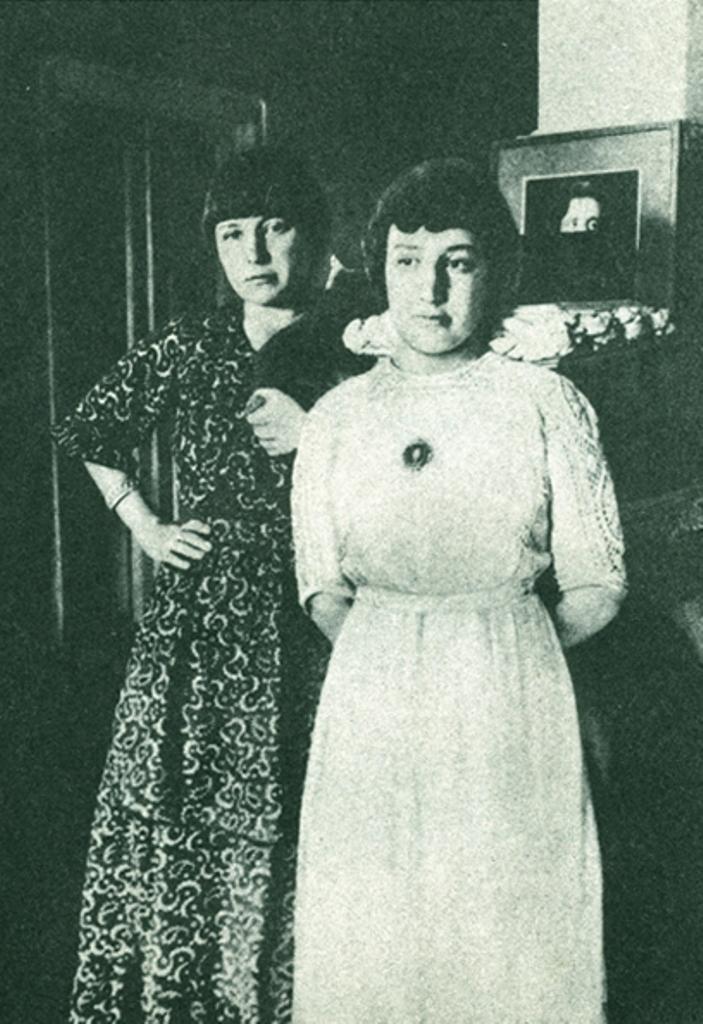
after our mother’s death. She would always come to me and recite these poems. I was her first listener.] [Schans 1989]
We lack many of Anastasia’s early writings as Anastasia was arrested in the 1930s and 1940s. This resulted in the destruction of some of these works by the NKVD, her imprisonment in the Butyrka Gulag Camp in 1933, internment in the Far East Gulag camp (1937-1947), and then ultimately in her internal exile in Pikhtovka, a town in Siberia [Smith 2014-2015]. She only returned to Moscow until her rehabilitation in 1959. Many of her most famous works were not published until the 1970s or later. Later in her life she became explicitly Orthodox and devout in her practice. Anna Genova notes in her article “Last Ray of the Silver Age”: “As a Christian believer, she kept church fasts and from the age of 27 she never ate animal meat at all. [From that time on] she forbade herself wine, smoking and other secular temptations” [Genova 2014]. The walls in her apartment were replete with icons of saints, church fathers, and other religious figures, a key part of the Orthodox Christian religion. This part of her personality of herself and her life influenced her works, particularly her autobiographical ones and the retelling of her memories in her later life.
METHODOLOGY
What I originally imagined I would be doing for this project, shifted dramatically through conversations with my mentor, the
other students involved with the project, and many of the librarians and archivists at the William T. Young Library and the Margaret I. King Library, Special Collections. Our point of entry into this collection was pure cataloging. This emerged out of a specific need: there were a lot of materials that needed to be sorted to be understandable and the students working on the project had the language skills and cultural knowledge to sort them. I spent a section of my time at the beginning of the project cataloging the boxes and using what I learned from these materials in order to widen my knowledge of the subject. I then used this knowledge when focusing on the audio-visual contents. Important also to the process was digitizing the video materials and making these materials legible and usable to a wider public. To do this, we used a web-based system that was pioneered by the University of Kentucky’s own Louie B. Nunn Center for Oral History. This system is known as OHMS. To explain what OHMS is in a few words, as the original creator Doug Boyd describes: “The Oral History Metadata Synchronizer (OHMS), a webbased system, provides users with word-level search capability and a time-correlated transcript or index, connecting the textual search term to the corresponding moment in the recorded interview online” [Boyd 2013]. OHMS has two main functions depending on the level of transcription and what types of details that are relevant. One of these functions essentially is that OHMS has the ability to synchronize transcriptions of what is being said in the video with the video itself, thus allowing the user to follow along with the transcript as the video progresses. It also allows the user to search through the transcription using keywords to find any given specific moment related to their inquiry and instantly be able to watch this clip. This is a useful way of organizing video material so users can sort through vast quantities of data quickly.
The other main function of OHMS is its indexing function. This function allows the user to divide an interview or video into segments and log different pieces of metadata for each section so that although there may not be a full transcript, the user will be able to search
38
Fig 2. Marina (on the left) and Anastasia Tsvetaeva (on the right). Feodosia, 1914. [Her name is Asya… 2016]
Creating A Digital Audio Archive of Anastasia Tsvetaeva
through relevant data and markers including a segment synopsis, subjects, keywords and even GPS descriptions to find their section of interest. This function also allows the cataloguer to record partial transcripts to help users locate themselves within the interview when listening to any given section out of context. In general, I primarily used the index function in the course of my project primarily due to the fact that it is considerably much less time consuming to index than write a whole transcript. And even though I didn’t fully transcribe the video materials, I was still able to sort, annotate the content and archive it in a usable form.
One of the useful features of this system is that both functions have the ability to upload information in multiple languages, regardless of whether it’s a transcript or indexes. Using this, I was able to index Zislin’s video material in both Russian and English (the two languages primarily used in the material), thus making the video accessible to those who spoke either or both languages and also cataloging spellings and other relevant information.
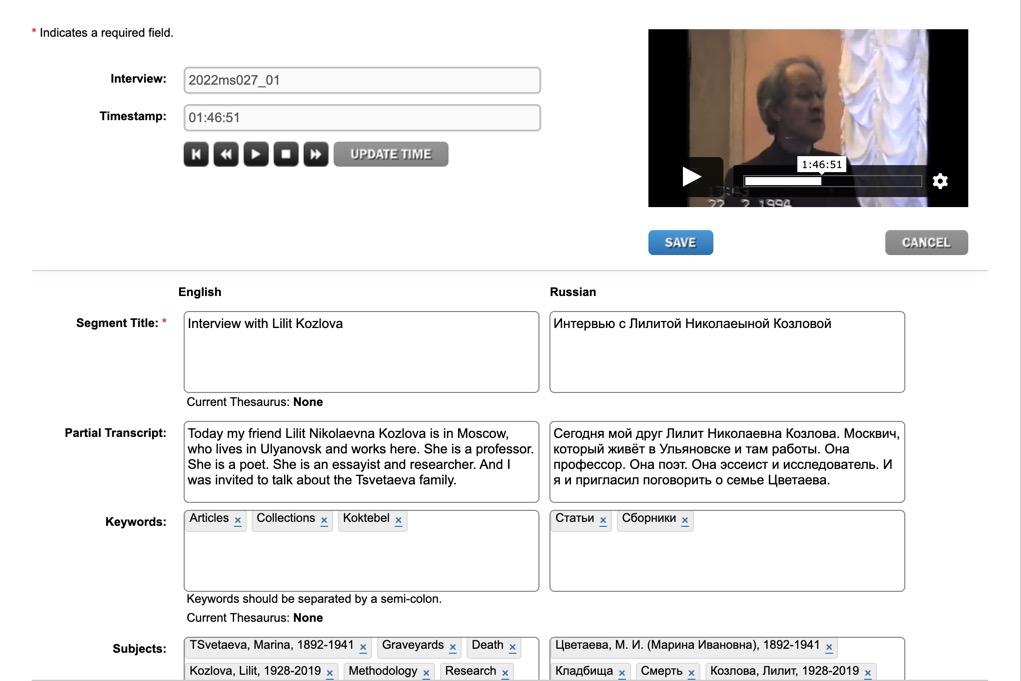
A thing to note about how I used OHMS for my project, is that the ultimate project that is being kept at the Nunn Center breaks a bit with certain standards in regard to how oral histories are sorted and divided at the University of Kentucky where the collection and video material is held. The general rule for oral history archiving at the Nunn Center dictates that individual interviews, even those recorded by the same person and part of a collection, should be split out and tagged for internal information. My own project kept the video in its full form in one file, generally sorting the video
into its component parts but not splitting off sections that weren’t purely oral history, such as clips from events or the section of the documentary film recorded on the video. The reason for this is that the video in question as a whole has narrative fidelity and necessitates that all parts of the video remain together. The fact of this video’s construction allowed me and Doug Boyd at the Nunn Center to push the boundaries a bit of what oral history at UK can be using this software and some of the techniques he advised.
Additionally in regard to methodology, there was a large quantity and variety of background research I needed to undertake and materials I used in order to make sense of the collection. A significant number of names and references within the video itself involved people within the constellation of Anastasia Tsvetaeva’s friends and family as well as those part of Uli Zislin’s community of scholars and Tsvetaeva devotees. I particularly needed to learn more about those who attended memorial and remembrance events for the Tsvetaeva sisters such as the Tsvetaeva Bonfires in Tarusa (Цветаевский
) as these were main sites of interaction and ritual remembrance of the Tsvetaevas and other Silver Age writers also heavily documented and featured in the archive’s materials. This research involved transcribing sections of the interview-based film «Мне 90 лет, еще легка походка…» [I am 90 years old, and my steps are still light…], conducting an interview with Uli Zislin himself about his life and the museum, and reading works by Stanislav Aidinyan, Anastasia Tsvetaeva’s literary secretary and editor. Anastasia’s seminal work «Воспоминания» (Memoirs), and Uli Zislin’s extensive writings on the events and subject were also useful reference points.
ORAL HISTORY AND “SHARED AUTHORITY”
When speaking about oral history, it should first noted that oral history is better thought of as a particular process and not just collecting interviews for interview’s sake. Practitioners of oral history regard the interviews
39
Fig 3. Example of a completed index from the Zislin video project
Костер в Тарусе
and documents within their scope of examination not as pure documentary, a collection of static facts, but also documents with whole worlds of contextual elements that influence their creation. This includes understanding that the narrative construction of the material is changed by the very fact that it is located in an archive [Shopes 2014]. Additionally, there is also the influence of the interviewer on the interview itself to consider. If the interviewee shapes history through their recounting of their memories and thoughts, the interviewer just as soon does with how they conduct the interview, that is the bounds in which they set the interview, the questions, framing and even the fact of the subject’s being recorded at all and then arranged (or rearranged).
These considerations come to the fore in our own case with Zislin and his process of making the video materials that I analyze in this paper. The way that Zislin conducts and frames the interviews that he collects are instructive in the way that Zislin functions as a mediator from his position as a historian, an archivist and museum curator just as much as they show how the memories and recitations within this video on the behalf of the interviewees and the public spaces involved are illustrative of the memory surrounding Anastasia and to an extent Marina Tsvetaeva.
I argue that the relationship between Zislin and his subjects fits within the theoretical bounds of the concept “sharing authority,” first articulated by Michael Frisch, and that has become a common mode of understanding and “doing” oral history. “Sharing authority” is a sort of “inherent” quality “in the dialogic nature of an interview” [Frisch 1991] in which there is a history-making occurring between the interviewer and interviewee and that this history is determined by both as well. In Zislin’s case, he forms the bounds of the interviews, where these interviews take place, what questions are asked and what materials ultimately make it into the video. In the case of the participants, they provide the interview material, their memories and commentary on those memories either explicitly or incorporated through more complex linguistic methods or through framing devices.
Tom Rivers argues something similar in his introduction to his volume from Reflections on a Life in Medicine and Science. He writes that “the memoir that emerges as a result of this process [of oral history] is a new kind of historical document… Although it has been created by a participant in past events, it is also the creation of the historian-interviewer who has in fact determined the historical problems and relationships to be examined” [Benison & Rivers 1967]. In a similar vein, the video material I examine can be seen as a document in which the “truth” of memory is created not only by those who recount their stories, whether Anastasia in her literature, the interviewees in their personal stories, or the participants in their public performance of remembrance, but also Zislin as documentarian, archivist, and personal friend of many of the subjects.
MEMORY, COLLECTIVE HISTORY, AND RECITATION
To illustrate how commemoration practices operate in the materials of this archive, I will discuss one interview in particular, the interview Uli Zislin conducted in 1998 with Stanislav Aidinyan at Anastasia’s apartment, where she lived from 1979 through 1993. For a bit of background on Aidinyan himself, it’s important to know that he is Armenian by background but from Moscow. He goes by many titles: writer, translator, art critic, but importantly he was also the editor and secretary of Anastasia Tsvetaeva. A member of the Union of Russian Writers, a member of the Union of Writers-Translators, and Deputy Chairman of the South Russian Union of Writers, Aidinyan has been published in a number of literary magazines and publications [Aidinyan (n.d.) Biography]. Outside of his accomplished literary career, his relationship with Anastasia is of particular interest within this video and to our examination of his memories.
The video this clip comes from is a stitched together collection of recordings of events, interviews and a clip from a documentary film found within the Uli and Svetlana Zislin Collection on Marina and Anastasia Tsvetaeva.
40
Creating A Digital Audio Archive of Anastasia Tsvetaeva
This interview is a part of the collection shot on the same day, January 7th, 1998, Christmas in Russia according to the Orthodox calendar, in the same place.
In all of the interviews, just as here, it’s Uli Zislin who holds the camera. The clip is older and the VHS tape shows the age, distorted audio and wavy lines. Aidinyan is writing at a desk and above as well as behind him are photos of Marina Tsvetaeva, Anastasia’s apartment is replete with images, calendars, and icons on its walls. At the beginning of the clip, Zislin chimes in with a quiet voice explaining who Aidinyan is, “literary secretary of Anastasia Tvetaeva,” “poet,” “critic,” and just as importantly what qualities Zislin ascribes to him, “intelligent,” “modern.” Zislin pans around the room and we see further and then he catches Aidinyan’s attention and then the interview begins with Aidinyan’s words: “
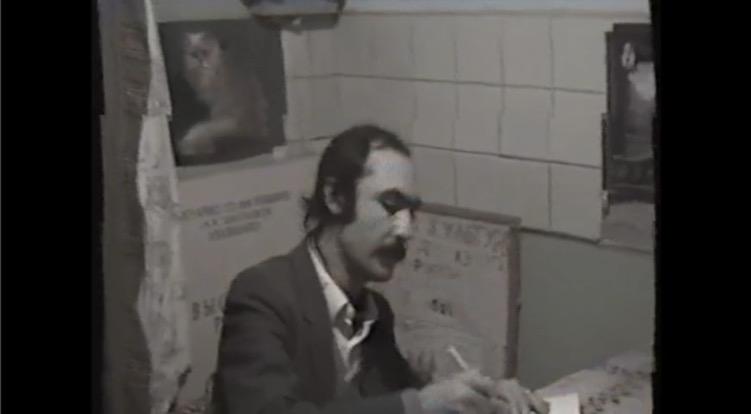
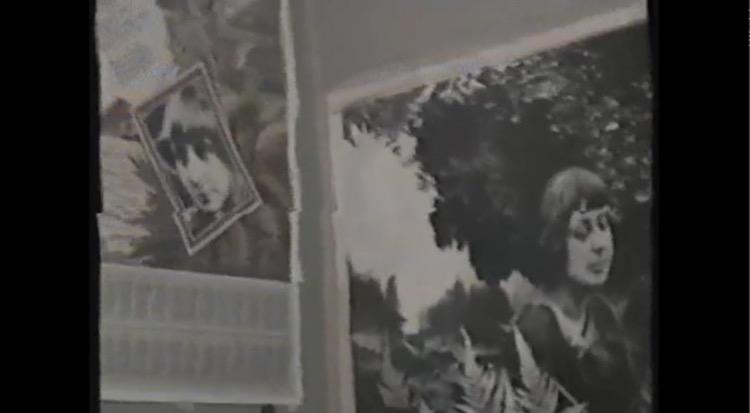
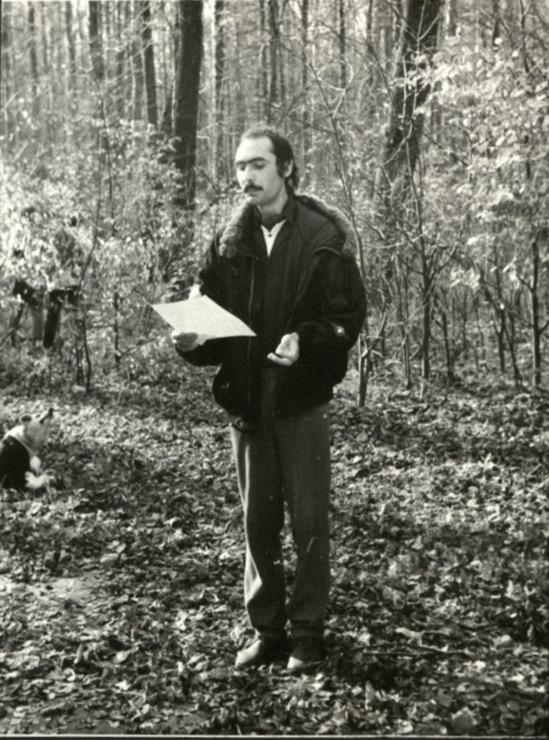
огромным
слова, и это слово пронзало людей.”
[Today it’s Christmas. It’s probably the first time [I am] here at Christmas without Anastasia Ivanovna. Around this table there was always a certain atmosphere during tea drinking, a certain warmth, called out to many to join in. Anyone who visited this home was sure to return here, because nowhere in Moscow, even in the still free-spirited 1980s was there a place as precise and high styled in the ways of the word. Anastasia Tsvetaeva possessed an enormous artistic talent in the [written and spoken] word. And that word penetrated [the hearts of] people..]2 [Zislin 1996-1998]
Throughout the short interview, Aidinyan speaks at length and very positively about Anastasia Tsvetaeva. He mentioned in detail a particular anecdote about her resolve in a specific moment of working with a publisher to release one of her novels “Amor,” a novel that he describes “everyone being touched by” («
[Zislin 1996-1998]. He discusses a particular incident when Anastasia stepped in to ensure that her book was published precisely as she wanted when an unnamed other editor failed to do their job repeatedly. Zislin clarifies several points and asks his questions, but otherwise it is Aidinyan who speaks while Zislin records.
41
Сегодня Рождество. Когда…наверное это первый раз я (sic) Рождество здесь без Анастасии Ивановны. За этим столом была особая атмосфера чаепитий, особое тепло, которое объявляло многих и многих приковывать кто однажды посещал этот
сюда.
нигде в Москве, даже в еще
восьмидесятые, не было
где было столь тонко и высоко
Анастасия Цветаева обладала
дом, тот обязательно возвращался
Потому что
не охлажденные
место,
в слове.
искусством
Fig 4. Image of Stanislav Aidinyan writing at a desk during Zislin’s interview with him
Fig 5. The image of Marina Tsvetaeva above Aidinyan
(Таруса Цветаевский Костер
Fig 6. Stanislav Aidinyan reciting a reading at the Tarusa Tsvetaeva Bonfire
),
dated between 1988-1992 (from the Zislin Collection)
этот роман, которому мы были все столь прикосновения»)
In Aidinyan's recounting of Anastasia’s book “Amor” and through this interview as a whole, a number of things can be understood about how not only he thinks and remembers Anastasia, but also himself and how these interviews function as objects of memory in general. On one hand, in the interview Aidinyan is recounting the facts of a particular incident, that is the events as they happened in what order and how the events are related to each other. On another and at the same time, he is communicating information about how he feels about the events and the figures involved, what he feels that the audience should know. He also positions himself within the story, his value judgments of the events as recounted, his thoughts on Tsvetaeva’s actions and her works.
What he does in this interview is that he valorizes Anastasia and her strength of will as a writer and authority on her own work, that she was someone who cultivated her own work and legacy as much as a culture of valuing art around her. He evaluates her work positively and valued her opinion highly when she was alive. He also positions himself as a collaborator in this process through his editing work and his relationship with her. This same positive memory and recounting, the reverence for her resolve and her words, can be found reflected in his writings about Anastasia. For example, in his introduction to Anastasia Tsvetaeva’s famous memoirs, «Воспоминания» [“Memoirs”], he describes Anastasia as such:
tion, who until the end preserved not only the clarity of mind, but that already lost, ancient Russian speech, where words of foreign origins were pronounced with the tendency in the language of the land where they came from… The abundance and capacity of her mind were incredible.] [Aidinyan 2008, pg. 5]
[Having lived to almost a hundred years, at the end of the twentieth century she was one of the last of the pre-revolutionary writers, a representative of the bygone genera-
The above example taken as a whole is similar to how many of these interviews take shape throughout the video materials: first the interviewees recount a story grounded within their own realities and then along with this they communicate their value judgements and ideas as filtered through experience and nostalgia looking back on Anastasia’s life and previous eras of Russian, Soviet history. Zislin’s editing and curation of the material acts as yet another filter and organizational factor within the center of these different elements. Not to mention, the interview materials place within the wider Zislin Collection plays a role in shaping the material. Often many of these same sentiments or even stories and anecdotes can be found in auxiliary writing and projects written by the participants present in the Zislin Collection. Some of them can also be found in the wider ecosystem of “Tsvetaeva research.” Moreover, the majority of the interviews collected within this video materials speak almost exclusively positively and using several different framing devices to speak about Anastasia’s life—that she was highly religious and devout, that she was literarily high minded and a very talented writer, that she was the “Last Ray of the Silver Age” and a remnant of a foregone era of literary and artistic achievement. These sentiments are communicated in different ways using different anecdotes and from different perspectives. However, I believe that all of these various instances of memory recitation and crafting of meaning serve a similar purpose. Much like within Aidinyan’s interview and writings, what I believe is happening here is the formulation of a kind of hagiography, a sort of canon of remembrance. What is being done by the participants in this video material through these interviews and through their participation in the literary events depicted is
42
Creating A Digital Audio Archive of Anastasia Tsvetaeva
“Дожив почти до ста лет, она в конце ХХ века была чуть ли не последним дореволюционным писателем, представителем ушедшего поколения, до конца сохранившим не только ясность ума, но ту, уже утерянную, стародавнюю русскую речь, когда слова иностранного происхождения произносились с уклоном в язык страны, откуда пришли... Богатство и емкость ее памяти удивляли.”
that they are reclaiming a literary heritage that they see as being lost or forgotten in their own communities and culture.
Many of the participants in these videos are from post-Soviet countries (often Russia) if not diaspora communities and are active participants in the wider “Tsvetaeva” and “Silver Age” ecosystem. Within a specifically post-Soviet context, I would argue that many of them see, whether consciously or unconsciously, that their participation in the literary events and interviews that Zislin records and conducts helps to revive the “lost” literary tradition that figures such as Anastasia Tsvetaeva represent. This can help explain the preoccupation with the “Silver Age” writers in general and also help make sense of the high reverence that they give the Tsvetaevas. As mentioned before, Aidiyan himself writes this very clearly when he says in his introduction to Anastasia Tsvetaeva’s memoirs “at the end of the twentieth century she was one of the last of the pre-revolutionary writers, a representative of the bygone generation, who until the end preserved not only the clarity of mind, but that already lost, ancient Russian speech” [Aidinyan 2008, pg. 5].
What these interviews help reveal is that in crafting this material, all involved participants underwent a sort of process of historical memory, that is “how people make sense of their past, how they connect individual experience and its social context” and how people “interpret their lives and the world around them” [Thomson 2011]. In these interviews and in the literary events depicted, the participants are placing themselves within the literary heritage of the Silver Age poets and of the Tsvetaevas. In this way, they make sense of their own cultural world in the suddenly disjointed society ruptured by the end of the Soviet Union and by the sudden change of the process, so to speak, of cultural production [Chernyaeva 2014] and the changing of motivating factors and control of said cultural production [Polowy 2011].
There are many such examples of this in the above interview by Aidiyan such as when he described the “high minded” and “literary” atmosphere that Anastasia cultivated in her home and around her and also through his de-
scriptions of her themselves. This is also present within framing devices that Zislin uses for several of the interviews. For example, within several of the interviews, Zislin records the subjects as they explain their own collection of books and works by the Tsvetaevas (and often also other Silver Age writers). Oftentimes they quite literally walk us through their bookshelves and stacks of other materials around them, explaining the importance of one piece of material or another. The images of Marina Tsvetaeva on the walls all around Aidinyan also come to mind as another example. They are literally positioned “within” the literary canon. In this way, the interviewee is connecting themselves to the looming near-mythological figures of the Tsvetaevas and to the Silver Age as a whole. Within the space, seemingly it’s understood that the attendees of the events and of the societies that Zislin depicts and participates in are resurrecting this lost literary heritage and the figures from that heritage.3
EVENT AND RITUAL
A key element of framing for these interviews is the fact that the events documented and many of the interviews recorded were part of a larger collection of events hosted and attended by Uli Zislin and his museum, including general meetings, meetings at Anastasia Tsvetaeva’s apartment, and poetry recitations on important dates. The annual Tsvetaeva Bonfires in the Washington, D.C. area and in Tarusa also loom large. The inclusion of Tarusa is an important location for the Tsvetaev family because that was where the Tsvetaeva sisters spent their childhood summers and where their family dacha was [“Museum of the Tsvetaev Family in Tarusa”]. Marina Tsvetaeva’s daughter, Ariadna Èfron, lived there as well after she was released from the gulag and rehabilitated. Within these events, often Anastasia and Marina’s writings are read in excerpts and personal memories or stories are shared. Other times original works inspired by or interpolated from these writings are also shared. At the Tsvetaeva Bonfires for example, an award was given to the best poet of the event. Uli Zislin would often put Anastasia or Marina’s poems to song and other times he would do the same
43
with his own original works.
There are many examples of these events within the video itself, but I will return to the Christmas event at Anastasia’s apartment where Aidinyan is interviewed to show how event and ritual play a vital role in the creation of collective memory and oral history. This specific event at Christmas is especially illuminating due to the fact that it fits into a wider framework of Anastasia as a specifically religious, Orthodox person. Christmas was an important part of her life and beliefs when she was alive. In the sections of the video taken during the event, there are poetry and prose readings, stories being swapped, the tree lit, and toasts to their memory given. This is also the site of many other interviews besides the one Zislin conducted with Aidinyan.
As Serguei Oushakine notes in his article on the public remembrance and management of history in regard to World War II in Russia: “Remembrance here [in public memorial events] is an act of reenacting. Or, to be more precise, it is an act of the (literal) embodying of symbolic and behavioral forms inherited from the past. To put it somewhat differently, this type of remembrance utilizes reenactment as a symbolic form and a protocol of interaction that make possible an experience of verisimilitude by translating the past into ‘a real space with real objects and people’” [Oushakine 2017, pg. 272]. At Anastasia’s apartment much of the same can be seen. Memories are not only spoken, they’re acted and reenacted out in public space, in ritual due to the recurrence and structured nature of these events. There is a transformation of memory of individual’s lives transformed into collective truth through physical recreation and space, the mythologization of the individual and the identification with their words. The specter of the sisters is embodied in the space in language and additionally often physically in the space by their books, photos, and artifacts.
This is part of what I believe the significance of these events had to those who attended them and why these materials were archived to begin with. These events served as a space for participants to physically through ritual express some of their deepest convictions
about art and literature as well as the significance of the Russian literary past with others in a collective space. It was a way for them to quite physically position themselves in that lineage and around others who held similar convictions. In the case of the Christmas event at Anastasia’s apartment, this involved storytelling, gift giving, and of course food and drink.
ANASTASIA’S ROLE IN HER OWN NARRATIVE
I also further argue that these ritual events and the religious nature of some of the events communicate another aspect of the “reclamation” of literary memory and culture that is present in the video material examined here and the events cataloged in the Zislin collection. The physical events and recorded interviews are key in the construction memory here, but just as important is the influence of Anastasia’s own writings on their memories and understanding of her as a person. Italian oral historian Alessandro Portelli’s assertion that memory is “not a passive depository of facts, but an active process of creation of meanings” [Portelli 2006] [Thomson 2011] can be applied to personal autobiographical recountings as much as memories about others.
It's important to note that a key element of Anastasia’s life narrative is that she was a particularly devoted and religious Orthodox Christian person. This is recounted and referenced in her own biography and often affirmed by those who knew her in these literary circles. As Ekaterina Esenia states in her excellent analysis of Anastasia Tsvetaeva’s autobiographical works, much of Anastasia’s most famous and read works were written later in her life, well after she shifted from a quasi-New Age and seemingly gnostic set of spiritual beliefs4 to a more firmly Christian and Orthodox worldview [Esenia 2017]. Her personal narrative was completely shaped by this deeply religious worldview and thus her stories change to fit what Esenia calls Anastasia’s “idyllic myth” (идиллический миф) about her family. Ekater-
44
Creating A Digital Audio Archive of Anastasia Tsvetaeva
ina Esenia explains that, in regard to the influence of the author on their own personal narratives, within autobiographical writing we see a “kind of bifurcation of the subject,” that the author is both the detached and omniscient relayer of facts about their own life, and also confessional, authentic, and subjective [Esenia 2017].
We see the influence of Anastasia’s curation of her own image and past in the stories that are told about her. Within the videos and events, there is a sense that those acting and speaking within the video are raising the sisters to the level of myth, though for different reasons. For Marina, life full of sorrows and suffering and her early death are often mentioned as well as the lost potential she could’ve had for this early death. For Anastasia, her biographies, her long life, her role in literary cultural scenes for many decades and also her efforts to revive Marina’s memory in the decades before her death often are the focus of these stories and myths. Though importantly also, many of the stories and ways Anastasia is mentioned depicts her in a particularly devout and religious light. This is perhaps indeed how the subjects of the interview knew her and saw her conduct her life, but this shows how Anastasia’s conversion to Orthodox Christianity influenced a specific nostalgia and depiction of the Tsvetaeva sisters and their family as a whole as being noble, devout (in religion or in their devotion to literature as a high art), and esteemed has become essential fact within these literary circles. A particularly good example of this from the wider documentary and literary world around the Tsvetaevas can be seen in Anastasia’s accounting of her childhood in the film «Мне 90 лет, еще легка походка…» [I am 90 years old, and my steps are still light…]. In a section of this documentary, Anastasia explains the sights and sounds of the Christmases of her childhood, the “smell of tangerines and chocolate,” “cleaned candles” that were still burning, the whole scene which she described as an “illuminated little paradise.” As the film’s title card helpfully explains, the “most vivid childhood memory is the Christmas tree” (
елка) [Schans 1989]. Through her memories and the images supplied, what is communicated to the audience is that her life has always been shaped by the religious influences from the very beginning of her childhood, throughout her literary life, and until her death.
VIDEO AND VISUAL ANALYSIS:
ZISLIN’S INFLUENCE
This paper has so far explored the role of the interview participants in shaping meaning through their words and actions in public events as well as the role of Anastasia’s writings and beliefs on her commonly accepted life narrative. Now I turn to examining the role of the medium of the material, that is the fact that it’s in video form to explore Zislin’s overall influence on the narrative.
In order to be able to conduct a video and visual analysis, first I must describe Uli Zislin’s style of recording and editing. To begin, he usually starts by scanning the space with his camera’s gaze, examining photos, books, and other objects in the space. Almost always he prefaces who is being interviewed by speaking about the subject, their occupation, features of their lives, and typically also some of their characteristics and qualities. Then he begins the interview and prompts with questions, as is proto-typical of most interviews. He makes heavy use of the zoom and shutter functions of his camera, the zoom in particular being a way to show visual interest to the viewer. He also intercuts scenes and clips when they are contextually relevant. In one section, he goes to visit documentary filmmakers Galina Yakovlena and Gleb Kazimirovich Vasilyev about their documentary of Anastasia Tsvetaeva. Before this visit begins, we see a clip of the documentary in question. He leads with the important information and gives us the visual and background detail needed to help us make sense of the conversation we are seeing. Another detail to note, is often in many interviews Zislin engages with his subjects with familiarity, as he has a close relationship with many, though not all who he interviews here. The interview
45
Самое яркое воспоминание детства-Рождественская
he conducts with Olga Trukhcheva, the granddaughter of Anastasia Tsvetaeva, is of particular example in this regard.
The visual analysis of how Zislin constructs this video could be taken in three main directions: as video oral history, amateur documentary, or home video. Perhaps analysis from all three camps would be relevant as different sections seem to function on these different levels, sometimes on a few or even all at once.
As noted before, within these videos Zislin is very preoccupied not only with the subjects of the video, but often the space itself. Considering the subject matter and location of the events, this makes rather sense as in the case of Anastasia’s old apartment or the House Museum of Marina Tsvetaeva (where one of the clips of the video takes place, a clip in which Zislin tours the space and explains more about its significance to Marina), these spaces are where the main characters who preoccupy the interviews and subject of the interviews actually lived and worked. These walls often have immense visual interest as often there are photos of the Tsvetaev family, particularly of Marina and Anastasia, from various eras on the walls or their works. What emerges from his technique and method is that space and time collapse as he moves the viewer through the space and the viewer is walked through the life and motions of life of Marina and Anastasia.
Zislin shows visual significance in a few ways. One is through editing and intersplicing clips. At the end of several sections he cuts to a shot of an image of Marina or Anastasia. In another section he condenses down an event commemorating Valeria Tsvetaeva (the oldest Tsvetaeva sister from a different marriage by their father) by cutting to clips from a documentary shown at the event. The zoom and shutter features of the camera are also tools he utilizes, in more of a home video style. Importantly, the lines between more structured editing and other features more typical of home video are blurred. As Kender and Yeo note that within their research they have found that “the mistaken assumption that, unlike the file directories that appear on floppies, tapes, or CDs, there is little structure in home videos” appears
not to be the case. They explain that “There appears to be some rudimentary rules of ‘good for’ that seem to be shared among even novice human recorders of video data” [Kender & Yeo 2000]. Even across home videos, typically there are “implicit rules” about obvious or even subtle rules about framing, panning speeds, the use of zoom and tilt (or lack thereof in the latter’s case) and even larger cues of time and space [Kender & Yeo 2000].
What is demonstrable in Zislin’s case is that he crafts video to record information and memories with pieces of events relevant to his museum and interest in the Tsvetaeva sisters in a typical home video style, though not, as noted above, without structure or framing. The sections that are oral history are in a more typical documentary style with certain editing choices more emblematic of this. The effect is a video that is both easy to follow and deeply influenced by his view and that influences how the subjects are intended to be seen. The interviews are meant to be seen as structured and part of his larger narrative drawing together different pieces of remembrance of the Tsvetaevas.
Zislin also guides the video in other ways such as through editing. As mentioned before, the video is not merely a collection of disparate interviews, but instead has a sort of narrative progression and ordered logic. The order of the clips and cuts between sections, often featuring photos of Anastasia, Marina, or both, help us make sense of the video and the story he is curating. Additionally, it’s as a result of Zislin’s interest in the wider memory of the Tsvetaeva sisters and his engagement in these commemoration events that we have this recording. His place as an organizer and frequent participant also color the interviews and clips in his particular way. Through these tools and methods as well as his hand in literary editing the material together, Zislin demonstrates how the concept of “shared authority” [Frisch 1991] functions here. As mentioned, Zislin plays a very active role in history-making with the interviewer through framing devices, questions, and, as covered, video editing choices.
46
Creating A Digital Audio Archive of Anastasia Tsvetaeva
CONCLUSION
In examining the video as a textual document and through the aforementioned lenses of “sharing authority,” ritual and event as a means of memory and mythmaking, visual and video analysis, and the analysis of subject, whether Aidinyan, Zislin, Anastasia Tsvetaeva, or otherwise, there is much to be learned from these materials. If we return to the questions that guided this project, there are several lines of inquiry to follow.
To speak specifically about Anastasia and Marina Tsvetaeva, throughout the process of working with these materials I learned that within the collection there is indeed a large amount of original, primary documents and interviews regarding the sisters. There is a range of materials from meticulously cataloged articles discussing monuments to Marina Tsvetaeva in Tarusa to souvenirs to Anastasia Tsvetaeva’s literal belongings. Much of this will indeed be of interest to scholars who want to know more about Russian and Soviet literature in general and to Tsvetaeva scholars specifically. The audio and video interviews also offer a great deal of texture and personal narrative to Anastasia Tsvetaeva’s life among other things. There are many small anecdotes and gems of personal narrative contained within the material and a great deal of information about how many of Anastasia Tsvetaeva’s contemporaries and collaborators thought of them, as I have explored in this paper in great detail. In general, most if not all of the subjects interviewed had generally positive is not mythologized views of Anastasia Tsvetaeva and her work, to the point that, as I have explained, there has historically been and continues in many aspects to be an entire literary ecosystem surrounding the legacy of the Tsvetaeva sisters.
Aside from the information and context to be gained from the material, the video that I examined and analyzed in detail for this project is an excellent example of the various ways that oral history functions on multiple levels and how the various actors operating within the act of interviewing and remembering can influence the nature and structure of the memory as recounted. Every participant influences
the memories as recorded in some fashion— from the interviewer and camera operator Uli Zislin through his framing of the interview and questions, camera work, and editing, to the interviewees through their personal, emotional, and social positionality to both the interviewer and the subject being spoken about. Even Anastasia Tsvetaeva herself plays a role in shaping her personal narrative even though she is not present through her writings and relationships to the literary world that Zislin navigates. There is also the fact that the video itself is multimodal in that it combines oral history interview with documentary, both Zislin’s own sections and clips from the documentaries of others. This fact gives shape to the nature of the material and also the visual language that Zislin uses to communicate ideas from shutters and zooms to how he cuts and edits the clips together to form a narrative.
All of this informs how I examined the video at the heart of this project and really how I approached the materials taken as a whole. I argue that what these materials demonstrate is a particular practice of recovering literary memory during the early years of post-Soviet Russia, one which continues in some respect to this day. These materials record and depict not just Anastasia and Marina Tsvetaeva, but also the literary and memory practices that surrounded them even after their deaths. It depicts and catalogs their hagiography, how they came to be discussed and perceived, what their writings meant to a particular cross section of people and how they compelled them to act. This is perhaps the real legacy of materials and oral histories that Uli Zislin captured as laid out and organized through time, space, physical objects, and audio-visual materials.
47
NOTES
1. All translations, unless stated otherwise, are my own.
2. Translation and transcription heavily edited by Dr. Molly T. Blasing.
3. I should thank Dr. Molly T. Blasing and her experience with Tsvetaeva scholarship for help with these insights.
4. For a more thorough examination of Anstasia Tsvetaeva’s early spiritual beliefs and later conversion, see Alexandra Smith’s article “Anastasiia Tsvetaeva (1894-1993) as a Gulag Writer” (Smith, A. (2014). Anastasiia Tsvetaeva (1894-1993) as a Gulag writer. Gulag Studies, 7-8, 28–49).
ACKNOWLEDGEMENTS
Firstly, I would like to say that I’m deeply grateful to Dr. Molly T. Blasing for all of her advice and guidance during this project. She provided immense support during the course of this project and aided on many aspects of its creation. I would also like to express my gratitude to Antje Mays, Megan Mummey, Ida Mangum and the Special Collections Library, as well as Doug Boyd and the Louie B. Nunn Center for Oral History for their assistance and facilities. Furthermore, I would like to recognize the other two students who worked on the Zislin materials and on their own projects concurrent to me, Rowan Brazel and Nafisa Nigmatova, and thank them for their collaboration and hard work. And finally, thank you to Uli Zislin for donating these materials and allowing us to interview him for this project.
48
Creating A Digital Audio Archive of Anastasia Tsvetaeva
REFERENCES
• Aidinyan, Stanislav. [Айдинян, Станислав]. Биография. [Biography]. Станислав Айдинян, n.d., http://aidinian.org.ru/biografiya/. Accessed August 14, 2022.
• Aidinyan, Stanislav Arturovich, and Anastasia Ivanovna Tsvetaeva. [Айдинян, Станислав Артурович, и Анастасия Ивановна Цветаева]. Воспоминания [Memories]. Vol. 1, Москва [Moskva]: Вослен [Voslen], 2008, pp. 5–15.
• Benison, Saul, and Thomas M. Rivers. Tom Rivers: Reflections on a life in Medicine and Science: An Oral History Memoir. M.I.T. Press, 1967.
• “Biography Marina Tsvetaeva.” World Languages & Literatures: Russian Poetry, Boston University, sites. bu.edu/russian-poetry/biography-marina-tsvetaeva/. Accessed 28 Apr. 2024.
• Blasing. Molly T. Snapshots of the Soul: Photo-Poetic Encounters in Modern Russian Culture. Cornell University Press, 2021, pp. 86-130.
• Boyd, Doug. “OHMS: Enhancing Access to Oral History for Free.” The Oral History Review, vol. 40, no. 1, 2013, pp. 95–106. http://www.jstor.org/stable/43863460.
• Chernyaeva, Irina Valeryevna. “Sources of Funding for Cultural Institutions in Russia at the Turn of 21st Century.” Terra Sebus: Acta Musei Sabesiensis, Special Issue, 2014, pp. 147–159.
• Danileva, Galina A., and Natalya. B Shainyan. [Данильева, Галина А., и Наталья Б. Шаинян]. “Доммузей Марины Цветаевой” [House Museum of Marina Tsvetaeva]. 2011, https://web.archive.org/ web/20110727182553/http://www.dommuseum. ru/index1.php. Accessed August 18, 2022
• Esenina, Ekaterina A. “The Prose of Anastasia I. Tsvetaeva: Autobiographical Mythmaking.” Studia Litterarum, vol. 2, no. 4, pp. 218–229. Dec. 2017. https:// doi.org/10.22455/2500-4247-2017-2-4-218-229.
• Frisch, Michael. A Shared Authority: Essays on the Craft and Meaning of Oral and Public History. Albany: State University of New York Press, 1991.
• Genova, Anna. “Last Ray of the Silver Age.” Фонд Русский Мир [Russkyi Mir Foundation], September 26, 2014, https://russkiymir.ru/en/publications/152633/. Accessed August 17, 2022.
• Guarant-InfoCentre. “Silver Age of Russian poetry.” Russia-IC, October 14, 2008, http://www.russia-ic. com/culture_art/literature/838/. Accessed July 20, 2022,
• Her name is Asya… Asya Tsvetaeva. (Зовут ее Ася... Ася Цветаева). Бессмертный барак [Bessmertnyy barak]. November 16, 2016, https://bessmertnybarak.ru/article/zovut_ee_asya/ю. Accessed August 18, 2022.
• Istomina, Svetlana. [Истомина, Светлана]. “Календарь. Лилит Козлова – учёный, поэт, просветитель, спортсменка,
” [Calendar. Lilit Kozlo-
va – scientist, poet, educator, athlete, mother and grandmother with many children celebrates the anniversary]. Улправда [Upravda], April 4, 2018, https://ulpravda.ru/rubrics/soc/kalendar-lilit-kozlova--uchnyi-poet-prosvetitel-sportsmen-mnogodetnaia-mama-i-babushka-otmechaet-iubilei. Accessed August 18, 2022.
• Jones, Rebecca. “Blended Voices: Crafting a Narrative from Oral History Interviews.” The Oral History Review, vol. 31, no.1, pp. 23-42. doi: 10.1525/ ohr.2004.31.1.23
• Kender, John R., and Boon-Lock Yeo. “On the Structure and Analysis of Home Videos.” Proc. ACCV, Jan. 2000.
• Mathews, Andrew. “On the malleability of emotional encoding.” Behaviour Research and Therapy, vol. 42, no. 9, 2004, pp. 1019–1036. https://doi. org/10.1016/j.brat.2004.04.003.
• “Museum of the Tsvetaev Family in Tarusa.” GeoMerid, GeoMerid, geomerid.com/en/place/museum-of-the-tsvetaev-family-tarusa/overview/. Accessed 29 Apr. 2024.
• Oushakine, Serguei. A. “Remembering in Public: On the Affective Management of History.” Ab Imperio, vol. 2013, no. 1, pp. 269-302. doi:10.1353/ imp.2013.0000.
• Polowy, Teresa. “Twenty Years Later: Russian Literature and Literary Studies Since 1991”. Canadian Slavonic Papers, vol. 53, no. 2-4, 2011, pp. 527–544. doi:10.1080/00085006.2011.11092688
• Portelli, Alessandro. “What Makes Oral History Different.” The Oral History Reader, 2nd edition, edited by Robert Perks and Alistair Thomson, Routledge, 2006, pp. 32–42.
• Schans. [Шанс]. “Мне 90 лет, еще легка походка…” [I am 90 years old, and my steps are still light…]. Artdoc.media, СССР [USSR], 1989, https://artdoc.media/ru/movie/mne_90_let__esche_legk_1989_57/. Accessed June 12, 2022
• Shopes, Linda. “‘Insights and oversights’: Reflections on the documentary tradition and the theoretical turn in oral history.” The Oral History Review, vol. 41, no. 2, 2014, pp. 257–268, https://doi. org/10.1093/ohr/ohu035.
• Smith, Alexandra. “Anastasiia Tsvetaeva (18941993) as a Gulag writer.” Gulag Studies, vol. 7-8, 2014, pp. 28–49.
• Swanson, Kristen K., and Dallen J. Timothy. “Souvenirs: Icons of meaning, commercialization and commoditization.” Tourism Management, vol. 33, no. 3, 2012, pp. 489–499. https://doi.org/10.1016/j.tourman.2011.10.007
• Teague, Ken, and Michael Hitchcock. Souvenirs: The material culture of tourism. (M. Hitchcock, Ed.). Routledge, 2019.
• Thomson, Alistair. “Memory and Remembering in Oral History.” In Donald A. Ritchie (Ed.), The Oxford
49
мама и бабушка отмечает
многодетная
юбилей.
REFERENCES
Handbook of Oral History, Oxford University Press, 2011, pp. 77–95.
• Tolts, Mark. “A Half Century of Jewish Emigration from the Former Soviet Union”. Denisenko, M., Strozza, S., Light, M. (eds). Migration from the Newly Independent States. Societies and Political Orders in Transition. Springer, Cham, 2020, pp. 323-344, https://doi.org/10.1007/978-3-030-36075-7_15.
• Tsvetaeva, Marina. Selected Poems, translated by Elaine Feinstein, Penguin Publishing Group, 1994.
• Zislin, Uli. Interviews about Anastasia, Marina, and Valeria Tsvetaeva including Aidinyan, Trukhacheva, the Vasilyes, etc. Russia & United States: Washington Museum of Russian Poetry and Music, 19961998.
• Zislin, Uli. Зыслин, Ю. Путь к Цветаевой [Path to Tsvetaeva]. Новый Континент [Novyi Kontinent]. Sept. 12, 2017, from https://nkontinent.com/uliizylin-put-k-cvetaevoy/. Accessed August 18, 2022.
50
Creating A Digital Audio Archive of Anastasia Tsvetaeva
“YOU OUGHT TO SEE
NORMALIZING THE FRANCO 1960S THROUGH TOURISM

51 51
SEE THE CORRIDAS!”: FRANCO REGIME IN THE TOURISM PROMOTION
SOPHIE WINGO
Sophie Wingo graduated from the University of Kentucky in May of 2024 where she received a Bachelor of Arts degree in both Art History and Visual Studies and Spanish. She graduated Summa Cum Laude and is a member of the Phi Kappa Beta honor society. Each semester while at the University of Kentucky she made the Dean’s List, received the Provost Scholarship, and received a College of Fine Arts Scholarship. Wingo was awarded the Carey Ellis award for best Art History and Visual Studies Paper in the fall of 2021, 2022, and 2023. Additionally, she received the Phi Kappa Phi Study Abroad Grant and the University of Kentucky College of Arts and Sciences Summer Undergraduate Research Award. These monetary awards allowed Wingo to spend a summer semester in Spain during which she honed her Spanish language skills while researching Spanish tourism and its promotion via postcards. While at the University of Kentucky she was employed at the University Art Museum, the University of Kentucky Libraries Special Collections Research Center, and the Education Abroad Office. She presented her many research projects at different conferences and symposia, including WorldCUR in the University of Warwick in England, NCUR in Long Beach Convention Center in California, and the Jonathan Riess Undergraduate Art History Colloquium at the University of Dayton in Ohio. In the future, she plans to spend a year abroad in Spain as an English language assistant and hopes to pursue a graduate degree to continue her studies.
52
52
“You ought to see the corridas!”:
Normalizing the Franco Regime in the 1960s through Tourism Promotion
Sophie Wingo & Dr. Anna Brzyski
ABSTRACT
“Madrid, 2 May 1960 – You ought to see the corridas!” This is the short message written on the reverse side of a Spanish postcard produced around the year 1960 that displays the interior of La Plaza de Toros de Las Ventas Bullring located in Madrid, Spain. This postcard portrays La Plaza de Toros de Las Ventas not only as a bullring, but as a symbol of exotic Spanish culture and tradition. While La Plaza de Toros de Las Ventas Bullring officially opened in 1931, it peaked in popularity throughout the 1950s and 1960s during the Spanish tourism boom. However, the bullring has an obscured past, as it once operated as a concentration camp under the Franco regime and hosted a leading member of the Nazi Party as a special guest in the midst of World War II. Using this postcard of Las Ventas Bullring, this essay explores how tourist objects and bullfighting’s deeply rooted cultural status functioned as forms of propaganda to erase the troubled history surrounding Las Ventas Bullring and to reinvent the global image of the bullring’s past. This essay asks how this postcard shifted the focus of tourists’ attention toward the aesthetic, artistic, and exotic qualities of the art of bullfighting and of the bullfight itself.
Keywords: Postcards, Spain, bullfighting, bullring, corridas de toros, Franco, propaganda, tourism
“Madrid, 2 May 1960 – You ought to see the corridas!” This is the short message written on the reverse side of a Spanish postcard produced around the year 1960 that displays the interior of La Plaza de Toros de Las Ventas Bullring located in Madrid, Spain. The black and white photograph was taken from the andanada, or from the “grandstands,” providing a complete view of the interior: including the stands full of spectators and an impressionistic black and white illustration of the bull and matador engaged in a corrido de toros (bullfight) in the arena. This postcard portrays La Plaza de Toros de Las Ventas not only as a bullring, but as a symbol of exotic Spanish culture and tradition.
While La Plaza de Toros de Las Ventas Bullring officially opened in 1931, it peaked in popularity throughout the fifties and sixties during the Spanish tourism boom. Contemporary promotional materiales directed towards tourists, like the Las Ventas postcard, advertised the bullring as picturesque, foreign, and uniquely Spanish.
However, the bullring has an obscured past, as it once operated as a concentration camp under the Franco regime and hosted a leading member of the Nazi Party as a special guest in the midst of World War II. Using this postcard of Las Ventas Bullring, this essay explores how tourist objects and bullfighting’s deeply rooted cultural status functioned as forms of propaganda to erase the troubled history surrounding Las Ventas Bullring and to reinvent the global image of the bullring’s past. This essay asks how this postcard shifted the focus of tourists’ attention toward the aesthetic, artistic, and exotic qualities of the art of bullfighting and of the bullfight itself.
The construction of La Plaza de Las Ventas Bullring began in 1922 in order to accommodate for the increased interest in bullfighting at the time. The older Madrid bullring, the Goya Bullring, did not offer sufficient space for spectators or for the increasingly grander bullfights; therefore, Las Ventas became the new major bullring in Madrid, making it the largest
53
bullring in Spain and the third largest in the world. However, Las Ventas was not constructed until 1929 and the bullring was officially inaugurated with a celebratory charity bullfight in June of 1931, only a few months after the proclamation of Spain’s Second Republic.
Las Ventas remained in operation from 1931, when it first publicly opened, until the beginning of the Spanish Civil War in July of 1936, not resuming normal operation until sometime after the war ended in 1939. During this pause in operations brought about by the Spanish Civil War, General Francisco Franco, a prominent leader of the Nationalist rebel party, defeated the Republicans, the party who was in control of Spain during the Second Spanish Republic (1931 - 1939). By 1936, General Franco was declared head of state, adopting the title of Caudillo, and began to gain control over territories in Spain. His dictatorship, referred to as franquismo, lasted until his death in 1975. The first couple decades of franquismo were defined by a fascist, autarkic dictatorship where Spain was self-sufficient and politically and socially isolated from the rest of the world (Townson 186). General Franco was strongly aligned with the Catholic Church, strictly enforcing moral codes and laws, and imposing extreme censorship over the press and all forms of media (Townson 186).
While the transition from a republic to Franco’s dictatorship forced Las Ventas to pause its bullfighting operations, the bullring did not remain completely dormant as it was briefly utilized as a concentration camp in the beginning of 1939. From the years 1939 to 1947, Spain operated a system of over 180 concentration camps, 104 of which were permanent (Rodrigo 553). The year 1939, known as the “Year of Victory,” began with the fall of Barcelona to rebel forces and marks the year that the Spanish Civil War ended. Immediately following Franco’s victory, sixty new provisional internment centers were erected across Spain, Las Ventas being among them (Rodrigo 557). These camps did not function as extermination camps, although during franquismo hundreds of members of the opposing Republican party were executed, but rather as violent, re-education camps run by Franco’s army
(Rodrigo 553).
No visual evidence or photographs exist today of Las Ventas as a camp, and there is very little photographic evidence of the existence of these concentration camps in general. One of the surviving photographs was utilized as propaganda and reads as, “Inside the Miranda de Ebro Concentration Camp: Homeland, Bread, and Justice.” The absence of photographic evidence and the fact that some of the limited photographs were utilized as propaganda are reasons as to why until the early 2000s “it was virtually unknown that during the Civil War and its aftermath Franco’s military government developed the largest and most densely populated concentration-camp network in the whole of southern Europe” (Rodrigo 553).
Only months after the Spanish Civil War ended, World War II began in September of 1939. Although Spain officially declared neutrality in the beginning of the war, Franco clearly aligned himself with the Axis Powers, and by 1940 he had adopted a position of “non-belligerence” rather than neutrality (Townson 191). This relationship led to Nazi leader Heinrich Himmler’s visit to Spain from October nineteenth to the twenty fourth in 1940. Accompanied by fellow Nazi leaders and Spanish officials and diplomats, Himmler toured various cities, monuments, historical sites, and museums all across Spain, with one of his stops being Las Ventas bullring as a corrida was offered in his honor.
While there is an absence of photographs of Las Ventas as a concentration camp, numerous photographs and other forms of visual evidence exist of Himmler’s honorary visit to the bullring. A long, red poster displays a public advertisement of Himmler’s visit to Las Ventas. The poster imitates the iconic red Nazi banners, as it appropriates their shape and color, displaying a large swastika at the bottom of the poster. While the bottom bears the symbol of Nazi Germany, the top displays the yoke and arrows, which was the symbol of Franco’s Fascist Regime, thus creating a link between Franco’s and Hitler’s dictatorships.
Photographs from the visit to Las Ventas show Himmler and his entourage standing on the balcony directly above the main entrance to
54
Normalizing the Franco Regime in the 1960s through Tourism Promotion
the bullring with four long, red Nazi banners hanging off of the balcony. Photographs from inside the bullring depict Himmler waving from the stands at the surrounding crowd, the crowd full of spectators saluting, and the bullfighters in the ring saluting back at Himmler.
As World War II came to an end, it became clear that the Allied Powers would come out victorious, and thus Spain made efforts to distance themselves from the Axis Powers by once again declaring neutrality in 1943 (Townson 192). Nevertheless, Franco’s Spain began to deteriorate after World War II as Franco’s strong ties with the Axis Powers alienated Spain in the years following the war. Consequently, Spain was excluded from the Marshall Plan, making them unable to receive financial aid to rebuild after the war. Furthermore, Spain was prohibited from joining the United Nations until 1955. Without an influx of foreign money and external commerce, Spain eventually fell into an inflation crisis in the mid-1950s, forcing Spain to reopen itself to the outside world in order to survive.
Although Spain’s allegiances during the Second World War put a strain on its economic and diplomatic situation, especially in relation to western powers, the Cold War presented a turning point as Franco’s regime appeared mild in comparison to the Eastern European Communist dictatorships and as Spain established joint Spanish-American military bases. With the Cold War permitting Spain to slowly reenter the world of foreign relations and commerce, the Spanish government began to undergo major structural changes, including the Stabilization Plan of 1959. While these developments were important in improving Spain’s global standing, no other factor was as critical in improving Spain’s image and economy than tourism.
As the tourism boom began around the late 1950s, the Ministry of Tourism and Information adopted the slogan “Spain is different” to promote their tourism industry to foreigners from the United States and Western European nations (Arribas Sánchez 87). The slogan not only signified that Spain was different from other Western European nations due to Spain’s rich and unique culture and traditions, but also
that Spain was different from what it once was before Franco’s regime. Spain had suffered a long history of being perceived as underdeveloped in comparison to neighboring European nations, and Spain continued to be perceived as being different when the Second World War ended, as other nations transitioned back to a monarchy or democracy and Spain remained under dictatorial rule. Thus, the objective of this slogan was to direct foreigners’ attention away from the fact that Spain continued to be ruled by a dictatorship, and rather shifted the focus towards the idea that Spain offered exotic and unique characteristics that did not exist elsewhere.
The process of transforming Spain’s image through the slogan “Spain is different” was aided by the fact that modern mass tourism is fundamentally apolitical, meaning that by nature tourism tended towards historical and political decontextualization (Vega 82). Therefore, through the diffusion of propagandist promotional materials directed toward an international audience, “many of the Northern Europeans who visited Francoist Spain were not fully aware that the country was under a military dictatorship” (Vega 73). In Alicia Vega’s article, “The politics of memory, tourism and dictatorship: revisiting Franco’s Valley of the Fallen,” she explains a phenomenon that occurred during the tourism boom in which the historical and political context of various important sites and monuments was being excluded from tourist promotional materials; instead, these materials forced emphasis on the aesthetic, artistic, and traditional or cultural qualities that they possessed (87).
Vega demonstrates this phenomenon through the Valley of the Fallen, a politically charged and problematic historical site and monument. The site functioned as a funerary monument for the Spanish Civil War by honoring the fallen soldiers from the Nationalist party and as Franco’s burial place for some time. However, during the Spanish tourism boom “the Valley was endowed with a series of artistic and architectonic attributes which deserved aesthetic admiration per se. This allowed it to be considered only in terms of its artistic value, making it possible to bypass its political conno-
55
tations” (Vega 87). While Vega’s analysis of the Valley of the Fallen is mainly concerned with literature, such as tourist guidebooks, postcards of the Valley of the Fallen also exemplified this phenomenon. Postcards of this historic site emphasized the site as an architectural and artistic wonder, highlighting its monumental size and the beauty of the surrounding natural environment (Vega 88). According to Vega, “the absence of remarks about the war and the dictatorship made it easier to legitimize the regime, whose dictatorial nature became blurred” (74).
The phenomenon which Vega describes is seen outside of postcards of the Valley of the Fallen, as is demonstrated through an analysis of the Las Ventas bullring postcard. Just as the Valley of the Fallen is a politically charged site, so is Las Ventas bullring. According to Rafael Núñez Florencio in “Bullfights as a National Festivity,” “the bullrings became stages for the most diverse political events.,” and that, “without question … political instrumentalization of everything related to tauromachy (bulls, bullfighters, the events themselves, the bullring, posters, costumes, etc.) reached its zenith during the Franco era” (190 and 187). This is clearly evident in the circumstance of Las Ventas bullring as it was utilized as a concentration camp and hosted Nazi leader Heinrich Himmler during Franco’s regime. Therefore, Las Ventas needed to undergo political and historical decontextualization in order to maintain its allure and continue attracting tourists.
According to Vega, “it is obvious that this process of amnesia would smooth the path for an easier acceptance of the regime, which by cutting loose its historical burden was able to reinvent itself.” This “reinvention” of the bullring was the objective of the Las Ventas postcard. Despite the fact that the postcard was mailed in 1960 and therefore presumably produced around the same time, the image in the postcard appears to have been taken sometime earlier around the thirties or the early forties due to the clothing worn by the spectators in the crowd. Therefore, this photograph was either taken around the same time that Las Ventas was converted to a concentration camp and when Himmler visited,
or perhaps the photograph was taken before those events took place.
As a result, this postcard served to reinvent the image of Las Ventas’ past and how tourists perceived the bullring during the first decades of Franco’s regime by replacing its troubled history with images of the stands full of spectators and tourists as they enjoyed the bullfight below. The apolitical nature of tourism in conjunction with the fact that foreigners were virtually unaware of the Franco dictatorship or of the expansive system of concentration camps allowed for this postcard to function as a form of propaganda as it was designed to instill in tourist imaginaries that Las Ventas during the thirties and forties remained in normal operations and lacked a controversial past.
While the Las Ventas postcard reinvented the bullring’s past that existed within tourist imaginaries, the fact that the postcard was in black and white also contributed to the allure and antiquity of the bullring that this postcard conveyed. By the 1960s, color images in postcards, especially highly saturated colors, signified modernity and thus became customary as many postcards strived to promote the modern and “different” Spain (Arribas Sánchez 157). While the photograph was taken before color photography was widely available, there remained the option to hand-color the photograph, as was typical before 1958 (Arribas Sánchez 157). Hence, the decision to leave the photo black and white was a deliberate decision by the postcard company, CIDER. Maintaining the original black and white photograph emphasized the fact that the photograph was not contemporary, therefore reinforcing the idea that the bullring’s history during the thirties and forties was not problematic.
For tourists visiting during the 1960s, the black and white photograph contributed to the perception that Las Ventas bullring was rooted in tradition and antiquity; hence playing into the slogan that “Spain is different” from other European nations due to their exotic culture that did not exist elsewhere in Europe. Under Franco, bullfighting was promoted as a key element of “Spain is different.” The traditional
56
Normalizing the Franco Regime in the 1960s through Tourism Promotion
values and macho attitude that define bullfighting were parallel to Franco’s right-winged and conservative ideology. As a result, Franco promoted bullfighting, leading to bullfighting’s revived Golden Age during the tourism boom in the fifties and sixties. It was under Franco when Spain and bullfighting became synonymous, as bullfighting was an integral component of Spanish national identity. Bullfighting’s prominent cultural and traditional status brought about by promoting it as an integral part of “Spain is different” and as a part of Franco’s ideology helped to disguise and reinvent the image of Las Ventas’ past as well.
Despite bullfightings elevated cultural position during the fifties and sixties and the picturesque view of bullfighting that the Las Ventas postcard presents, bullfighting remained a controversial spectacle. At the turn of the century, Spain experienced a spike in criticism for bullfighting, as it was characterized by its backwardness, barbarism, and cruelty (Florencio 184-185). Even Himmler commented that during his visit “he had never attended such a bloody live spectacle” (Comunidad de Madrid). Yet, a bullfight remained a must-see spectacle for many tourists during the tourism boom; thus, Spain needed to preserve the romanticism, mysticism, and fantastical qualities associated with bullfighting in tourist imaginaries in order to maintain a steady influx of visitors and income that would rescue Spain’s economy and global image. However, including the image of a bullfighter and a bull engaged in a corrida with stab wounds and blood would deconstruct this romantic image of the bullfight.
As a result, postcards such as the Las Ventas postcard opted to replace the bullfighter and bull with an impressionistic ink drawing of the action in the ring below, displaying the bullfighter as a heroic figure waving his muleta, or cape, and the bull as a strong and dignified creature. According to Florencio, “the bull itself became a recurrent theme in artistic production during the middle decades of the twentieth century. It occupied a privileged place in the work of Pablo Picasso as a mythical animal, an expression of vital strength,” (Florencio 192). While Picasso’s drawings did not extend
to the realm of postcard production, the bull and bullfighter engaged in a corrida became a common artistic theme that romanticized and reinvented bullfighting, as seen in the Las Ventas postcard. In the Las Ventas postcard the ink drawing of the corrida endows artistic and aesthetic attributes that romanticize the act and attract the viewer, thus permitting the tourist to bypass the inhumane and gruesome qualities associated with bullfighting. Overall, a visual and critical analysis of the Las Ventas postcard in the context of the Spanish tourism boom, Franco’s dictatorial regime, and bullfighting’s elevated status as national symbol of Spanish identity allows for a better understanding of how Las Ventas bullring erased and reinvented its problematic past within tourist imaginaries. By emphasizing the aesthetic, romantic, and traditional qualities of bullfighting and of Las Ventas bullring, not only did this postcard function to distract tourists from, and to an extent normalize, Franco’s fascist regime, but the postcard also distracted from the gruesome and barbaric aspects of bullfighting itself. However, this process of amnesia only penetrated and altered Spain’s history in the minds of foreigners visiting Spain, while the problematic and traumatic history remained recent memories for Spaniards. They were aware of the horrific past of Las Ventas bullring, and no postcard could alter those memories.
Much like Franco’s concentration camps, a monumental silence and uneasiness has surrounded the Spanish Civil War and Franco’s regime, resulting with various aspects of this landscape being untouched or unknown until the early 2000s. As more information is uncovered about Spain’s past, a more holistic perspective is provided to contextualize propagandistic materials like the Las Ventas postcard, thus transforming the significance behind these materials and how they functioned under Franco. This experience of prolonged silence is not unique to Spain, as “when an individual goes through a terrible emotional shock, he or she often becomes mute. The same occurs with societies: usually, a generation has to pass after traumatic events, before they can be properly addressed” (Gonzalez-Ruibal 66).
57
Just as Spain suffered seventy years ago, the world today is experiencing traumatic events. Will we remain silent, waiting for the next generation to uncover our past? Will picturesque postcards obscure our reality for the next century to come?
ACKOWLEDGEMENT
Words cannot express my gratitude for my mentor and professor, Dr. Anna Brzyski, and her invaluable guidance throughout the process of creating this research project. I would like to thank Carol Street, UK’s Undergraduate Research Archivist, for introducing me to this collection of Spanish postcards, and thank UK Libraries Special Collection Research Center for providing access to these postcards. I would also like to thank Taylor Leigh, UK’s Hispanic Studies and Political Science Librarian, for his instruction and guidance in utilizing library resources. Lastly, I would like to thank my peers in my Art History Capstone course for offering feedback and support throughout the process of finalizing this research project.
58
Normalizing the Franco Regime in the 1960s through Tourism Promotion
REFERENCES
• Arribas, Cristina. “De la España rural al nuevo paisaje turístico del boom moderno a través de las postales turísticas.” El fundamento social de la arquitectura; de lo vernáculo y lo moderno, una síntesis cargada de oportunidades., Actas del X Congreso DOCOMOMO Ibérico, 2020, pp. 86–92. hdl.handle.net/2117/364995.
• Cohen, Erik H. “Bullfighting and Tourism.” Tourism Analysis, vol. 19, no. 5, Nov. 2014, pp. 545–56. https://doi.org/10.3727/108354214x14116690097738.
• Florencio, Rafael Núñez. “Bullfights as a National Festivity.” Berghahn Books, 2017, pp. 181–97. https://doi.org/10.2307/j.ctvw04dd1.12.
• Hennessey, Darby. Darby Hennessey: Oprimido, Censurado, Controlado: Authoritarian Censorship of the Media in Spain under Franco’s Dictatorship. University of Mississippi, 2017.
• Lawrence, Alexandra Leah. From Bullfights to Bikinis: Tourism and Spain’s Transition to Modernity Under the Franco Regime. 15 July 2020, https://doi.org/10.14418/wes01.1.242.
• Pack, Sasha. “Tourism, Modernisation, and Difference: A Twentieth-Century Spanish Paradigm.” Sport in Society, vol. 6, Oct. 2008, pp. 657–72. doi. org/10.1080/17430430802283914.
• Pack, Sasha D. “Is Spain Different?: A Comparative Look at the 19th and 20th Centuries, Ed. Nigel Townson.” The English Historical Review, vol. 132, no. 558, Aug. 2017, pp. 1381–82. https://doi.org/10.1093/ehr/cex264.
• Pack, Sasha D. “Tourism and Political Change in Franco’s Spain.” Palgrave Macmillan UK eBooks, 2007, pp. 47–66. https://doi.org/10.1057/9780230592643_3.
• Rabascall, Joan. “Tarjeta Postal Y Postal Turística: «Spain Is Different».” Sobre Prácticas Artísticas Y Políticas De La Edición, vol. 5, June 2019, pp. 113–32. https://doi. org/10.30827/sobre.v5i0.9563.
• Rodrigo, Javier. “Exploitation, Fascist Violence and Social Cleansing: A Study of Franco’s Concentration Camps from a Comparative Perspective.” European Review of History: Revue Européenne D’histoire, vol. 19, no. 4, Aug. 2012, pp. 553–73. doi.org/10.1080/135074 86.2012.697871.
• Romera, Iván Velasco. “El papel de las tarjetas postales en la conformación de la imagen del destino turístico: El caso de la ciudad de Segovia.” Universidad Complutense De Madrid, Jan. 2011, p. 33. dialnet.unirioja.es/servlet/articulo?codigo=4200237.
• Sánchez, Cristina Arribas. “El Nuevo Paisaje Turístico Español a Través De Las Tarjetas Postales De Los Años 60.” Sobre Prácticas Artísticas Y Políticas De La Edición, vol. 5, June 2019, pp. 77–111. https://doi.org/10.30827/sobre.v5i0.7594.
• Townson, Nigel. Spain Transformed : The Late Franco Dictatorship, 1959-75. 2007, ci.nii. ac.jp/ncid/BA83010537.
• Vega, Alicia Fuentes. Publication: Aportaciones al Estudio Visual Del Turismo: La Iconografía Del Boom de España, 1950-1970. Universidad Complutense de Madrid, 2015.
• Vega, Alicia Fuentes. “The Politics of Memory, Tourism and Dictatorship: Revisiting Franco’s Valley of the Fallen.” Journal of Tourism History, vol. 9, no. 1, Jan. 2017, pp. 70–91. https:// doi.org/10.1080/1755182x.2017.1348545.
59

60
DESIGN AND IMPLEMENTATION
DIGITAL SIGNAL FILTRATORS
FIELD-PROGRAMMABLE

61
IMPLEMENTATION OF FILTRATORS ON OPEN-SOURCE
FIELD-PROGRAMMABLE
GATE ARRAYS
SAMUEL LEROSE
As an undergraduate student researcher, Samuel conducted computational physics research under Dr. Christopher Crawford developing custom digital signal processing (DSP) algorithms on open-source field programmable gate arrays. As detailed in his paper, Samuel created a proof-of-concept DSP design that filters and measures artificial signals. Furthermore, he developed a GitHub repository of automated scripts and detailed instructions allowing end users with minimal experience to recreate the project.
62
Design and Implementation of Digital Signal Filtrators on Open-Source
Field-Programmable Gate Arrays
Samuel LeRose & Dr. Christopher Crawford Department of Physics and Astronomy
1. ABSTRACT
Field-programmable gate arrays (FPGAs) serve as extremely powerful hardware tools used in data acquisition (DAQ) and digital signal processing (DSP) environments thanks to their reprogrammable nature and intrinsic parallel architecture. This technology is used for custom algorithms of many parallel algebraic computations (some of which contain parameters that can be manipulated for desired applications) to create filters on digital data streams. Here I discuss the importance of DSP in physics applications and detail the development of a trapezoid filter for analyzing exponentially decaying pulses on an entry-level open-source FPGA. I outline the design considerations for handling data and performing analysis, the breakdown and translation of a simple summation formula for proper implementation in digital logic, and the development and final testing of a complete project on the FPGA itself. The finalized product exhibited promising results, accomplishing nearly 100% accuracy in most tests of pulse peak detection. Likely design flaws were also quick to be discovered, leaving an opportunity for making small improvements in the user experience. Furthermore, I generated an automated script that allows end users with minimal experience to recreate the complete project from the ground up. Additionally, I have provided open access to the detailed development package for open use and modification or application to DSP environments, with plans to incorporate and maintain new DSP projects.
2. INTRODUCTION: WHY DO WE USE DIGITAL SIGNAL PROCESSING?
In many fields of modern physics, the results of experiments are often collected in the form of analog (or digital) waves, such as those found in radiation experiments used to study nuclear structure. In these cases, a photon or charged particle deposits energy over time as it interacts with a detector, generating an electrical signal that increases in strength as more charge is collected. The current produced by the detector is then integrated by a preamplifier (preamp) resulting in a step-like or exponentially decaying pulse and analyzed for time and energy resolution [2]. However, when it comes to this analysis, one often runs into three common issues: ballistic deficit, low signal-to-noise ratio, and pulse pile-up.
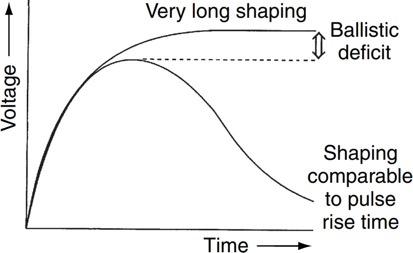
2.1 Ballistic Deficit
Ballistic deficit refers to the difference
63
Figure 1: Ballistic deficit between sufficiently long shaping time and a shaping time too similar to that of the pulse rise time (not shown) [1].
in pulse height between the exponentially decaying pulse from the preamp and the output of the pulse shaper (also called a filter), this of which will be described in more detail at the end of this section [1, 2]. This occurs when the peaking time of the shaped pulse, the time it takes for the pulse to reach its maximum value from the moment the charge collection process begins, is similar to the peaking time of the preamp’s pulse [3]. Figure 1 shows how a long shaping time provides an opportunity for the full charge to be processed by the filter while the shorter shaping process does not.
2.2 Signal to Noise Ratio
The signal-to-noise ratio (SNR) of a system with signal amplitude S and noise N is given by SNR=S2/(σN)2 where σN is the standard deviation of the noise [4]. The SNR affects the time and energy resolution of the signal and its subsequent analysis, with high SNR meaning clear, easy-to-read signals and low SNR meaning obscured, hard-to-distinguish signals.
2.3 Pulse Pile-Up
Pulse pile-up occurs when two or more pulses arrive from the preamp within the resolution time of the filter, or the total time required by the filter to complete its process. In these situations, the system cannot measure the heights correctly and the response of the system is corrupted. When two such pulses occur very close to one another, the system will not take the pulses as separate events and will instead take the sum of the first pulse and a portion of the second pulse [1, 2, 5]. This specific type of pulse pile-up is generally referred to as peak pile-up and can be seen in Figure 2.
2.4
Signal Filters
Put simply, digital signal processing (DSP) filters are a set of recursive math equations applied to sampled data from the signal in question that are designed to reduce the effects of these issues and allow for easier and more accurate analysis. Built into these equations are variables that allow for a trade-off between optimizing one of the above parameters while another becomes more prominent. For example, any filter’s peaking time must be greater than that of the preamp to remove ballistic deficit, and forcing an even greater
peaking time allows for a higher SNR. However, if pulses from the preamp are arriving quickly, then this large peaking time will result in peak pile-up. Applying these filters requires passing the signal from the preamp to an analog-to-digital converter (ADC) and processing the now digital signal in a field-programmable gate array (FPGA). The output is referred to as the “response” of the system (this kind of system will be referenced in the remainder of this paper).
This paper primarily details the development and testing of a simple trapezoid filter on open-source data acquisition (DAQ) hardware with additional discussion of relevant background information distributed throughout. For this process of development and testing, I relied on the Red Pitaya STEMlab 125-14 FPGA for its affordability, portability, expansion options, and remotely accessible user interface. The primary purpose of performing this development on such a device is to create a proof-of-concept design that establishes the viability of such a device in real-world data analysis applications wherein another DAQ device of greater cost and lesser flexibility would generally be used.

3.
A CRASH COURSE ON FPGAS
In the early 1990s, FPGAs were primarily used in the telecommunications industry, but they quickly solidified their spot in DSP in the early 2000s and eventually became a staple of DAQ instrumentation [6]. At face value,
64 Digital Signal Filtrators on Open-Source Field-Programmable Gate Arrays
Figure 2: Peak pile-up of closely timed pulses [5].
the function of an FPGA is to perform specific tasks or computations over and over. However, the architecture that allows these processes to occur is much less straightforward. Within an FPGA chip is a large network of small building blocks, called logic blocks, that are capable of performing a simple logic operation like adding or comparing two numbers. These blocks are all joined to one another by a network of wires, called interconnects, like a large mesh. These interconnects may be programmed to essentially wire the logic blocks in a certain sequence that allows them to work together and complete a complex task.
The term “program” is used loosely when referring to FPGAs as the configuration of logic block sequences is determined using hardware definition languages (HDLs) which are functionally different from (however, structurally similar to) software programming languages (SPLs) like C. More specifically, SPLs utilize the predefined network and functionality of CPUs to execute commands while HDLs restructure the hardware of an FPGA chip to perform a specific job repeatedly. For the STEMlab, the configuration is performed using the Xilinx Vivado application and a combination of intellectual property (IP) cores, a standardized set of HDL code that performs a specific task, and custom modules. Each configuration, called a project, has a corresponding bitstream, or a set of instructions understood by FPGAs, that is sent to the FPGA for implementation.
It is also important to understand why FPGAs are preferred when it comes to DSP and the difference in how they handle data compared to a CPU. FPGAs can establish connections and interact directly with interfaces, sensors, storage systems, displays, and other IOs, drastically reducing the latency of data movement compared to CPUs, which incur heavy processing costs to maintain communication with external equipment [7]. And while modern CPUs can execute several billion instructions per second across multiple cores, all executions within a CPU must be performed one-by-one sequentially, meaning any delay can result in corrupted information or missed timings of real-time data streams [8]. By contrast, an FPGA can perform many process-
es and computations in parallel, streamlining data processing, storage, and distribution, and in some use cases exceeding the throughput of CPUs by nearly 150x [7].
4. TRAPEZOID FILTER
The trapezoid filter, aptly named for the shape of the filter’s response, is designed to process an exponentially decaying pulse of the form V(t)=Voe(-t/τ), where V(t) is the input pulse at time t, Vo=V(0) is the initial pulse amplitude, and τ is the corresponding time constant. First introduced by Valentin T. Jordanov and Glenn F. Knoll in 1994, the trapezoid filter operates by convolving an incoming exponential pulse and the trapezoidal shaper: a combination of a rectangular function and two unit-slope truncated ramp functions, each at different offsets and delays [9].

Mathematically, the output of the trapezoidal system can be determined in terms of the sampled input pulse as where Y [n] is the filter response, the function aK,L[n] is given by
and the multiplication factor M by

For values of τ/Tclk>5, M can be approximated as M≈τ/Tclk-0.5 [10].
In Eq. 2, X[n] is the sampled input pulse, and K and L are delays such that X[n − K] is the sampled input pulse at a time K units after n [2, 9]. The lesser value of K or L is the duration of the rising and falling edges of the trapezoidal output, and the length of the flat top is given by m = |L − K| (where if L = K, the system results in a triangular shape) [2, 9]. For consistency, all of my project designs and tests maintain values of K and L such that K ≤ L, and therefore, K is the duration of the rising and falling edges and L determines the length of the flat top. Of course, choosing your parameters to be oppositely defined (i.e., L ≤ K) does not change the results of the filter and is only a matter of preference and consistency.
65
A careful balance of the delays allows for the optimization of the parameters discussed in the previous section. A shorter rise/fall time allows for quicker pulse processing and a higher pulse count rate, thereby reducing pulse pileup, while a longer rise time improves the SNR by taking a larger sample size [2]. Likewise, the effects of ballistic deficit can be mitigated by ensuring the duration of the flat top m is greater than the peaking time of the preamp [2, 3].
5. DIGITAL IMPLEMENTAITON OF THE TRAPEZOID FILTER
Throughout this section, I will frequently refer to the Python and Verilog modules I have developed. For the sake of convenience and organization, I have constructed a GitHub repository that contains all the up-to-date information which can be accessed at https:// github.com/sslerose/RedPitaya-DSP.
5.1 Verilog Basics
Before discussing the construction of the module itself, it is important to understand the data types and assignments of Verilog: parameter: A constant value within the module. Can be changed when instantiating the module.
input/output[b:a]: An input or output of the module with bits numbered a to b from right to left. a is called the least significant bit (LSB) and b the most significant bit (MSB). wire: An interconnect between two parts of a module and the default data type of inputs and outputs. Must be driven by a continuous assignment of data (using an input/output or assign statement) which is stored for a single clock cycle.
register: (reg) A data storage element that maintains its data value until it is reassigned using a blocking or non-blocking assignment. blocking assignment (=): Used in assigning values to registers sequentially. non-blocking assignment (<=): Used to schedule the assignment of values to registers without preventing succeeding statements from executing.
5.2 Design Considerations
The goal for applying the trapezoid filter digitally was to develop a high-performance
and resource-efficient Verilog module that could be integrated into the existing architecture of the STEMlab FPGA. As a visual aid for this process, the trapezoid filter can be represented by the block diagram in Figure 3. In the context of DSP, the block diagram depicts the flow of data from a sampled signal where the data present before each block is processed simultaneously after a given period [2]. Data samples from the preamp arrive at the left of the diagram where each sample is given by X[n]. Each sample and subsequent result travels along the wires to the next block, where at wire junctions the data travels simultaneously along both. One can think of this procedure like a constant stream of manufacturing products being passed through machines on a conveyor belt where each machine acts on its respective product at the same time.
5.2.1 Filter Arithmetic
The first design consideration was to optimize the filter arithmetic such that it could be more easily employed on the FPGA. According to Jordanov and Knoll, Eq.1 can be broken down into

where b[n] and Y [n] represent the output of the accumulators and c[n] the adder/multiplier in the block diagram below [10].
Furthermore, the multi-operation delay line aK,L[n] (Eq. 2) can be split into two singleoperation delay lines (or subtractors), the first being an intermediate equation given by
and the second being a redefinition of Eq. (2) given by
This secondary breakdown reduces the number of data buffers and arithmetic operations from three to two, lightening the hardware utilization. Consequently, equations 4 - 8 now follow the structure of the block diagram in Figure 3.
66
Digital Signal Filtrators on Open-Source Field-Programmable Gate Arrays
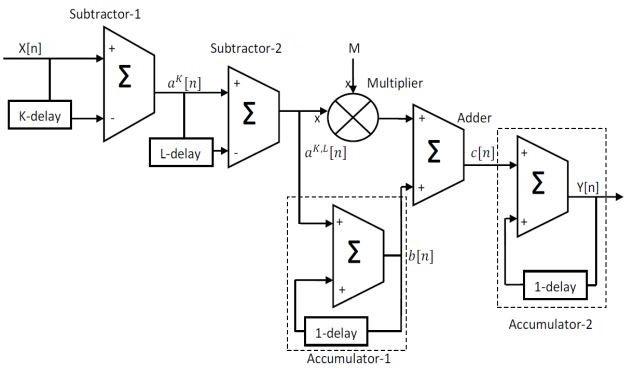
5.2.2 Temporary Storage (Ring Buffers)
The second consideration was to choose an efficient method of temporary data storage, called a buffer, for the delays in Eqs. 7 and 8. For this process, I opted to use a ring buffer due to its low memory usage and relative simplicity. In a typical ring buffer, read and write commands are enabled as needed, and the distance between the read and write locations is varied, resulting in a very flexible data storage method. A common flaw occurs when ring buffers have insufficient size, resulting in the potential for old data to be overwritten before it is read, causing data corruption. However, this buffer maintains a constant distance between read and write (given by the values of K and L), meaning this shortcoming was not of concern for use in the filter so long as the buffer had a greater number of addressable locations than the value of L (remembering K ≤ L).
5.2.3 Data Extraction
The final consideration was the method by which to extract the peak value as determined by the trapezoid filter. To avoid extraction from the edges of the flattop, which are rounded when a pulse has non-zero rise time (see Figure 4), and to reduce the probability of extracting a large peak caused by noise, which would occur if one simply looked for the greatest value of the response, it is best to choose the middle-most value of the filter’s flattop. Knowing the flattop has length m = L − K and the length of the rising and falling edges is given by K, the middle is then given by 2K+m=(K+L)/2. Additionally, peak detection should only occur when the incoming signal has passed a given threshold, thus indicating
that the incoming signal is above the standard noise levels and a pulse is being processed. Neglecting this threshold will lead to erroneous values that correspond to noise peaks rather than pulse peaks.

5.3 Python Simulation
To test the correctness of my Verilog modules, I created one Python module (trap_ filter) that modeled the trapezoid filter and another (e_exp_decay) that constructed arrays of simulated exponentially decaying data which could be fed to the filter module.
Given I was not constrained by hardware limitations or the rigidity of the Verilog language, I was able to use Eqs. 2 and 4 directly for the delay line and first accumulator, respectively, employing the “roll” function from the “Numpy” Python package for the individual delays, and then combining Eqs. 5 and 6 for the second accumulator. The respective inputs and outputs are listed at the top of these modules in the repository.
When working with the filter module, I found that the peak of the filter response was scaled up compared to the peak of the exponential input, but that Jordanov and Knoll’s publication did not explicitly mention a scaling factor. According to a WordPress article by “GoLuckyRyan”, the trapezoidal output should be divided by a factor of KM to remove this gain [11]. When I tested this assertion using my Python simulation, I observed a one-to-one linear relationship between the gain of the filter and KM, yet there existed a non-zero y-intercept
67
Figure 3: Simple block diagram of convolution-based trapezoid filter [2].
Figure 4: Exponential pulse with a non-zero rise time.
within this relationship that was consistently equal to the value of K. When examining this new relationship between the gain and K(M +1), the slope was linear and the y-intercept was zero. Therefore, Eq. 1 should be redefined as

The recursive equation cannot be redefined in the same manner as the recursion depends on this gain for correctness, so Eq. 6 must stay as is. This gain was accounted for in a future Python program that interfaces with the FPGA, which is discussed later in the paper.
5.4 Verilog Modules
The bulk of the remaining development was spent creating the Verilog modules themselves, these of which have the same name as the Python modules as they perform the same job. The design and testing were performed using Intel ModelSim rather than Vivado as I needed only to make a controlling Verilog module rather than a behavioral script to assess the filter and buffer modules. In actuality, Vivado could have been used as the sole program for design and testing, but this would have required knowledge of C programming and hardware behavioral script structure.
Because my goal was to port the simulated modules onto an FPGA, I chose to use the requisite FPGA components that are not necessarily required within ModelSim: clk: Input timing interface controlling the sychronous execution of modules ancores in Vivado.
aresetn: Active low reset argument used to bring a core or module to its initial state.
s_axis_tdata AXI-Stream (AXIS) slave interface: used to receive data as a sequential stream.
m_axis_tdata AXIS master interface: that is used to send data as a sequential stream.*
The STEMlab’s ADC converts two 14bit wide analog signals into a combined 32-bit
wide AXIS signal: m_axis_tdata=[{16-bit IN2},{16-bit IN1}]. Because the filter is designed for a single signal, it need only take the 16 lower order bits from the ADC. The parameter for this value (AXIS_TDATA_WIDTH) that heads each module exists for convenience and ease of modification.
5.4.1 Exponential Decay Generator
The input-output (IO) of the e_exp_decay module contains a pulse amplitude, decay factor, trigger, and AXIS master that sends the digital exponential pulse. For the sake of simplicity and testing, the exponentially decaying pulse contains no noise and no rise time. In a real-world scenario, noise and rise time is always present, and the trapezoid filter is designed to remove noise and simplify the shape of exponential pulses. However, creating noisy signals with no defined amplitude is not convenient for testing correctness. When triggered, the module calculates the pulse using fixed-point† recursive multiplication (FPM), and outputs using the AXIS interface. For the case of the STEMlab, its ADC/ DAC is 14 bits wide, so to create an exponentially decaying signal of e(-t/τ)‡, the decay factor should be calculated as
where the round function simple rounds the value to the nearest whole number and τ is the decay rate constant. At the trigger, the current value (current_value) of the exponential pulse is populated with the initial pulse amplitude. Afterward, an intermediate register is used to handle the multiplication of the current value and the decay factor, where the successive value is determined by dividing the intermediate register by 214 using a right-bit shift. As a mathematical recursive equation, this process is given by
It should be noted that ModelSim can utilize the $exp function to calculate V[n]= V0 e(-t/τ) and avoid FPM. However, the $exp
*The terms master and slave are rather crass in modern times, but this terminology is standard. As would be expected, a master interface controls a slave interface, often in the form of data transfer.
†A method of allowing non-integer multiplication in binary values. Because a binary register cannot hold a decimal value, the decimal value should be scaled, the multiplication be performed, and then the result be descaled.
‡In the case of digital logic, the values of τ and t are given in units of Tclk. As such, M from Eq. 3 can be reduced to M = τ − 0.5.
68
Digital Signal Filtrators on Open-Source Field-Programmable Gate Arrays
function is not implementable on hardware, thus necessitating the fixed-point method. Initially, I tested the trapezoidal filtration project using the $exp value and verified the correctness of the filtering module (trap_filter) using the previously discussed Python program. After this verification process, I switched to the fixed-point method to more easily understand the method implemented on the FPGA.
5.4.2
Pulse Generator
The IO of the pulse generator (pulse_ gen) module contains an incoming trigger and outgoing pulse. When the pulse generator is triggered (i.e., turned on), it generates a single clock cycle high signal that forces the exponential decay generator to produce a single pulse of its exponential signal. Including this module allowed for easier handling when commanding the FPGA and prevents multiple pulses from occurring in series.
5.4.3 Ring Buffer
The IO of the ring buffer (ring_buffer) module contains read and write controllers, delay value, data to write to the buffer, and data to read from the buffer. The buffer itself is constructed with BUFFER LENGTH addressable locations, each of which is a register of width equal to the AXIS width. I also established clog2(BUFFER_LENGTH)-bit* wide write and read pointer registers (wr_ptr and rd_ptr, respectively), the widths of which are selected to allow the maximum value of the pointers to index the last location of the buffer.
To traverse through the ring buffer, wr_ ptr is iterated by one at each clock cycle. Once wr_ptr reaches its maximum value, the next iteration will force the pointer to experience binary overflow and the value to be set to zero. rd_ptr follows a similar pattern at the overflow boundary, but in the opposite direction using 2’s complement†, a method of writing negative numbers in binary. Any negative number is simply the 2’s complement of its positive value, so when dealing with subtraction we find A − B = A + [2Comp.(B)]. Figure 5 depicts an example of this process. Note that rd_ptr contains a +2 within the module. This is
present to remove the inherent delays caused by data transfer between each clock cycle and was primarily discovered through trial and error.
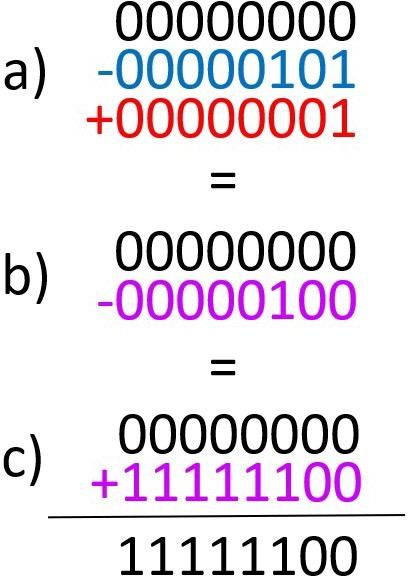
5.4.4 Trapezoid Filter
The filtering module (trap_filter) contains an AXIS slave that receives an incoming signal and a master that sends the outgoing filter response. The remaining IO is for the Kand L-delays and the multiplication factor M. Two wires exist to interface with the ring-buffer module for the delay lines (Eqs. 7 and 8) and registers are defined for handling the data of Eqs. 4 - 8. Another set of registers exists to handle the ring buffers where the buffer instances themselves are defined afterward. An always block manages the operations of the filter module as well as resetting all registers when prompted. The buffers for the K- and L-delay lines (Eqs. 7 and 8) have their reading and writing enabled based on the value of the buffer iterate (buff_iterate) register such that neither is reading from an empty memory location. Once the buffer for the L-delay line has valid data being read and transferred, the filter arithmetic begins.
The filter module executes Eqs. 4 - 8 with the following Verilog arithmetic:

*The function clog2, or ”the ceiling of log base 2”, takes the log base 2 of a value and rounds the value up to the nearest integer.
†To convert a binary number to its 2’s complement, swap all 1s to 0s, and vice versa, then add 1 to the result.
69
Figure 5: Bit overflow example. Here, (a) is the initial state, (b) is the reduction to A − B, and (c) is the final reduction to A + [2Comp.(B)]
This arithmetic is specifically designed to follow the flow of data in the block design of Figure 3, and as such I have broken Eq. 5 into Eqs. 14 and 15. This splitting does not affect the result of the filter and was added solely for organization and consistency.
When an incoming signal is constant (or near constant for noisy data), Eq. 12 equates to zero (or near zero for noisy data), resulting in the remaining equations also trending around zero. This property of the trapezoid filter’s first delay line allows for baseline removal, ensuring the peak of the filter response is always measured from near zero.
5.4.5 Peak Detector
Based on the considerations in Section 5.2, the peak detector (peak_detector) module has IO consisting of an AXIS slave to receive the filter response and inputs for the values of a threshold and the K- and L-delays. To extract the middle-most value as discussed in the aforementioned section, the module waits until the incoming filter response passes a given threshold and then waits until the middle-most point in the response to record its value.
5.5 Vivado Project and Jupyter Notebook
To program the STEMlab FPGA, I created a Vivado project designed to generate a simulated exponential pulse, perform trapezoidal filtration on the pulse, and analyze the filter’s response. Within my GitHub repository, I also created an automatic script that performs the entire building process of the filter project, including producing outside port connections that interface with the other hardware components of the STEMlab, adding Xilinx and Red Pitaya IP cores that control data flow and timing, adding the custom modules discussed above*, and establishing the proper wiring (or data flow connections) for the ports, cores, and modules. The script does not automatically generate the bitstream necessary to command the STEMlab, but this allows for an end user to view and edit the project before beginning that process.
The two predominant cores and con-
nections of the project are those of the general-purpose input/output (GPIO). Each GPIO core was given an address and connected to the processing system, allowing communication between the filter running on the FPGA and a Jupyter Notebook running on the CPU, the latter of which is managed through a local browser connection (via Chrome, Edge, Opera, etc.) to the STEMlab.
The Python program within the Jupyter Notebook (trap_nb) is responsible for setting the parameters of the signal generator, filter, and detector modules, and reading back the peak value from the latter. Given each IO connection of the GPIO cores are a maximum of 32 bits wide, the parameters (which have widths much less than 32 bits) can be strung together such that certain sections of the 32-bit wide connection contain a specific parameter which can be extracted before arriving to its respective destination. For example, the trap_gpio core has its first 30-bit output gpio1_data assigned as gpio1_data=[{14-bit Kdelay},{14-bit Ldelay},{2-bit reset}], so extracting the 14 leftmost (or most significant) bits will yield the value of the K-delay used in the trapezoid filter module.
6. RESULTS
Using the Jupyter Notebook program, I initially generated an exponentially decaying pulse with a signal amplitude of 1,000** and a time constant of 10 samples, or 80ns given the STEMlab runs at 125M samples per second. The filter was then assigned values of K=10, L=15, and M=10, and the peak detector
The 2-bit reset control within the gpio1_data output of trap_gpio is used to reset the custom modules, which is imperative to proper filter function in the situation that the parameters of the modules are changed. In its initial state, the 2-bit reset is zero and the modules are in a state of reset (known as active-low), so data is not being processed. Adding one to gpio1_data takes these modules out of reset, effectively starting the filter process. This same process is performed for the peak_gpio core to trigger the signal generator, except its trigger is active-high. * Because the ring buffer modules are instantiated within the filter module, they do not have an associated block in the project and are instead embedded within the filter’s block.
70
Digital Signal Filtrators on Open-Source Field-Programmable Gate Arrays
was given a threshold value of 1000. After the filter was triggered by the pulse, a peak filter response of 996.429 was recorded, meaning the trapezoid filter resulted in an error of approximately -0.357%.
To test whether this error was consistent for multiple different exponential pulse amplitudes, I created a set of pulses with amplitudes from 1000 to 16,000 in increments of 500 while keeping the time constant at 10. I performed the same test as described above with each value, and the plot of the peak of the generated exponential pulses versus their respective percent error in the filter’s response can be seen in Figure 6. Based on the graph, it can be observed that the error initially increases with respect to the value of the pulse amplitude, but then roughly levels off around 0. However, during testing, I found that the error in the response peak increased with respect to the length of the K-delay on the FPGA, but not within the Python simulation.
Qualitatively, the user experience when working with the Notebook program was rather cumbersome and difficult to decipher without more advanced knowledge of binary arithmetic and the project as a whole. The project is also extremely limited in its ability to support meaningful analysis

6: Peak of generated exponentially decaying pulse versus the percent error in its respective filter response.
operating with extreme accuracy with the given parameters. The varying percent error from amplitude to amplitude at low values is likely due to the higher level of accuracy needed to calculate a proper response output that is not present in the current design (the design may not use decimal values for increased accuracy due to the fixed binary system). However, the exact reason for the increasing error with respect to the value of K is unknown, and more testing is necessary to draw a conclusion. To remedy the former issue, decimal arithmetic should be added to the design. In conjunction, developing a method of displaying the complete pulse and filter response as processed by the FPGA is imperative. Without the ability to compare the peak detector output to a waveform, no system of checks can be taken to ensure proper data acquisition.
As of early 2024, the Red Pitaya team introduced full-release builds of a new operating system for the STEMLab that allows for full control of and access to the STEMlab’s signal acquisition and generation, and deep memory storage. After some preliminary analysis of the source code for the builds and discussions with the Red Pitaya team, it seems possible to add my filter module and its dependencies as an intermediate data processor between the signal acquisition and its output into the STEMlab’s oscilloscope application. If successful, this would allow for the filtered waveform to be analyzed interactively, allowing for more detailed analysis and a more streamlined user experience.
7. CONCLUSION AND NEXT STEPS
The results from the previous section, while limited, are promising and indicate that the filtering project running on the STEMlab is
**The STEMlab’s ADC has a resolution of 14 bits, so the decimal value of the amplitude can have values between 0 and 16383 corresponding to voltage values of 0V to 1V.
71
Figure
REFERENCES
1. G. R. Gilmore, Practical Gamma-ray Spectrometry, 2nd ed. (2008).
2. K. Pathak and D. S. Agrawal, “VHDL Simulation of Trapezoidal Filter for Digital Nuclear Spectroscopy systems”, International Journal of Scientific and Research Publications 5 (2015).
3. A. Buttacavoli, F. Principato, G. Gerardi, M. Bettelli, A. Zappettini, P. Seller, M. C. Veale, S. Zanettini, and L. Abbene, “Ballistic Deficit Pulse Processing in Cadmium- Zinc-Telluride Pixel Detectors for High Flux X-ray Measurements”, Sensors 22, https://doi.org/10.3390/ s22093409 (2022).
4. G. Czanner, S. V. Sarma, D. Ba, U. Eden, W. Wu, E. Eskandar, H. Lim, S. Temereanca,W. Suzuki, and E. Brown, “Measuring the signal-to-noise ratio of a neuron”, Proceedings of the National Academy of Sciences of the United States of America, 7141–7146 (2015).
5. A. Patil, “Dead time and count loss determination for radiation detection systems in high count rate applications” (Missouri University of Science and Technology, 2010).
6. J. Eyre, “FPGA/DSP Blend Tackles Telecom Apps”, Electronic Engineering Times (2002).
7. A. Sanaullah, C. Yang, Y. Alexeev, K. Yoshii, and M. C. Herbordt, “Real-time data analysis for medical diagnosis using FPGA-accelerated neural networks”, BMC Bioinformatics 19, https://doi.org/10.1186/s12859-018-2505-7 (2018).
8. S. Sirois, What is Processor Speed and Why Does It Matter?, https://www.hp.com/usen/ shop/tech-takes/what-is-processor-speed (visited on 05/26/2023).
9. V. T. Jordanov and G. F. Knoll, “Digital synthesis of pulse shapes in real time for high resolution radiation spectroscopy”, Nuclear Instruments and Methods in Physics Research 345, 337–345 (1994).
10. V. T. Jordanov, G. F. Knoll, A. C. Huber, and J. A. Pantazis, “Digital techniques for real-time pulse shaping in radiation measurements”, Nuclear Instruments and Methods in Physics Research 353, 261–264 (1994).
11. GoLuckyRyan, Trapezoid filter, https://nukephysik101.wordpress.com/2020/03/ 20/ trapezoid-filter/ (visited on 07/28/2023).
72
Digital Signal Filtrators on Open-Source Field-Programmable Gate Arrays
TOBACCO FARMING AND DEMON
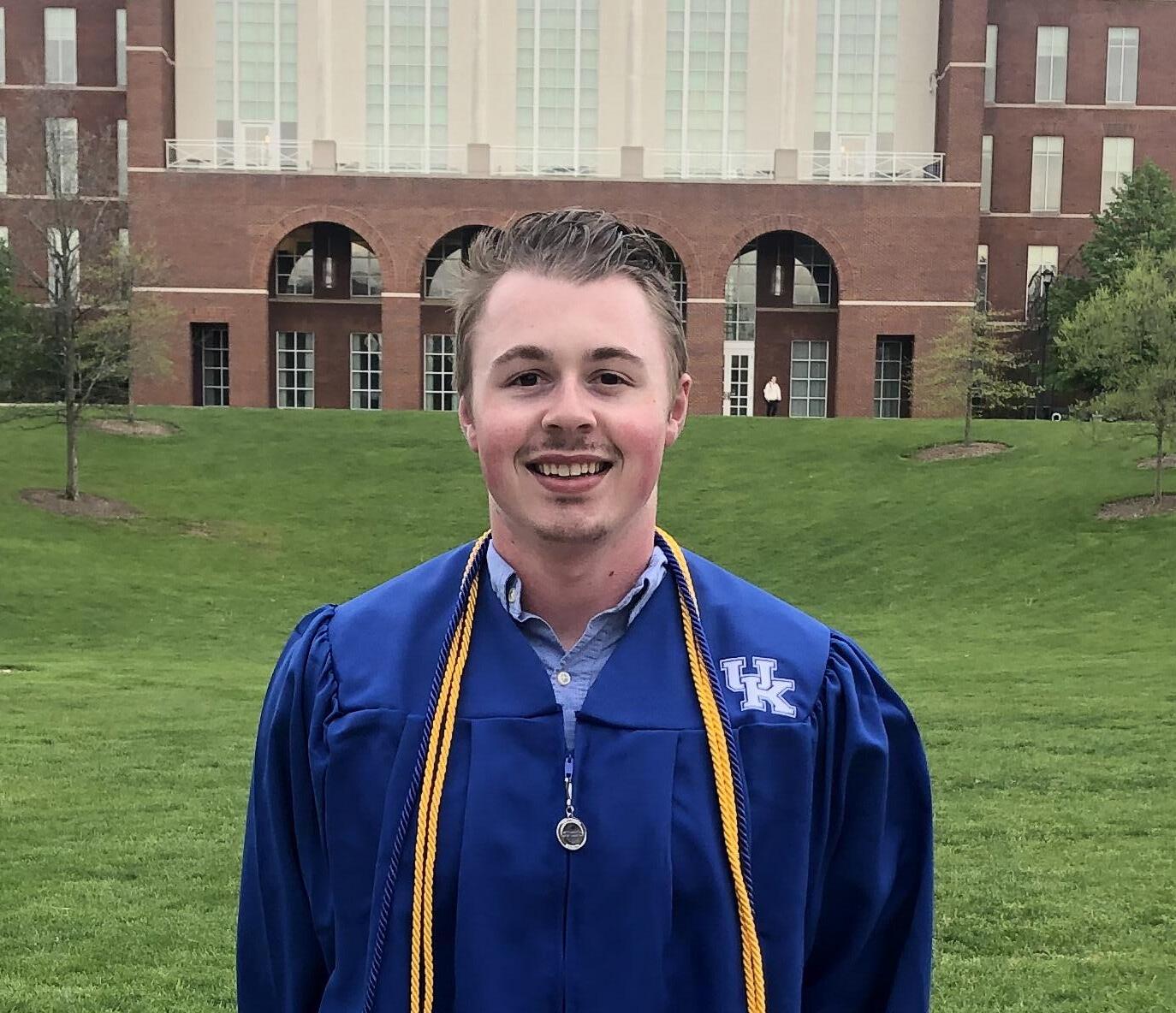
COPPERHEAD 73
FARMING IN APPALACHIA COPPERHEAD
JOSHUA HINTON
Joshua Hinton is a lifelong Lexingtonian who earned dual degrees in English and political science from the University of Kentucky. Hinton is a die-hard UK football, basketball, and baseball fan. His research interests include Appalachian America and the U.S. South, U.S. electoral politics, and COVID-19 pandemic policy. After graduating from UK as a member of the class of 2024, he will be a J.D. candidate at Emory Law (‘27).
74
TOBACCO FARMING IN APPALACHIA AND DEMON COPPERHEAD
Joshua Hinton & Dr. Michelle Sizemore
ABSTRACT
TEX This research paper examines Barbara Kingsolver’s Demon Copperhead, a Pulitzer-winning novel with minimal existing scholarly literature, in the context of tobacco farming in Appalachia. Kingsolver’s “Great Appalachian novel” exposes the lives of Appalachians to a national audience. A contemporary take on Charles Dickens’ David Copperfield, Demon Copperhead tackles a wide range of socio-political issues in the region, from intergenerational poverty to the opioid crisis. Through the title character’s childhood and adolescent journey, Kingsolver illustrates that not only Appalachian children are set up to fail without a fair shot at life, but also Appalachian adults are routinely undermined and degraded. While these challenges are most evident in Demon’s experience, I argue that the experience of an ancillary character, Mr. Creaky, grants unique insight into the particular hardships facing small Appalachian tobacco farms as the combination of unsustainable economics and recent federal law have created the near-extinction of small tobacco farms.
INTRODUCTION
Barbara Kingsolver’s Demon Copperhead is a contemporary literary classic that underscores the harsh sociopolitical, cultural, and economic realities facing Appalachian America. Having won the 2023 Pulitzer Prize for Fiction, the novel follows its title character’s childhood journey throughout the foster care system in western Virginia. Demon Copperhead encounters drug abuse and opioid addiction, physical and mental abuse within foster care, and depression when trying to please his many foster ‘parents.’ Demon’s experience included – but was not limited to – exposure to prostitution and theft at a truck stop, dependence on opioids when rehabbing a brutal knee injury, and poor academic performance within a failing public high school.
In Demon Copperhead, Kingsolver crafts a modern interpretation of Charles Dickens’ David Copperfield to illustrate the detrimental impact of generational poverty, underperforming schools, and the opioid epidemic in Southern Appalachia. These factors are intertwined in Kingsolver’s great Appalachian novel to depict life within the region. Appalachian characters face an uphill climb throughout the novel, which highlights stories often disregarded by
the national audience and illustrates a case study as to how children can be set up to fail without receiving a fair shot at prosperity. Specifically, this uphill climb is present when the title character is placed into foster care on Mr. Creaky’s tobacco farm.
While Demon’s tenure on the farm is far from the only example of being betrayed by adults, the impact of this experience lingers throughout the novel; years after leaving, Demon reflects on his time at Creaky’s farm and fantasizes about it going out of business. On the surface, this experience is meant to offer significant insight into the exploitative nature of the foster care system. While Demon’s time on the farm is undeniably exploitative, this segment of the novel is not relegated purely to conveying the exploitation of foster children. Rather, this example underscores layers inherent to Appalachian life that might not initially reveal themselves. Specifically, the financial realities of small Appalachian tobacco farms serve as a medium by which Kingsolver opines on the Appalachian condition. Indeed, throughout the novel, it is not always the major plot points that underscore the depths of addiction and Appalachian exploitation, but rath-
75
er the perpetual mundane visible in everyday settings, and tobacco farming in Appalachia is one such example.
In Demon Copperhead, Barbara Kingsolver depicts how small Appalachian tobacco farmers face specific and unique economic adversity, granting clarity into characters’ relationships as well as furthering the notion that the Appalachian condition is perpetually overlooked and disregarded by those who wield political and cultural power. This effect is twofold: not only does it contextualize Creaky such that the reader gains a greater appreciation of his plight, but it also emphasizes that Appalachians are pushed to the bottom of the national socio-economic hierarchy, which informs the cyclical nature of abuse in the region.
HISTORY OF APPALACHIAN TOBACCO FARMING
Understanding the dynamic of life in this region relies first on defining and categorizing Appalachian identity. Appalachia is extraordinarily broad and encompasses northwestern Georgia and South Carolina; eastern Kentucky, Ohio, and Tennessee; western North Carolina and Virginia; most of Pennsylvania; and all of West Virginia (About the Appalachian Region). Appalachian culturalism – a term that defines “Appalachia as a cultural unity” and not “the large region associated with” the geographic categorization – consists specifically of “western North and South Carolina, eastern Tennessee and Kentucky, and most of southern West Virginia” (Lohmann 80). Thomas Ford, a sociologist who commissioned a cultural survey to provide a specific quantification of the region, and William G. Frost, the former president of Berea College who coined the phrase “Appalachian American,” also considered counties in western Virginia essential to the understanding of Appalachian culturalism (Lewis and Billings 13-14; Raitz 19).
Tobacco farming in Appalachia most directly overlaps with the regions reflecting Appalachian culturalism, which includes the
geographic mid-South. All five major tobacco growing states in the United States – Kentucky, North Carolina, South Carolina, Tennessee, and Virginia – are Appalachian (Fallin and Glantz 320). What is more, tobacco farming in these states specifically occurs within their respective Appalachian regions. An aggregation of tobacco farms in the mid-South from The Washington Post found that tobacco farms primarily lie in central and eastern Kentucky and Tennessee and western North Carolina and Virginia – a direct overlap with the Appalachian regions of these states (Wilson).
A combination of the unique geography and topography of mid-South Appalachian America and the 1938 Agricultural Adjustment Act can explain this phenomenon. Because of the region’s “rocky and steep mountain[ous]” characteristics, tobacco was “one of the only cash crops sustainable” in Appalachia (Dunn). Dunn evidences that there exists “a triad of states” that “have long been the only place to produce burley [tobacco] – Kentucky, North Carolina, and Tennessee.” Additionally, he argues that it is common knowledge within the industry that the “product grown in” Appalachia is the “best” tobacco “in the world” (Dunn). Appalachian tobacco farming exploded in prominence in large part due to the 1938 Agricultural Adjustment Act. This Act was part of President Franklin D. Roosevelt’s New Deal program, which set government caps on the amount of product that could be grown by a given farm and paid farmers a subsidy as compensation. Indeed, this piece of legislation allowed the federal government to establish and “control the production of agricultural commodities and to stabilize farm income,” including cash crop products such as tobacco (F.F.R. 915). In practice, this law allowed the federal government to artificially cap individual farmers’ production of tobacco, restricting the free market and, by extension, creating the conditions necessary for Appalachian farmers to thrive. This legal framework was in place until 2004 when the U.S. Congress passed the American Jobs Creation Act.
The American Jobs Creation Act federally deregulated tobacco through its Fair and Equitable Tobacco Reform Act provisions. This
76
Tobacco Farming in Appalachia and Demon Copperhead
act included a “tobacco buyout program” provision that “abolished government price supports and production controls for tobacco,” and eliminated the federal subsidies that paid “farmers to stop growing the crop” (Hart 447). Indeed, this bipartisan legislation, which was passed by the U.S. Congress before the 2004 midterm elections and subsequently signed into law by President George W. Bush, permanently diminished the business model in place for small tobacco farmers. This legislation resulted in the full unleashing of market forces on domestic tobacco, allowing larger farms to increase production and profitability. As geographer John Fraser Hart noted, this law does not intend “to terminate tobacco production once and for all,” but instead will “probably … eliminate only the smallest and least competitive growers” and “encourage those farmers who wish to continue growing the crop to grow more of it.” He concludes by noting that “the removal of the government safety net of price supports places them at the mercy of the free market—or enables them to take full advantage” (Hart 447).
Hart’s prediction was prophetic – the “number of tobacco farmers plunged by 51.5% in the year after the legislation took effect” (Bomey). Because “farmers decided they could” no longer “sell tobacco at a profit” without the federal government “limiting production and imposing an artificially high price,” many left the industry. This most directly impacted the large quantity of small farmers who were disproportionally located within Appalachia. U.S. Agricultural Census data recognizes that “[m]ost of the farmers who exited the tobacco business were small” farmers. Merely a decade after the legislation was passed, there was a dramatic decrease in the number of farmers from over 50,000 to less than 5,000 – a tenfold decline in farms that grew tobacco (Bomey).
TOBACCO FARMING IN DEMON
COPPERHEAD
This context surrounding Appalachian tobacco farming and the Appalachian experience in America established the preconditions portrayed throughout Demon Copperhead. In the early portions of the novel, Demon’s mother overdoses and enters an in-patient rehabilitation facility. Demon refused to live alone with his mother’s abusive boyfriend – a choice no reader can fault him for making – and was assigned to foster care where he was sent to work on a small tobacco farm. On this farm, Demon learns the grueling reality of life as a tobacco farmer. Demon was frequently pulled out of elementary school, perpetually underfed and malnourished, and psychologically manipulated and abused while on the farm. It becomes evident that Creaky had no interest in fostering children outside the utilitarian value provided by a free laborer and a $500 monthly check from the government. Kingsolver alludes to several financial obstacles Creaky faces while managing his farm. While the exact nature of this is obfuscated by Demon’s limited understanding and narration style, it is clear Creaky struggles to get his product to market on time and achieve profitability.
At the onset of this section, the audience is introduced to the small nature and rural setting of Creaky’s farm. Demon describes his first visit as one where he noticed one must turn “up the dirt lane” to enter the “old farmhouse with grass so high in the yard, you could cut it for hay” (Kingsolver 57-58). Immediately, Kingsolver notes the decrepit and unprofessional landscaping of the farm while also alluding to difficulty accessing the area – a common feature of a small Appalachian farm fighting an uphill, if not unwinnable, battle against large commercial tobacco farms.
Demon, in his narration, is quick to recognize this. He describes the farm’s layout as only having “three acres” of “land flat enough for plowing,” which is “about average size for a tobacco bottom” (96). Demon laments his experience on the farm, noting that the “real dog days if you are a kid on the farm are in September and October,” with tobacco work consisting of “suckering, topping, cutting, hanging, [and] stripping” – all by hand (96-97). He describes the process of breaking “off the tops
77
of all the thousands of plants that are head high or higher to a fifth grader” and “walk[ing] down the rows reaching up” (97). As Demon eloquently stated, “[t]hose plants will be all over all our heads before the season ends,” yet we still “have to be their masters” (97). After his first day, Demon recognizes that “tobacco is hard work,” but notes he had “seen nothing yet” comparatively (97).
Demon’s perspective on his experience as a tobacco farm laborer never truly shifts, as he takes joy from the fact that Creaky’s farm was ultimately an unsustainable business. After reuniting with a former ‘coworker’ on the farm, Demon is unbothered when learning that Creaky’s farm “ran itself into the ground some while ago,” noting that “[e]very minute of those days” on the farm “had sucked” (300). Years later, Demon would return to the abandoned barn, describing that he “enjoyed the place, on the few occasions” he went “back to plunder it” (366). Demon’s disdain for Creaky comes from a misconception that Creaky was a greedy farmer, when in actuality, he is barely surviving. Demon’s immaturity and unreliability as a narrator restricts his ability to understand that Creaky shared in the suffering associated with meeting demand.
It is swiftly evident to the reader that this is not a large farming operation, but rather one that is struggling to survive. Tobacco farming, an arduous and thankless practice for even its most profitable enterprises, is entirely about survival for Creaky. This labor-intensive endeavor is of the highest stakes for Creaky, as his livelihood is on the line daily. While Creaky does assume all of what little financial reward there is, he also assumes the totality of the risk; should the farm fail, Demon and his fellow laborers are not held responsible. This very scenario is borne out later in the novel, as Demon continues into his adolescence and young adult life well after Creaky’s farm was shuttered and the owner’s life left in doubt.
After first describing the arduous nature of tobacco labor, Demon grapples with the high stakes nature of the modern small tobacco farm lifestyle. He contextualizes his experience by explaining why it is essential to “keep on,” noting that “if a farmer fails to get
his crop in, he’s lost it all.” Indeed, Demon recognizes that “for farmers, it’s live or die” (100). In his sardonic narrative style, Demon subconsciously realizes the fundamental difference between the laborer and the farm owner. Here, Demon acknowledges that every tobacco season is a fight for Creaky’s life; if the right quantity of product is not brought to market at the exact time necessary, Creaky loses what little he does have. Demon would return home or back into the foster system, and his life would continue while the septuagenarian would have nothing to show for his many decades of thankless labor.
This explains why Creaky’s perpetual angst and aggression manifests in anger towards his foster-farmers. On the surface, Demon dismisses this as occurring purely because Creaky is an angry and bitter man. Yet, greater context and analysis reveal that every day, Creaky is fighting for his livelihood. Because of the financial realities of contemporary tobacco farming, Creaky’s modest farm stands no shot at long-term survival; less than two years after Demon’s time at the farm, Creaky has already lost his business. A full understanding of Creaky’s character necessitates that Demon’s narration, and by extension the audience, consider the layers inherent in their relationship. Because his perspective is drastically skewed as a child laborer, Demon cannot account for a broader perspective of tobacco farming or the history of the industry. Rather, in the moment, all Demon knows is the daily grind of farm labor, and this is what he relays to the audience. For the modern tobacco laborer, the stakes are restricted to layoffs or firings and pursuing the next job; for Creaky, and by extension, small Appalachian tobacco farmers writ large, there is no ‘next job.’ That is, while tobacco farming is necessarily labor intensive, it is only high stakes for those with everything to lose. Demon laments that a “tour of tobacco duty can feel like a season in hell, and you come back from it feeling like an army vet: proud, used up, messed up, wishing to be appreciated. And invisible” (100). However, he fails to apply this same logic to Creaky, who experiences the same feeling. Just as Demon was thrust into an uncontrollable and unwinnable situation as
78
Tobacco Farming in Appalachia and Demon Copperhead
an orphan and victim of circumstance, so too Creaky was set up to fail in that his farm simply cannot compete with large commercial tobacco farms in a post-bailout economy. Indeed, this dynamic facilitates the abuse inherent in modern-day tobacco farming in Appalachia, both for the laborer and the farm owner.
Kingsolver presents this such that thorough analysis reveals Creaky is simultaneously fighting an unwinnable battle with, and alongside, several children fighting their own unwinnable battles. Because this experience is narrated solely from Demon’s perspective, he fails to recognize or comprehend the scope of the economic reality facing Creaky. Kingsolver crafted these scenes at Creaky’s farm to convey a broader and deeper understanding of layered abuse inherent to Appalachian culture. It is swiftly apparent that Demon is exploited for free labor by Creaky and the foster care system. However, what requires contextualization, and a closer reading of the text, is that Creaky is also exploited and undervalued. His life is dedicated to Appalachian tobacco farming, a dying industry that does not yield substantial profit yet could yield economic and personal destruction any given year.
Creaky himself is being whittled by the harsh and unforgiving reality of tobacco farming in contemporary Appalachia. Just as Demon is fighting an unwinnable battle as a foster child trapped in poverty, so too Creaky fights an unwinnable battle with his small tobacco farm trying to compete with the larger commercial farms. This dynamic is lost upon the audience, which is solely reliant on Demon’s narration, because he is unable to fully grasp the scope of what is occurring. To no fault of his own, Demon is ignorant of the fact that the abuse and degradation he experiences is layered.
Creaky, in fighting a battle where market forces allow larger farms to dominate, is both a victim and perpetrator. Creaky takes this abuse out on Demon and all his fellow foster-laborers, so Demon doubly experiences the abuse. However, the layered nature is essential to understanding characters’ motivations and actions during Demon’s time on the farm. Demon’s depiction and subsequent behavior re-
flect that of a child who cannot fully appreciate the depth of exploitation and abuse inherent to tobacco farming as a child in Appalachia. It is unsurprising that this experience is miserable for all involved, and doubly so for the children, because of layered abuse: not only does the physical toll of this demanding work wear them down, but the mental and psychological toll of getting the necessary product to market in time also grinds down the boys.
Tobacco farming in Appalachia is also used throughout Demon Copperhead to convey a broader sociopolitical critique of contemporary life in Appalachia. Just as there exists zero margin for error in tobacco farming and getting product ready for the October sale, so too exists a broader Appalachian phenomenon that there exists zero margin for error relative to the rest of the American population. Indeed, this is encapsulated in the idea that exploitation is an undeniable factor of Appalachian life; not only in Demon, which is evident on the surface, but also through Creaky. Kingsolver employs Appalachian tobacco farming as the medium to illustrate that Appalachians are not presently afforded second chances or a level playing field; their success as individuals requires everything to go right and leaves zero room for error. The Appalachian citizen writ large is set up to fail and subsequently dehumanized and written off.
This portion of the novel functions as a case study providing the audience insight into the human cost associated with the decline of small Appalachian tobacco farms. From a strictly economic consideration, this is free market economics at work; over time, businesses naturally rise and fall, and the consumer benefits from cheaper tobacco. The businesses that successfully out-compete one another succeed, and less competitive enterprises fail. Now competing with large farms that can outproduce his small-scale operation, Creaky is relegated to employing foster children as laborers merely to get his product to the market. To the informed reader, it quickly becomes apparent that Creaky’s farm is struggling to meet the market demands because it physically cannot. This grants context to the scenes and explains how Kingsolver uses this
79
to argue that Appalachians cannot win; they are set up to fail.
Indeed, because the federal government stopped artificially propping up small farms and their farm owners, large farms were able to dominate the market. Creaky’s unwinnable battle can be traced back to the hurdles facing small Appalachian tobacco farmers which specifically originated as consequences of the 2004 Fair and Equitable Tobacco Reform Act. Once the federal government’s market controls were removed, the industry quickly corrected; small tobacco farms simply could not compete with larger farms. Without this government intervention, the Appalachian supply-side industry was havocked.
This context creates a sympathetic reading of Creaky that is often overlooked by the audience. While Demon’s narration posits Creaky as old and an irredeemable curmudgeon, a nuanced reading peels the layers of his character back and reveals why he deems it necessary to employ foster children as laborers. There exists little – if any – literary criticism or scholarship surrounding Demon Copperhead, and popular media book reviews often fail to recognize the depth inherent to Creaky’s character. Contextualization and an understanding of the modern tobacco farming industry allow one to understand that Creaky is not motivated by greed, as Demon portrays him, but rather by the fight for his livelihood.
CONCLUSION
Throughout Barbara Kingsolver’s Demon Copperhead, the contemporary Appalachian experience is reflected through a bildungsroman in which the title character’s journey throughout adolescence highlights the significant disadvantages facing Appalachians. A basic reading reveals several of these, including a broken foster care system, a lack of reliable public education, and an opioid epidemic ravaging the community. It also presents Demon’s exposure to poverty and domestic abuse as separate encounters. However, a close reading of the text paired with a deeper understanding of historical and sociopolitical context reveals this is intertwined.
Contemporary foster care, public education, and opioid addiction in Appalachia present the conditions necessary to expose children to the threat of poverty and abuse. Demon is placed into a broken foster care system after his mother’s drug overdose. He lands in an agrarian lifestyle that prioritizes labor over education, and since both the economic and educational systems in place uphold this perspective, Demon is removed from the classroom. Demon is subsequently exposed to poverty and abuse throughout his time on Creaky’s farm. A close reading of these scenes paired with historical context reveals that Creaky is not the greedy man Demon disdains, but rather a man struggling with the reality that his farm, and by extension himself, has been relegated from the tobacco farming industry. For Creaky, this reality justifies nearly any action necessary to save the farm, including the recruitment and employment of foster children as farm laborers. To the audience, this conveys that economic hardship, addiction, and broken systems propagate layered abuse. Indeed, this context serves to inform the audience’s understanding of both the sociopolitical and relational consequences of Appalachians being perpetually overlooked and disregarded through the case study of Creaky’s farm.
80
Tobacco Farming in Appalachia and Demon Copperhead
REFERENCES
• “About the Appalachian Region.” Health in Appalachia, https://healthinappalachia.org/appalachian-region/.
• Bomey, Nathan. “Thousands of farmers stopped growing tobacco after deregulation payouts.”
• USA Today, 2 Sept. 2015, https://www.usatoday.com/story/money/2015/09/02/thousands-farmers-stopped-growing-tobacco-after-deregulation-payouts/32115163/.
• Dunn, Colby. “Tobacco’s Golden Days.” Smoky Mountain Living Magazine, 1 Oct. 2011, https://www.smliv.com/stories/tobaccos-golden-days/.
• Fallin, Amanda, and Stanton A. Glantz. “Tobacco-Control Policies in Tobacco-Growing States: Where Tobacco Was King.” The Milbank Quarterly, vol. 93, no. 2, 2015, pp. 319–58. JSTOR, http://www.jstor.org/stable/24369855.
• F. F. R. “The Agricultural Adjustment Act of 1938.” Virginia Law Review, vol. 24, no. 8, 1938, pp. 914–19. JSTOR, https://doi.org/10.2307/1068087.
• Hart, John Fraser. “The Initial Impact of the Tobacco Buyout Program.” Geographical Review, vol. 101, no. 3, 2011, pp. 447–57. JSTOR, http://www.jstor.org/stable/41303645.
• Kingsolver, Barbara. Demon Copperhead. New York: HarperCollins, 2022.
• Lewis, Ronald L., and Dwight B. Billings. “Appalachian Culture and Economic Development: A Retrospective View on the Theory and Literature.” Journal of Appalachian Studies, vol. 3, no. 1, 1997, pp. 3–42. JSTOR, http://www.jstor.org/stable/43664361.
• Lohmann, Roger A. “Four Perspectives on Appalachian Culture and Poverty.” Journal of the Appalachian Studies Association, vol. 2, 1990, pp. 76–91. JSTOR, http://www.jstor.org/stable/41445586.
• Raitz, Karl B., et al. “Regional Definitions.” Appalachia: A Regional Geography: Land, People, and Development, 1st ed., Routledge, New York, 1984, pp. 9–35, https://doi-org.ezproxy. uky.edu/10.4324/9780429048302.
• Wilson, Reid. “The United States of smoking: The state with the most tobacco farms smokes most often.” The Washington Post, 14 Mar. 2014, https://www.washingtonpost.com/blogs/ govbeat/wp/2014/03/14/the-united-states-of-smoking-the-state-with-the-most-tobaccofarms-smokes-most-often/.
81
82


APERTURE UNIVERSITY OF KENTUCKY JOURNAL OF UNOERGRADUATE RESEARCH





























































